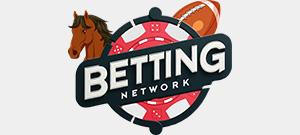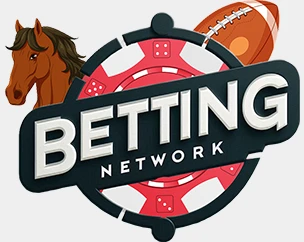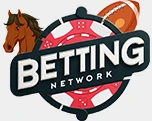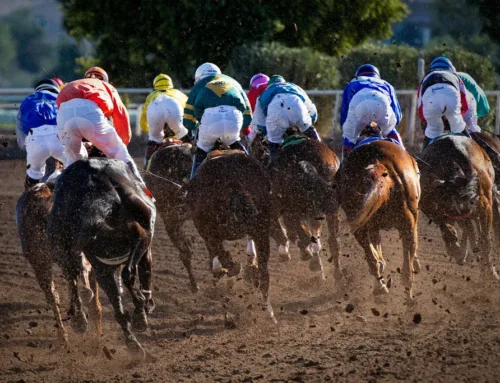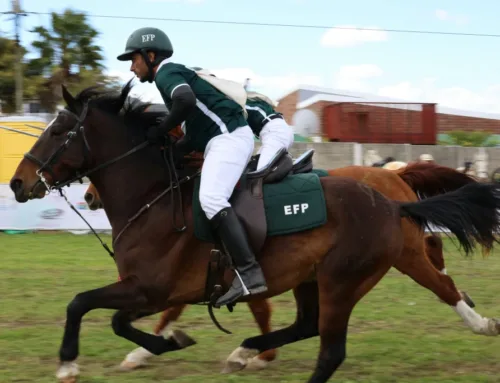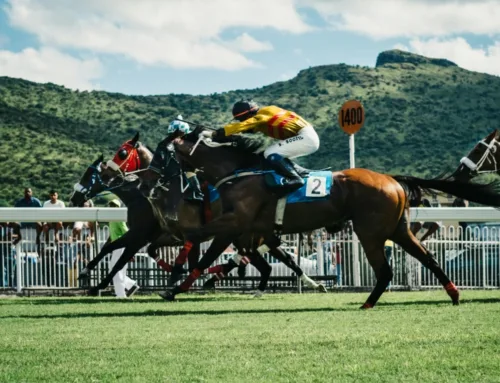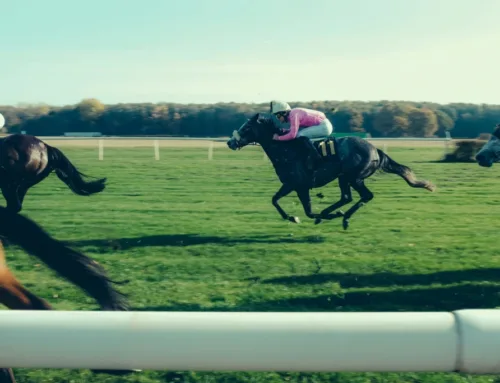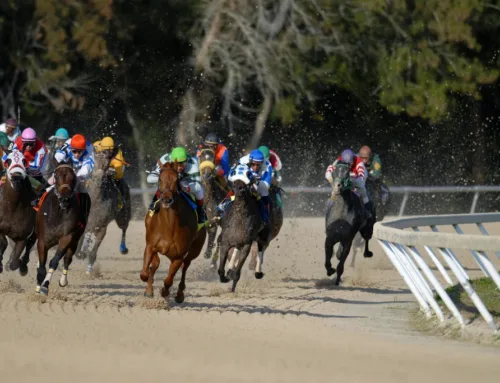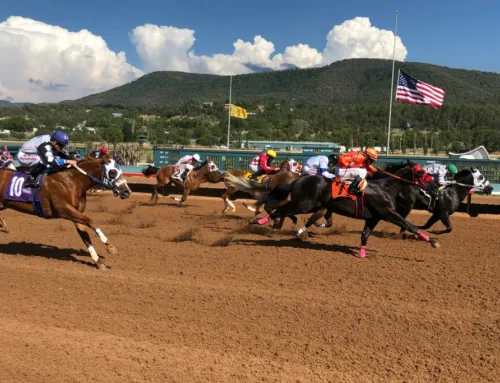There’s a very long list of horse racing betting terms you’ll need to know if you want to be a master of the tracks. Honestly, you’ll get the most value out of covering the fundamental terms and then building an index for the most specific ones.
We’ve organized everything to save you the troubles of going through 10 different sources for a technical, niche term.
Must-Know Horse Racing Betting Terms
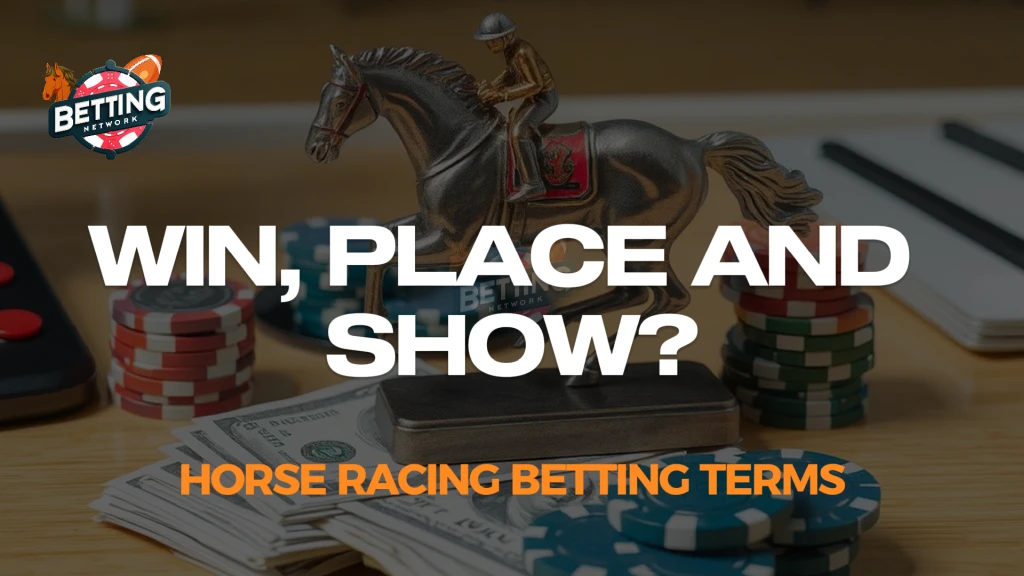
There’s a bit of nuance when it comes to Horse Racing Bets. Let’s start with “Win, Place, Show” which you’ll hear all the time in horse racing. The easiest, most simple way to bet on a horse race is to go for “Win, Place, Show”
Win is as simple as betting on a horse to come in first place. If your horse wins, you win the bet. On the other hand, Place has some more leeway: You bet on a horse to come in first or second place (If your horse finishes in either of those positions, you win the bet but the payout is usually less than a Win).
Last but not least, Show lets you bet on a horse to finish in the top three (first, second, or third). This type of bet offers the highest chance of winning but with the smallest payout.
Important Note
You can also bet “Across the Board,” which gives you multiple chances to win based on how well a given horse performs.
Let’s say that you place a Win, Place, and Show bet on the same horse: If the horse wins, you collect on all three bets. If it comes in second, you collect on the Place and Show bets. If it finishes third, you only collect on the Show bet.
Horse Racing Terms : Exacta, Trifecta and Superfecta
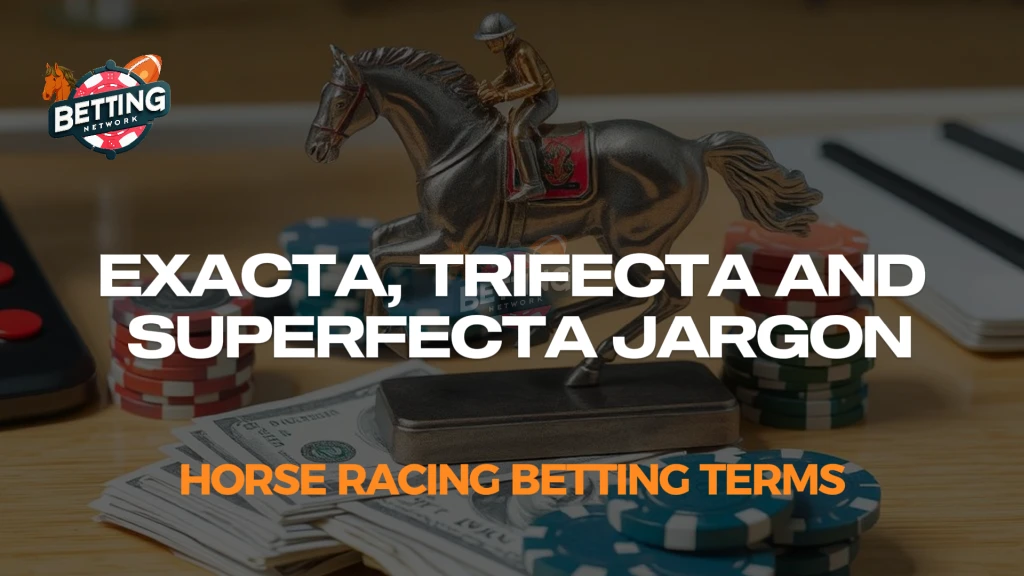
These bets are all about predicting the top finishers in a race, which is harder to do but obviously offers better payouts. Let’s go over each.
Exacta
You’re betting on which two horses will finish first and second in exact order. For instance, if you bet on Horse A to win and Horse B to come second, they must finish in that exact order for you to win. Exacta bets are a bit challenging but has a better payout.
Trifecta
This bet it’s even riskier than an Exacta: you’re predicting the first, second, and third place finishers in exact order. If you bet on Horse A to win, Horse B to place second, and Horse C to show third, they must finish in that exact sequence, otherwise you lose the entire Trifecta bet.
Superfecta
The Superfecta horse racing bet is the most challenging of them all: similar to the trifecta, you’re betting on the top four finishers in exact order. This means predicting which horses will come in first, second, third, and fourth (obviously the higher the risk, the bigger the reward).
Pick 3, 4 and Daily Double Horse Racing Bets and Terms

These bets string together different races to offer some massive payouts. If you like Parlays, then Daily Double, Pick 3, and Pick 4 are the ones for you. These are all about predicting the winners of multiple races, and they’re the perfect way to stretch your bet across a few races.
Daily Double
With a Daily Double, you’re betting on the winners of two consecutive races. Let’s say you pick Horse A to win the first race and Horse B to win the second. Both horses must win their respective races for you to cash in (it’s like combining two-win bets into one).
Pick 3
Instead of just picking two winners, you’re betting on the winners of three consecutive races. If you’re confident in your picks, this can be a great way to turn a small bet into a big win. But keep in mind: all three horses must win their races for you to win the bet!
Pick 4
With the Pick 4 horse racing bet you try to predict the winners of four consecutive races. It definitely raises the bar, since its obviously tougher to nail all four picks. If you’ve done your homework and feel good about your picks, your wins could be massive.
Box, Key and Wheel Horse Racing Betting Terms
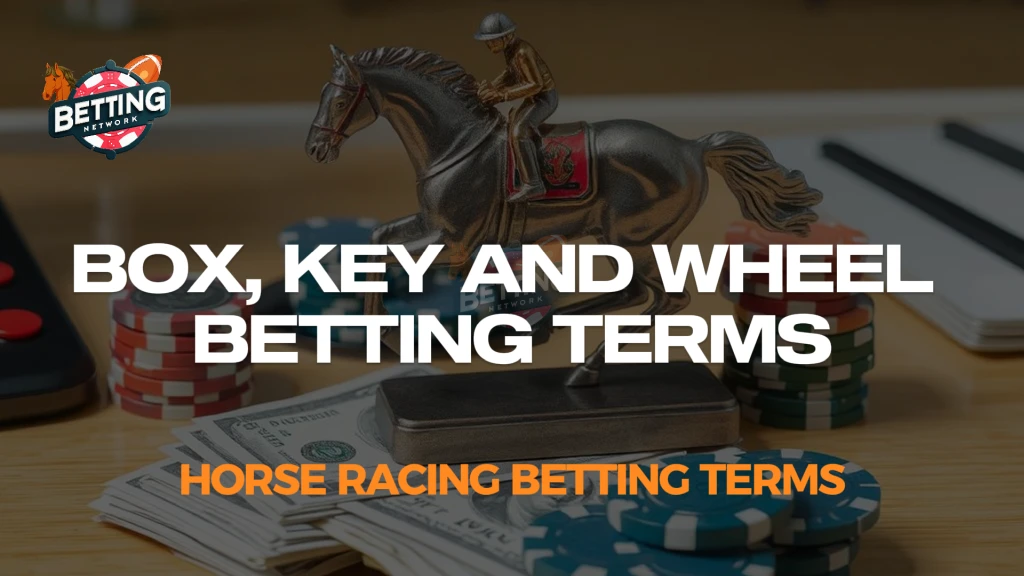
Box, Key, and Wheel bets are a track veteran’s boon: you can bet big on a horse to take the race, but also cover some additional positions. What makes this bet more appealing than others is that you don’t have to get the exact order or position of the horses right to win big.
It does, however, add a layer of strategy and can increase your chances of winning, making them great choices for races with a lot of strong contenders. Let’s take a look at each:
Box Bet
A Box bet allows you to cover multiple combinations for a set of horses regardless of the exact order they finish in. Let’s say you’re betting on an Exacta Box with Horses A, B, and C. With this bet, you’re covering all possible combinations of these horses finishing first and second. So, as long as two of your three horses come in first and second, you win. It’s like spreading your chances across different outcomes.
Key Bet
A Key bet is more focused. You’re betting that one particular horse (your “key”) will finish in a specific position, with all the other horses you’re betting on filling the remaining spots. For instance, if you think Horse A is going to take the win, you would place a Key Exacta bet where Horse A must finish first, then you can pick Horses B, C or even D to finish second. If Horse A wins and one of your other picks comes second, you’re in the money.
Wheel Bet
A horse racing Wheel bet is about maximizing your chances by betting on one horse to finish in a particular position, with any number of other horses filling the remaining spots. There are two types:
- Full Wheel: You pick one horse to finish in a specific position, and you cover all other horses to finish in the remaining positions. You could bet on Horse A to finish first, with any other horse to finish second (if it’s an Exacta) or third (if it’s a Trifecta).
- Part Wheel: You pick your horse to finish in a specific position, but you also narrow down the other horses you think have a chance to fill the remaining spots. It’s great when you got other solid horses competing in the race, since you can spread your risk across several combinations.
Horse Racing Betting Terms You’ll Need to Know
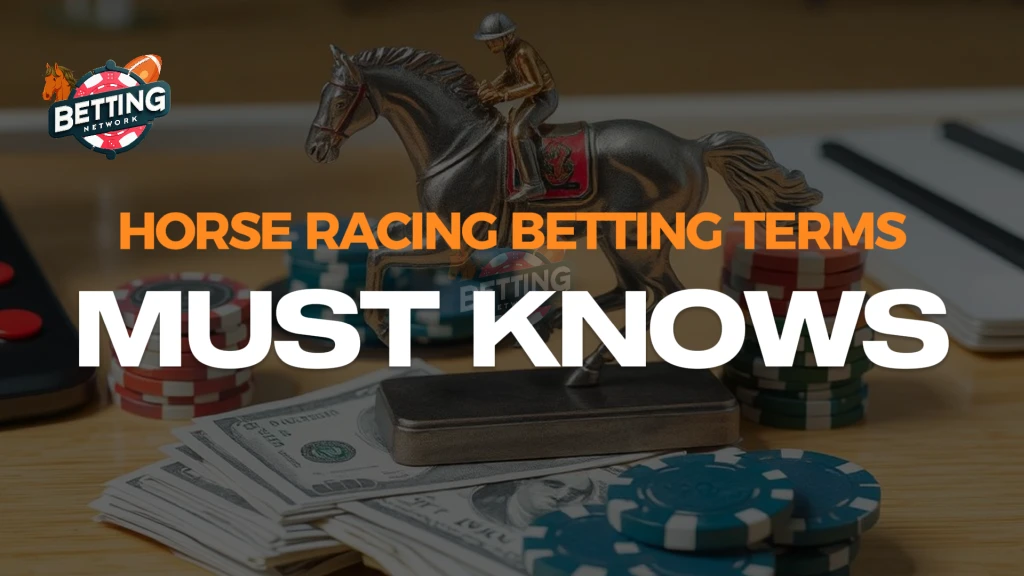
There are some horse racing terms that will instantly help you make better decisions at the track. These will help you better understand how different factors actually influence the outcome of a race, so if any of these shifts, you’ll know how to find even more value in your bets.
Let’s go through these real quick.
Morning Line
The Morning Line is an estimate of what the odds on each horse will be by the time the race starts. It’s set by the track handicapper before betting opens. Think of it as a starting point for odds, not the final say. If you see a horse with 5-1 odds on the Morning Line, it means the handicapper thinks that horse has a reasonable chance, but the odds can change based on how much money is bet on it.
Overlay
An Overlay happens when a horse’s odds are higher than they should be, based on its chances of winning. For example, if you believe a horse should be a 3-1 shot but the betting public has it at 6-1, that’s an Overlay. Betting on Overlays is a good strategy because you’re getting better value for your money.
Underlay
An Underlay is the opposite of an Overlay. It’s when a horse’s odds are lower than they should be, given its chances of winning. If a horse should be at 5-1 but is instead at 2-1, that’s an Underlay. These bets offer poor value because you’re getting less return on a horse that might not have a great chance of winning.
Speed Figures
Speed Figures are a numerical representation of how fast a horse ran in a race, adjusted for track conditions and other variables. They’re useful for comparing horses across different races and tracks. The higher the number, the faster the horse.
Beyer Speed Figures
Beyer Speed Figures are a specific type of Speed Figure created by Andrew Beyer, a well-known handicapper. These figures are widely used in the U.S. and can be found in most race programs. They’re calculated based on the horse’s performance relative to the track record for that distance. A horse with a Beyer Speed Figure of 90 is considered fast, while anything over 100 is exceptional.
Horse Racing Track Terms: Fast, Good, Yielding, Soft
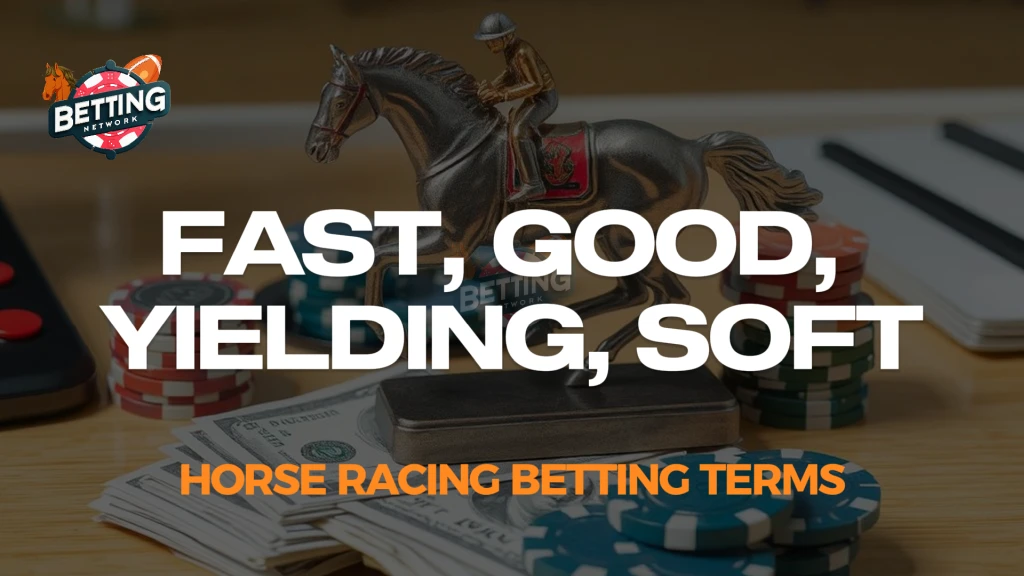
These terms relate to the condition of the turf (grass) track:
- Fast: A dry, firm track that provides ideal racing conditions.
- Good: A track that’s a bit softer than fast, often after light rain.
- Yielding: A track that’s softer and slower, typically after more substantial rain.
- Soft: The slowest track condition, very soft and wet, making it tough for horses to run their fastest.
Off Track, Sloppy
Both of these describe the condition of a dirt track:
- Off Track: A general term for any track that isn’t fast, meaning it’s been affected by rain.
- Sloppy: A track with a lot of water on the surface but still firm underneath. Horses splash through the mud, and some love it, while others don’t perform as well.
A List of Horse Racing Betting Terms (With Examples!)
Last but not least, we wanted to give you a comprehensive list or index of horse racing betting terms so you don’t have to search all over the place for the technical, most elaborate ones. As always, managing your bankroll its a skill on its own so always be mindful about it when betting on horses.
Horse Racing Terms: Letter A
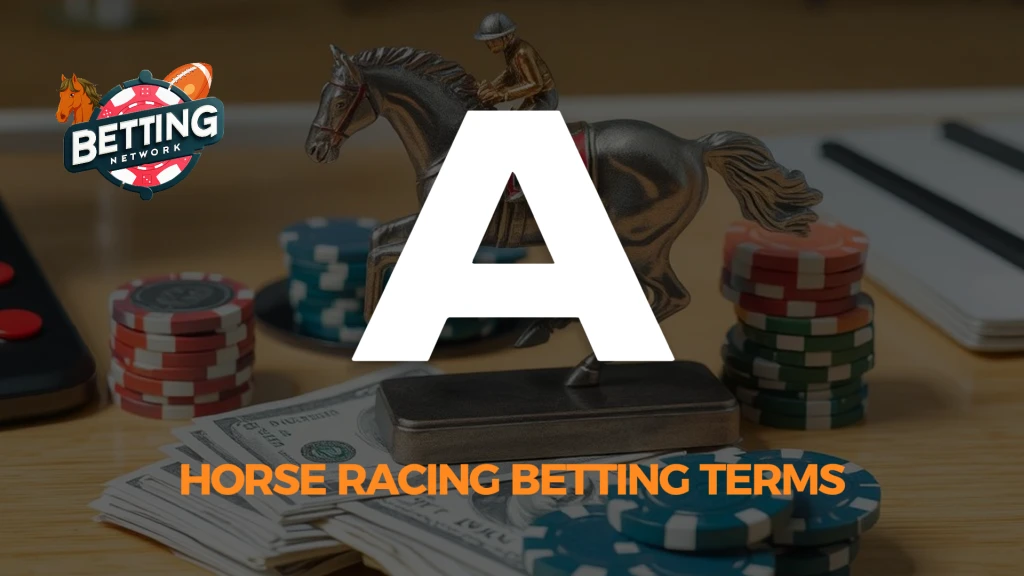
Abandoned: When a race gets called off due to bad weather.
Example: “The heavy rain caused the races to be abandoned. All bets got refunded and I went home early.”
Account wagering: Betting by internet or phone with a pre-funded account. Example: “I placed my bet through account wagering on my favorite horse from home.”
Across the Board: A bet on a horse to win, place, and show.
Example: “I bet across the board on Horse #5. As long as it finishes in the top three, I’ll get some cash.”
Accumulator: A bet on multiple selections where winnings from one bet roll onto the next.
Example: “I made an accumulator bet on four races; I know it’s a bit of a longshot, but if all my horses win, I’ll be a happy man.”
Added Money: Extra funds added to the purse of a race by sponsors.
Example: “The local sponsors really added money to the purse, so the stakes are high”
Age: The age of a horse, critical in determining race eligibility.
Example: “Only 3-year-old horses are allowed to race in this derby.”
Aged: A horse that is four years old or older.
Example: “That aged mare is a track veteran, so she’s a favorite.”
Allowance: Weight adjustments based on age, sex, or past performance.
Example: “This filly gets an allowance, carrying less weight than her male competitors. It should level the playing field for sure”
Allowance Race: A race with specific conditions where horses carry weights based on past performances.
Example: “The allowance race today will level the playing field for younger horses, so it got real interesting.”
Also-eligible: A horse entered but only allowed to run if others are scratched.
Example: “The horse was also-eligible, but got to run when another horse dropped out.”
Apprentice: A jockey who is still learning, often given weight allowances.
Example: “The apprentice jockey’s 5-pound allowance could give his horse an edge.”
Ante post: Betting before the day of the race. These bets often come with higher risks and rewards.
Example: “I placed an ante post bet on the Derby last month, hoping for better odds.”
At the Post: The moment when horses line up for the race to start.
Example: “The horses are at the post, so action is about to begin!”
Horse Racing Terms: Letter B
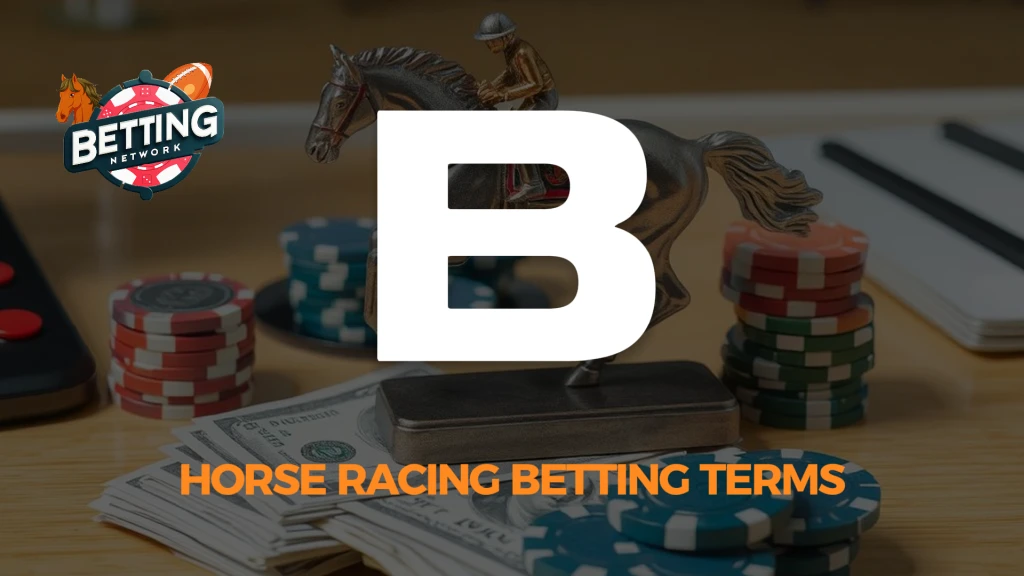
Baby Race: A race exclusively for two-year-olds.
Example: “I heard today’s baby race has some future stars lined up for their first competition!”
Back: To bet on a horse.
Example: “I’m backing Horse #7 to win today’s race.”
Backstretch: The straight part of the track opposite the grandstand.
Example: “The horse gained speed on the backstretch, setting up for a strong finish.”
Banker: A horse believed to have a very strong chance of winning.
Example: “Horse #3 is my banker for this race; I’m confident it’ll win.”
Bay: A horse color that’s brown with black mane, tail, and lower legs.
Example: “That bay horse is gorgeous. Just look at its shiny coat!”
Bearing In (or out): When a horse deviates from a straight course.
Example: “Horse #6 bore out in the final stretch, I was losing my mind!”
Betfair: An online betting exchange where bettors wager against each other.
Example: “I prefer Betfair because I can get better odds by betting against other players.”
Betting Exchange: A platform where people bet against each other rather than a bookmaker.
Example: “Using a betting exchange, I laid a bet against Horse #4 winning.”
Betting In Running: Placing bets during the actual race.
Example: “I waited until the final turn to place my bet in running. A bit risky, but I always get better odds.”
Betting Ring: The area at a racetrack where bookmakers take bets.
Example: “The betting ring got real crowded as the big race approached.”
Black: A horse with a completely black coat.
Example: “That stunning black stallion is the favorite in today’s race.”
Black Type: Refers to horses that have been placed in a Group or Listed race, enhancing their breeding value.
Example: “This mare has black type in her pedigree. Her offspring are gonna cost a pretty penny.”
Blacksmith: A person who shoes horses.
Example: “The blacksmith worked around the clock so that all the horses would have the right shoes for the race.”
Blinkers: Headgear that limits a horse’s vision to help it focus.
Example: “The trainer added blinkers to help the horse concentrate during the race.”
Bloodstock: Refers to the breeding industry, including horses bred for racing.
Example: “He’s invested heavily in bloodstock, hoping to breed the next champion.”
Bookie: A bookmaker who takes bets.
Example: “I placed my bet with the bookie at the trackside.”
Box: A betting term for selecting multiple horses in a bet to cover all possible combinations.
Example: “I boxed my exacta, so I’ll win if either Horse #2 or #5 finishes first or second.”
Boxed In: When a horse is trapped and unable to move forward in a race.
Example: “Horse #4 got boxed in and couldn’t make a run in the final stretch, it was so unlucky!”
Break: The start of the race when horses leave the starting gate.
Example: “Horse #3 had a slow break but really closed the distance quickly.”
Bridge jumper: A bettor who places large show bets on heavily favored horses.
Example: “The bridge jumper bet big on the favorite, hoping for a guaranteed small return.”
Bridle: The headgear used to control a horse.
Example: “The bridle slipped, making it harder for the jockey to steer the horse.”
Broodmare: A female horse used for breeding.
Example: “This broodmare has produced several successful racehorses.”
Brown: A horse color with a brown body and black points.
Example: “The brown colt is known for its speed in the final furlong.”
Buckskin: A horse color with a yellow or gold body and black points.
Example: “The buckskin horse stood out with its unique color among the field.”
Bullet: The fastest workout of the day at a track.
Example: “Horse #8 had a bullet workout, so he’s a top contender for sure, at least today.”
Bumper: A flat race for National Hunt horses to prepare them for jumping.
Example: “The bumper race was an excellent warm-up for the young jumpers.”
Horse Racing Terms: Letter C
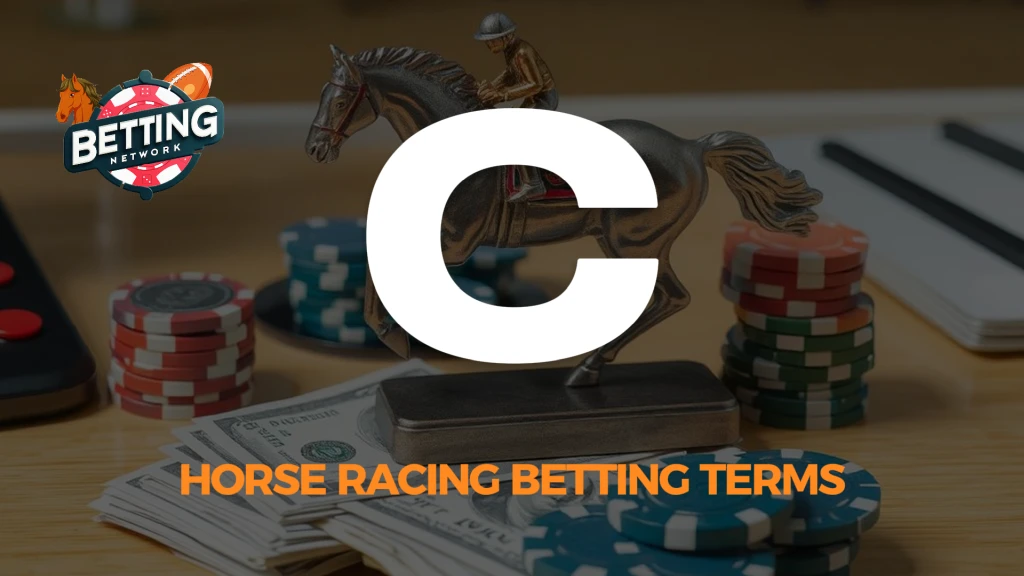
Canadian: A bet consisting of 26 separate bets on five horses in different races.
Example: “I placed a Canadian bet today, so I’m feeling very lucky. If my selections do well, I’m buying lunch!”
Canadian Pari-Mutuel Agency (CPMA): The regulatory body overseeing pari-mutuel betting in Canada.
Example: “The CPMA ensures that all bets are fair and transparent.”
Card: The schedule of races for a day.
Example: “There are 10 races on today’s card, with the first one starting at noon.”
Cash out: Taking a payout before a bet is settled, usually at reduced odds.
Example: “I decided to cash out early when my horse took the lead.”
Chalk: The betting favorite in a race.
Example: “Horse #3 is the chalk, so it’s the one everyone expects to win.”
Chalk player: A bettor who typically wagers on favorites.
Example: “As a chalk player, he always bets on the favorite, hoping for a safer win.”
Chart: A detailed record of a race showing the positions and performances of horses.
Example: “Check the chart to see how your horse performed throughout the race.”
Chase: A race over steeplechase fences, typically in National Hunt racing.
Example: “He excels in chases, clearing obstacles with ease.”
Cheekpieces: Strips of sheepskin attached to the bridle to help the horse focus.
Example: “They added cheekpieces to help the horse concentrate during the race.”
Chestnut: A horse color ranging from light brown to reddish-brown.
Example: “The chestnut colt in the third race has a gorgeous coat.”
Claiming Race: A race where each horse can be purchased at a set price.
Example: “In this claiming race, any horse can be bought for $20,000.”
Classic: A prestigious race, usually for three-year-olds, like the Kentucky Derby.
Example: “Winning a classic race instantly boosts a horse’s value.”
Claimer: A horse entered in a claiming race.
Example: “That claimer was picked up by a new owner after yesterday’s race.”
Clerk of the Course: The official responsible for the racetrack and racing conditions.
Example: “The Clerk of the Course declared the track safe despite the rain.”
Closer: A horse that performs best in the latter part of the race.
Example: “Watch out for Horse #7, a strong closer that comes from behind.”
Colt: An intact male horse under four years old.
Example: “The two-year-old colt shows great promise for future races.”
Colours: The jacket and cap worn by the jockey, representing the horse’s owner.
Example: “The jockey’s colors are green and white, matching the owner’s stable.”
Connections: The people associated with a horse, including the owner, trainer, and jockey.
Example: “The connections were thrilled with their horse’s performance today.”
Horse Racing Terms: Letter D
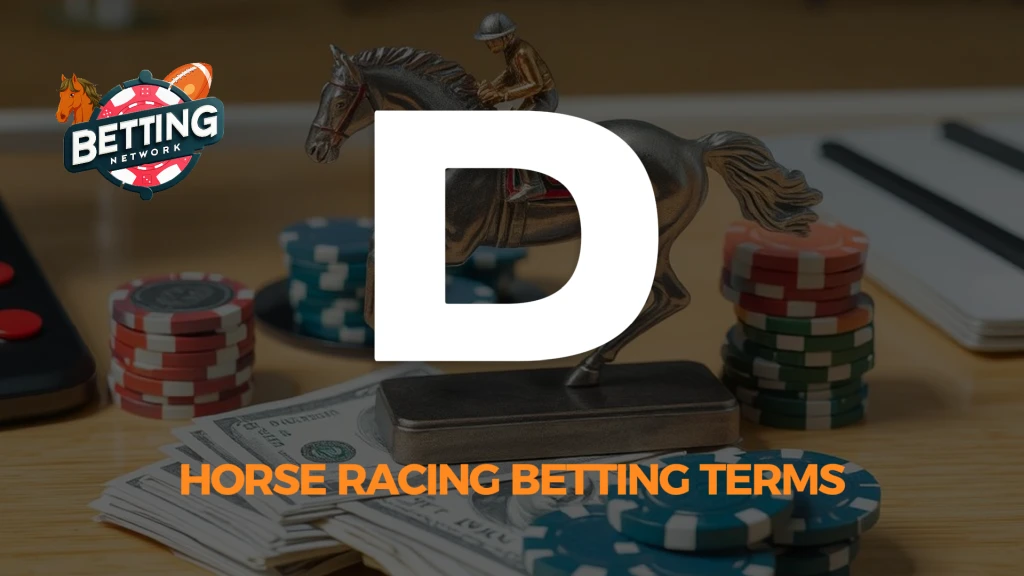
Dam: The mother of a horse.
Example: “This filly’s dam was a champion racer herself.”
Daily Double: A bet on the winners of two consecutive races.
Example: “I placed a Daily Double on races 2 and 3, hoping both my horses win.”
Dead Heat: When two or more horses finish exactly together.
Example: “It was a dead heat for first place, so the payout got split.”
Derby: A race for three-year-old horses.
Example: “The Kentucky Derby is the most famous Derby in the U.S.”
Disqualification: A horse is removed from its finishing position for breaking a rule.
Example: “Horse #5 was disqualified for interference, so it lost the win.”
Distaff: A race for female horses.
Example: “She’s running in the Distaff, competing only against other fillies and mares.”
Distanced: When a horse finishes far behind the winner.
Example: “The horse was distanced, coming in more than 20 lengths behind, it was tough to watch.”
Dividend: The return you receive from a bet.
Example: “The dividend on my win bet was way higher than I expected, so lunch is on me boys!”
Double: A bet on two selections in different races, both must win.
Example: “I made a double bet on races 4 and 5, so both horses need to win.”
Drift: When a horse’s odds increase before the race.
Example: “The favorite drifted to 5/1 just before the start, which was crazy.”
Driver: The person who steers the horse in harness racing.
Example: “The driver expertly guided the trotter to victory right at the final stretch.”
Dutch: Placing a bet on more than one horse in a race, ensuring profit if any of them wins.
Example: “I dutched the race by betting on three horses with favorable odds.”
DQ: Abbreviation for disqualification.
Example: “Horse #8 was DQ’d for veering into another horse’s path.”
Horse Racing Terms: Letter E
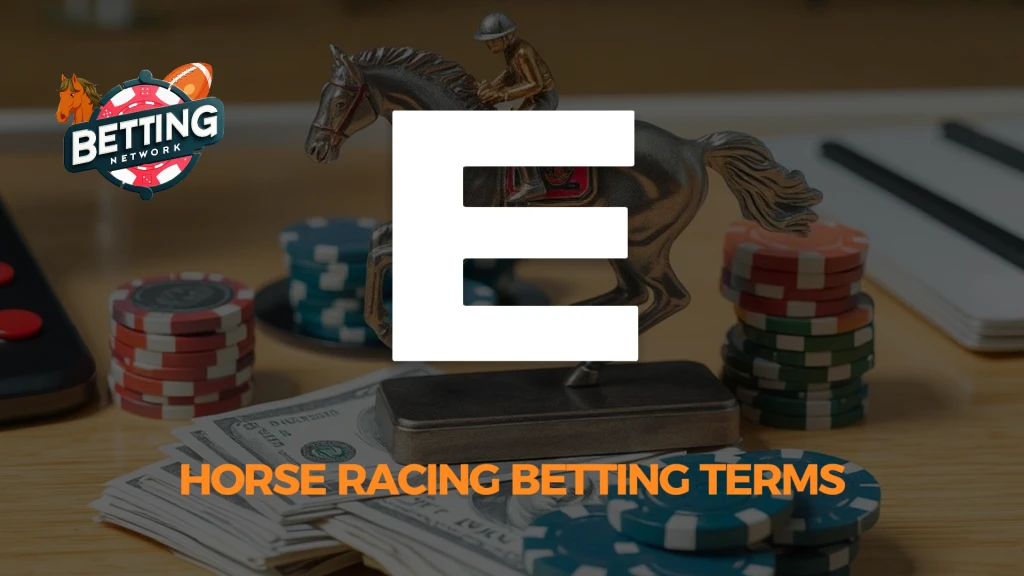
Each way: A bet where you win if your horse finishes in the top three.
Example: “I placed an each-way bet, so I’ll still collect if my horse finishes second or third.”
Early and Late Closing Events: Races requiring nominations and payments before the event.
Example: “He entered his horse in an early closing event last month.”
Eighth: A measurement of distance in a race, equivalent to one-eighth of a mile.
Example: “The horse gained two lengths in the final eighth of the race.”
Entry: Two or more horses with the same owner, running as a single betting unit.
Example: “The entry includes Horses #1 and #1A, so betting on one covers both.”
Equipment: The gear a horse wears during a race, like blinkers or a saddle.
Example: “The trainer added new equipment, hoping it improves the horse’s focus.”
Evens: Odds of 1/1, meaning you double your money if you win.
Example: “At evens, a $10 bet will return $20 if the horse wins.”
Exotic (bet): A bet on something other than just win, place, or show.
Example: “I tried an exotic bet with a trifecta, picking the top three finishers in order.”
Exactor: A bet where you predict the first two finishers in exact order.
Example: “I hit the exactor with Horses #2 and #5 finishing first and second.”
Exactor Box: A bet covering all possible combinations of two horses finishing first and second.
Example: “I boxed the exactor, so I win if my two horses finish in any order.”
Horse Racing Terms: Letter F
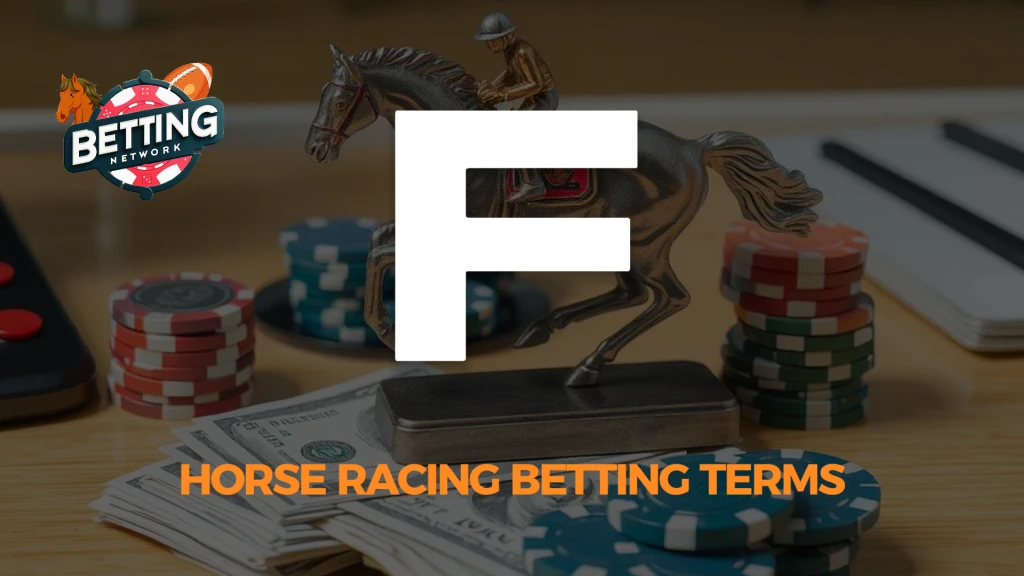
Favourite: The horse with the shortest odds to win.
Example: “Horse #6 is the clear favorite, with everyone betting on it to win.”
Farrier: A person who shoes horses.
Example: “The farrier came to check if the horse’s shoes were fitted correctly.”
Fast Track: A dry, even track considered ideal for racing.
Example: “With the fast track today, we should see some quick times.”
Field: Refers to all the horses running in a race.
Example: “Calling a race with 12 horses in the field is pretty difficult.”
Filly: A female horse under the age of four.
Example: “This two-year-old filly has shown a lot of promise so far.”
First Over: The first horse to move outside and challenge the leader in a race.
Example: “Horse #4 was first over, he’s gonna try to overtake the leader in the final stretch.”
Foal: A horse that is less than one year old.
Example: “That foal will start training once it’s a bit older.”
Fold: Refers to the number of selections in an accumulator bet.
Example: “I placed a fourfold bet, meaning all four of my picks must win.”
Form: The performance record of a horse in previous races.
Example: “Looking at the form, Horse #7 has been consistently placing in the top three.”
Free-legged: A pacer that races without hopples, which help maintain its gait.
Example: “This horse races free-legged, so it has a very natural stride.”
Front-runner: A horse that likes to lead from the start of the race.
Example: “Horse #2 is a front-runner, so expect it to be ahead early on.”
Furlong: A measure of distance in a race, equal to one-eighth of a mile.
Example: “The race is 6 furlongs, so it’s a short sprint to the finish.”
Horse Racing Terms: Letter G
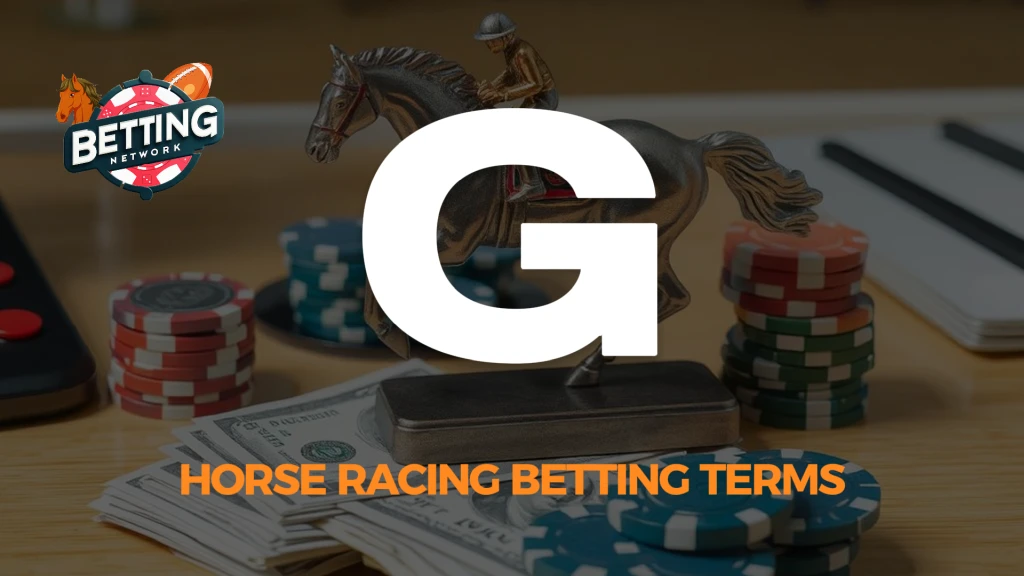
Gallop: The fastest gait of a horse, used in most races.
Example: “The horses were at full gallop as they neared the finish line.”
Gate: The starting mechanism that holds horses before the race begins.
Example: “The horses loaded into the gate, ready for the start.”
Gelding: A castrated male horse, often calmer and more focused.
Example: “This gelding has been running well since the change.”
Goliath: A massive bet covering eight selections with 247 separate bets.
Example: “I tried a Goliath bet, covering every possible combination for these eight races.”
Good Track: A track condition between fast and slow, offering fair footing.
Example: “We got a good track today, so things should get interesting!”
Going: The condition of the race track, ranging from firm to heavy.
Example: “The going is soft, which might slow down the race.”
Graded race: A high-level race classified into Grade 1, 2, or 3 based on quality.
Example: “If the horse can win this Grade 1 race, its breeding value is gonna go way up!”
Grey: A horse with a coat color that mixes black and white hairs.
Example: “Take a look at that grey horse! Everyone’s looking at it!”
Groom: The person responsible for the daily care of a racehorse.
Example: “The groom was up early to prep the horse for race day.”
Horse Racing Terms: Letter H
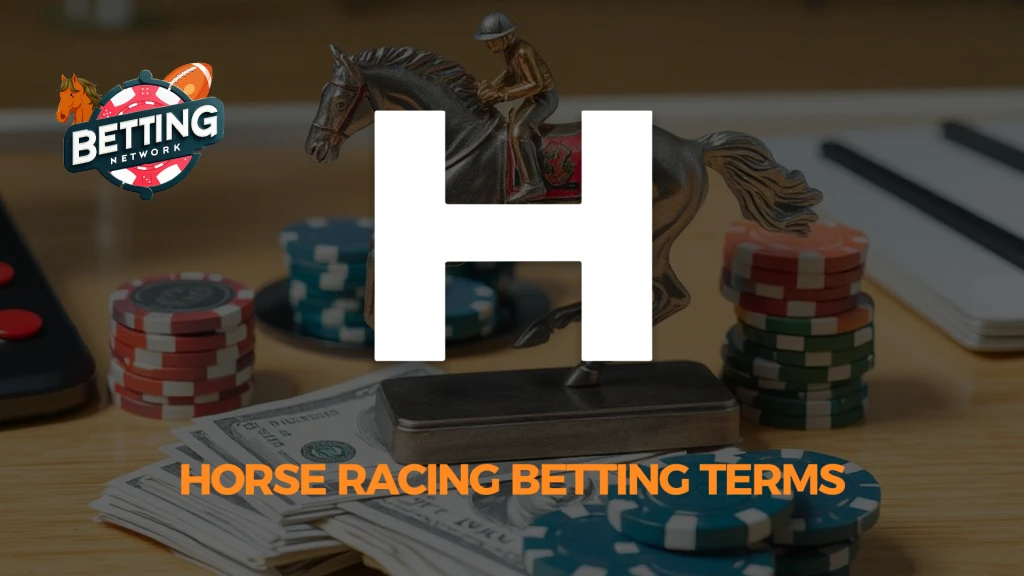
Handle: The total amount of money wagered on a race or series of races.
Example: “The handle for the Derby was crazy. It exceeded $100 million this year.”
Handicap: A race in which horses carry different weights (based on their past performances) to even the competition.
Example: “Before you place your bet, I wanted to let you know that the favorite is carrying an extra 5 pounds.”
Handicapper: A person who assesses the form of horses and predicts the outcome of races.
Example: “The handicapper thinks Horse #3 has a good shot based on its recent form and track conditions, so that’s promising.”
Hand: A unit of measurement (equal to four inches). It’s used to measure a horse’s height at the shoulder.
Example: “That horse stands 16 hands tall, so just about average for a thoroughbred.”
Head: A small distance between horses, often used to describe a close finish.
Example: “I can’t believe that Horse #6 won by a head! I could’ve made a lot of money.”
Head of the Stretch: The beginning of the final straight part of the track leading to the finish line.
Example: “Thing’s got pretty heated by the head of the stretch, the horses really kicked it up a notch”
Heinz: A bet involving six selections with 57 separate bets.
Example: “I placed a Heinz bet on these six races, so I pretty much covered every possible outcome.”
Home Stretch: The final straight portion of the track before the finish line.
Example: “The horses are in the home stretch now; it’s anyone’s race.”
Hood: A piece of equipment placed over a horse’s head to cover its ears and limit noise.
Example: “The horse is known to get distracted, so they’re racing it with a hood to keep it focused”
Hopples: Straps used on pacers to help maintain their pacing gait.
Example: “The pacer needs hopples to keep its stride fluid throughout the entire race.”
Horse: A mature male horse, typically over four years old.
Example: “The track favors this Horse, at least that’s what the record shows.”
Hurdles: Obstacles that horses jump over in certain types of races, mainly in National Hunt racing.
Example: “That horse is a pretty strong hurdler; it’s clearing all the obstacle like they’re nothing!”
Horse Racing Terms: Letter I
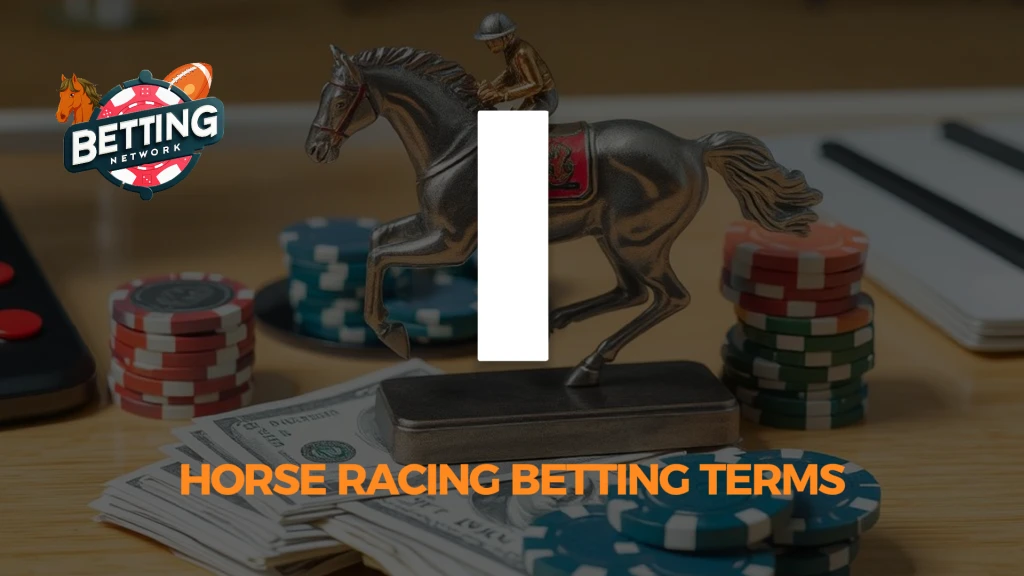
In Running: Betting on a horse during the actual race, while it’s happening.
Example: “Soon as I saw Horse #3 gaining on the leader, I made an in-running bet.”
In the frame: A horse that finishes in the top three positions.
Example: “Horse #5 was in the frame. It didn’t win, but it finished second and I still got paid.”
Inquiry: A review by race officials to see if any rules were broken throughout the race.
Example: “There’s an inquiry into possible interference during the final stretch. Apparently Horse #2’s win wasn’t legitimate.”
Invitational (Open or Free For All): These are high-stakes race for some of the best horses around. They’re often invite-only.
Example: “Horse #6 got invited to the invitational. It’s a really prestigious race with an even larger purse, so I have faith in him.”
Horse Racing Terms: Letter J
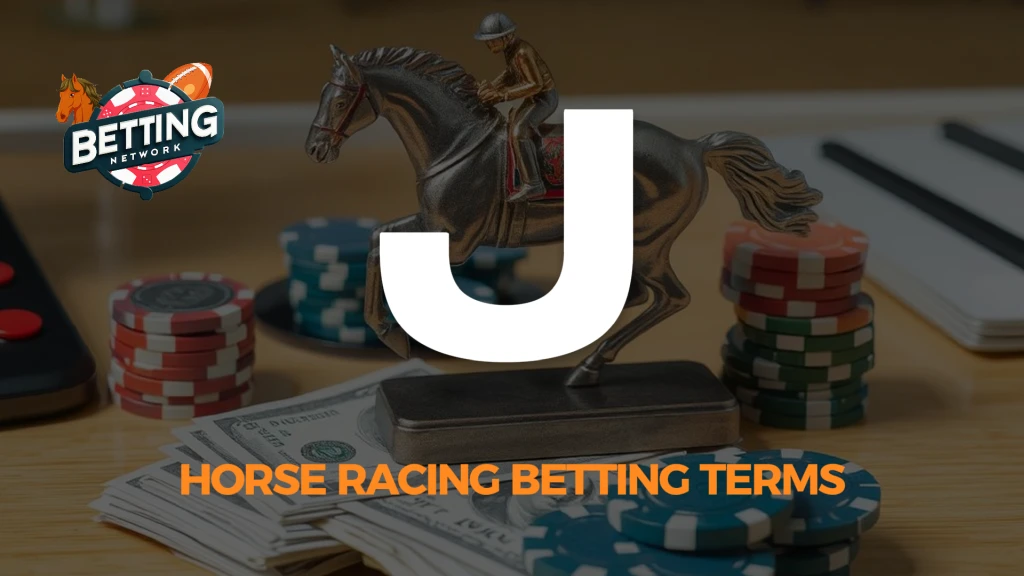
Joint favourite: When two horses share the shortest odds in the betting.
Example: “There’s a couple of joint favorites for the upcoming race, they both sit at 3/1.”
Jolly: A slang term for the favorite horse in a race.
Example: “Horse #3 is the jolly for the race, it’s made me a lot of money before so I’m backing it.”
Judge: The official who determines the order of finish in a race.
Example: “The judge went through the photo finish and gave Horse #7 the win”
Jockey: The person who rides the horse in a race.
Example: “The jockey made a brilliant move on the outside to take the lead.”
Horse Racing Terms: Letter K
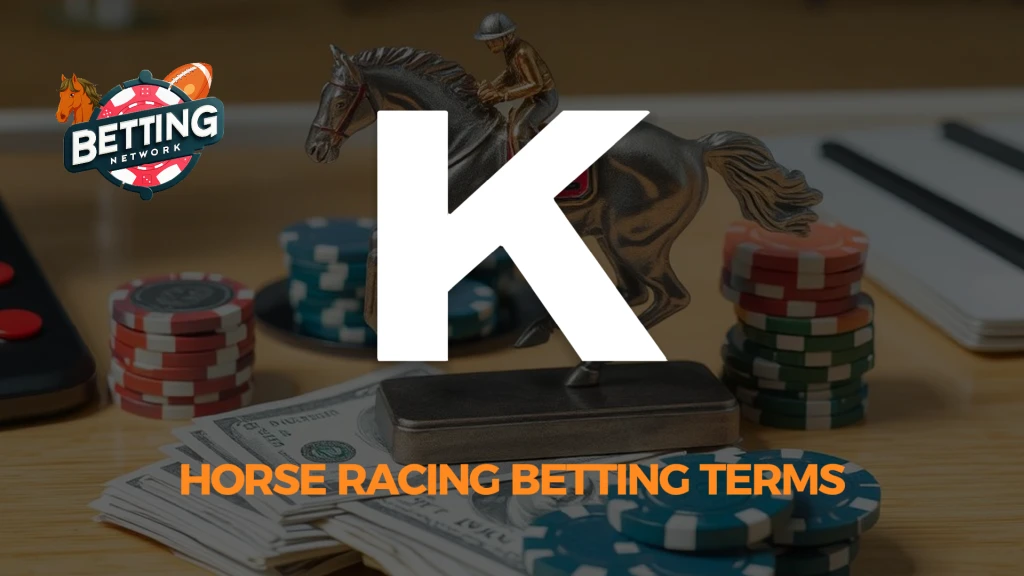
Key horse: The main horse in a bet that is used in multiple combinations in an exotic wager.
Example: “I keyed Horse #5 in my trifecta, meaning it must finish first, second, or third for my bet to pay off.”
Horse Racing Terms: Letter L
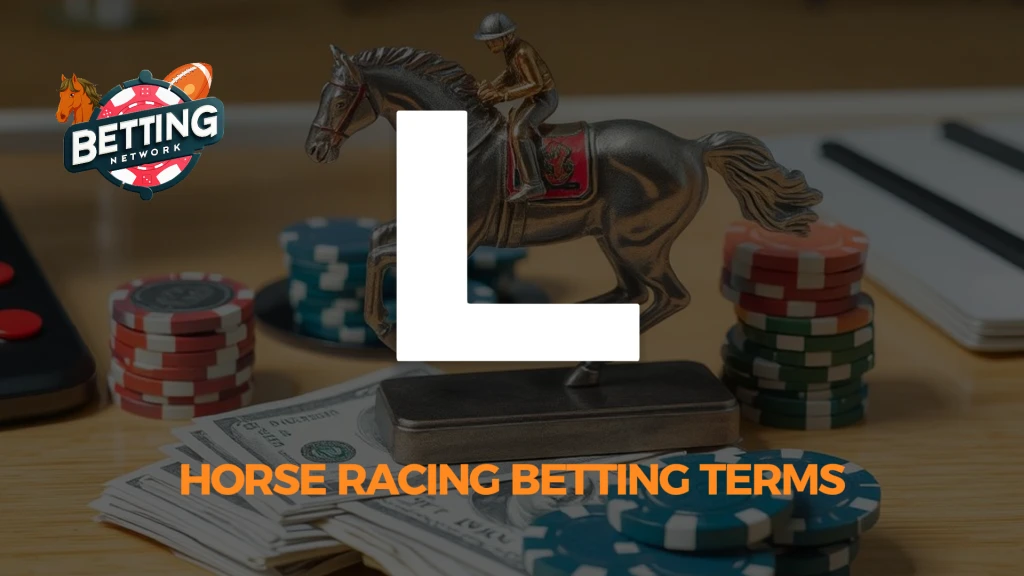
Lasix: A diuretic medication given to a horse to prevent bleeding in the lungs during a race.
Example: “Horse #4 can run for sure, but he needs to be on Lasix if he wants to keep up.”
Late Double: A bet on the winners of the last two races of the day.
Example: “I placed a late double on the last two races, hoping to finish the day strong.”
Lay: Betting on a horse to lose rather than to win.
Example: “I decided to lay Horse #4, apparently they’re not giving him Lasix today so I doubt he’ll win.”
Length: A measurement that describes or estimates the distance between horses in a race. It’s approximately the length of a horse’s body.
Example: “Horse #6 won by three lengths from where I was standing, so it wasn’t even close.”
Listed Race: A race just below Group/Grade status, but still a high-quality event.
Example: “The listed race today features some promising young horses.”
Longshot: A horse with high odds, so not many expect it to win the race. If it does, the payouts could be huge though!
Example: “I need a big win, so I’m taking my chances on a longshot with 20/1 odds.”
Lucky 15: A bet consisting of 15 different bets across four selections: four singles, six doubles, four trebles, and one fourfold accumulator.
Example: “I was feeling cheeky today, so I played a Lucky 5 on these four horses. I hope at least one of them wins man.”
Horse Racing Terms: Letter M
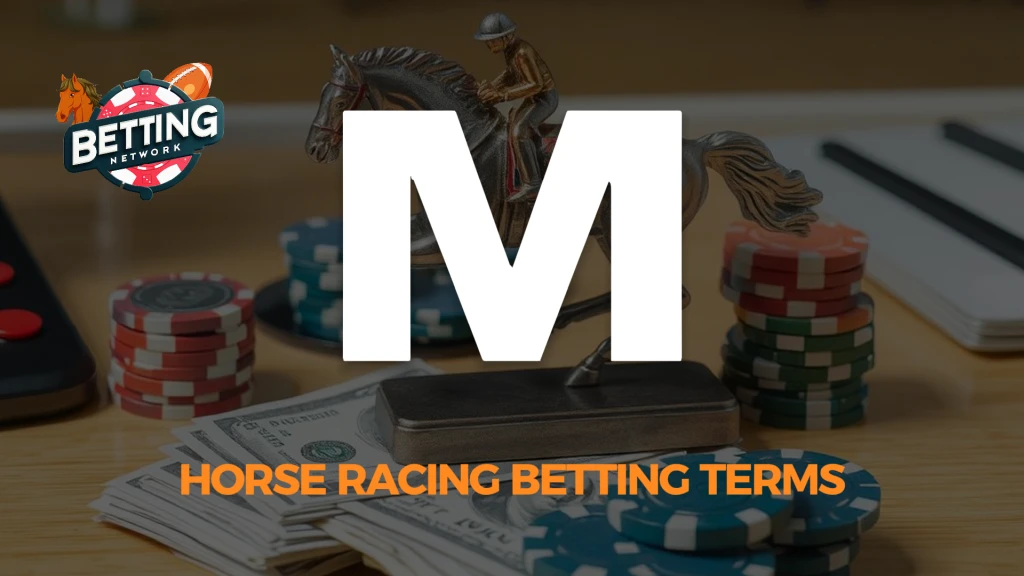
Maiden: A horse that still hasn’t won a race.
Example: “This maiden is on its third race, so I’m banking on a break through today.”
Maiden Race: A race for horses that have never won a race.
Example: “This maiden race is full of young horses with a lot of potential. Whoever wins gets their first win.”
Market mover: A horse whose odds change significantly before the race due to betting activity.
Example: “Horse #8 is a market mover, its odds shortened real quick.”
Mare: A female horse aged five years or older.
Example: “This mare has a lot of experience on its side: it’s been racing for three seasons with solid placements.”
Morning line: The initial odds set by the track’s handicapper before any betting takes place.
Example: “The morning line had Horse #5 as the favorite, but the odds have shifted since then.”
Multiple: A bet consisting of more than one selection, such as a double, treble, or accumulator.
Example: “I placed a multiple bet on three races, I’m hoping I score big today!”
Mutuels: The area where you place your bets and collect winnings at the track.
Example: “My horse won, let me head to the mutuels to cash in my ticket.”
Horse Racing Terms: Letter N
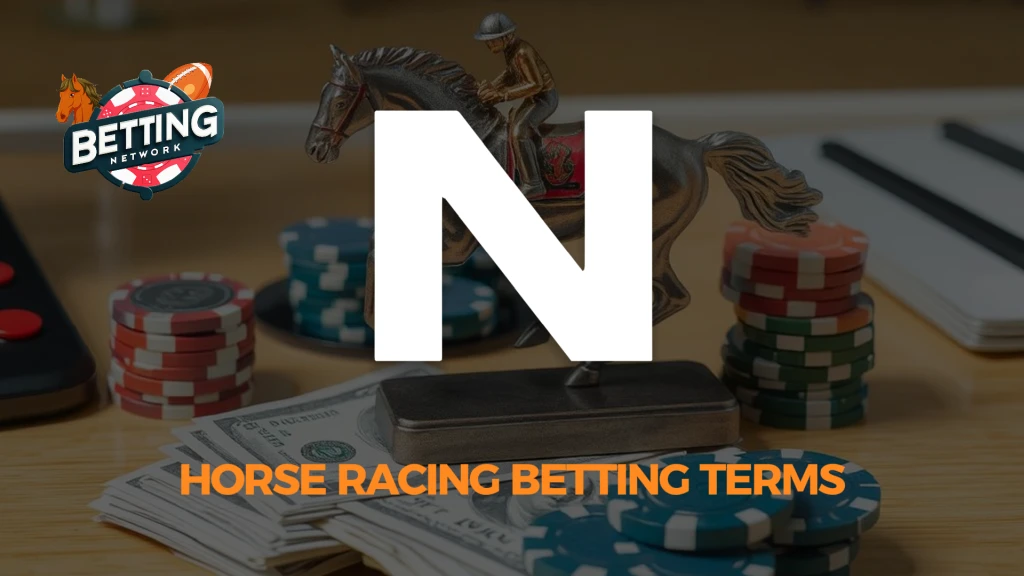
Nap: The best bet of the day according to a tipster or expert.
Example: “The tipster’s nap for today is Horse #7 in the fourth race. I trust this dude, so I’m going all in.”
National Hunt: A type of horse racing that includes jumps, such as hurdles and steeplechases.
Example: “National Hunt racing is thrilling to watch, especially with those big jumps.”
Neck: A small margin of victory in a race, less than a length.
Example: “Horse #3 won by a neck in a close finish. I can’t believe I lost that bet!”
Non-runner: A horse that was scheduled to race but was withdrawn before the start.
Example: “There was a non-runner in the third race, so the field is smaller now. He wasn’t one of my picks either, so I’m good.”
Horse Racing Terms: Letter O
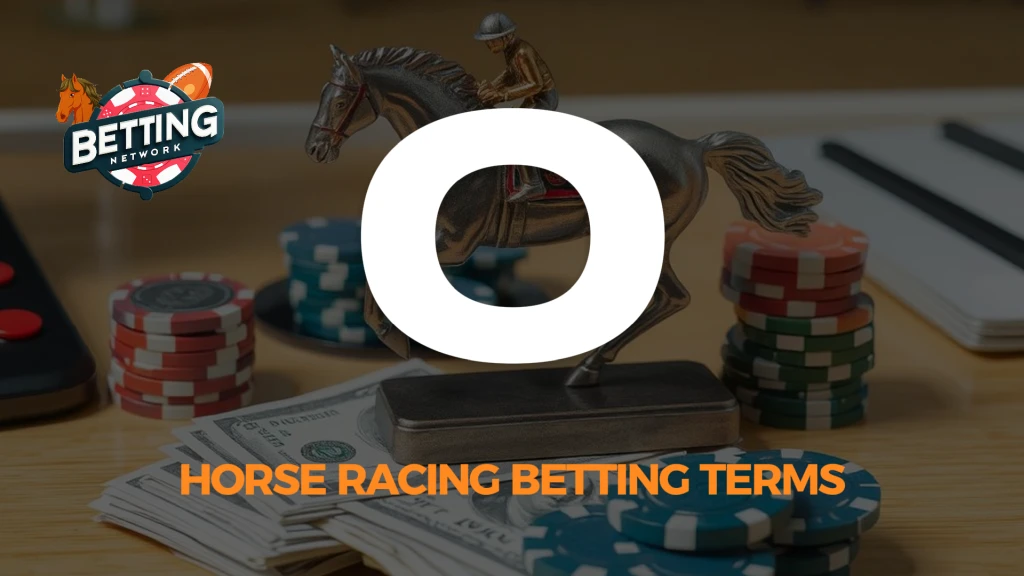
Objection: A claim of foul made by a jockey or steward after a race, potentially altering the result.
Example: “The jockey filed an objection, claiming interference in the final stretch. Let’s see what the ruling is, this could be big.”
Odds: The price at which a horse is offered in the betting market, representing the potential payout.
Example: “Horse #2 is currently at 5/1 odds, meaning a $10 bet would return $50 plus your stake.”
Odds-against: Odds greater than even money, meaning the potential payout is more than the stake.
Example: “At 2/1 odds-against, a $10 bet would win you $20 plus your original $10.”
Odds-on: Odds shorter than even money, meaning the potential payout is less than the stake.
Example: “Horse #1 is odds-on at 4/5, so you’d need to bet $5 to win $4.”
Official: The final result of a race, confirmed by the race stewards.
Example: “The results are now official; The interreference claim was dismissed and Horse #6 is the winner!”
Off the bridle: A horse that is being urged by the jockey, no longer running comfortably.
Example: “As they entered the final furlong, Horse #5 was off the bridle and struggling.”
Off Track: A track condition that is not fast, typically wet or muddy.
Example: “The off track today could make things tricky for the front-runners. I might go with a different horse this time.”
On the board: A horse that finishes in one of the top three positions, earning a payout for place or show bets.
Example: “Horse #4 finished second, so it was on the board, and I won my place bet.”
On the bridle: A horse running comfortably without needing much urging from the jockey.
Example: “Horse #3 is on the bridle and looks like it’s got plenty left in the tank. Let’s hope he takes the race!”
On the Nose: Betting on a horse to win only.
Example: “I bet $20 on the nose for Horse #2; it’s all or nothing.”
Ontario Racing (OR): The organization responsible for overseeing horse racing in Ontario, Canada.
Example: “Ontario Racing sets the rules and regulations for all the races in the province.”
Overlay: A horse whose odds are higher than its perceived chance of winning.
Example: “Horse #7 is an overlay at 10/1, so I’m placing a bet hoping for a nice return.”
Overnight Race: A race for which entries are taken 24 to 48 hours before it runs.
Example: “The overnight race card is out; let’s see who’s running tomorrow.”
Overweight: When a jockey weighs more than the assigned weight for the race, the extra weight is called overweight.
Example: “The jockey was carrying an extra pound of overweight, which might have affected the horse’s speed.”
Horse Racing Terms: Letter P
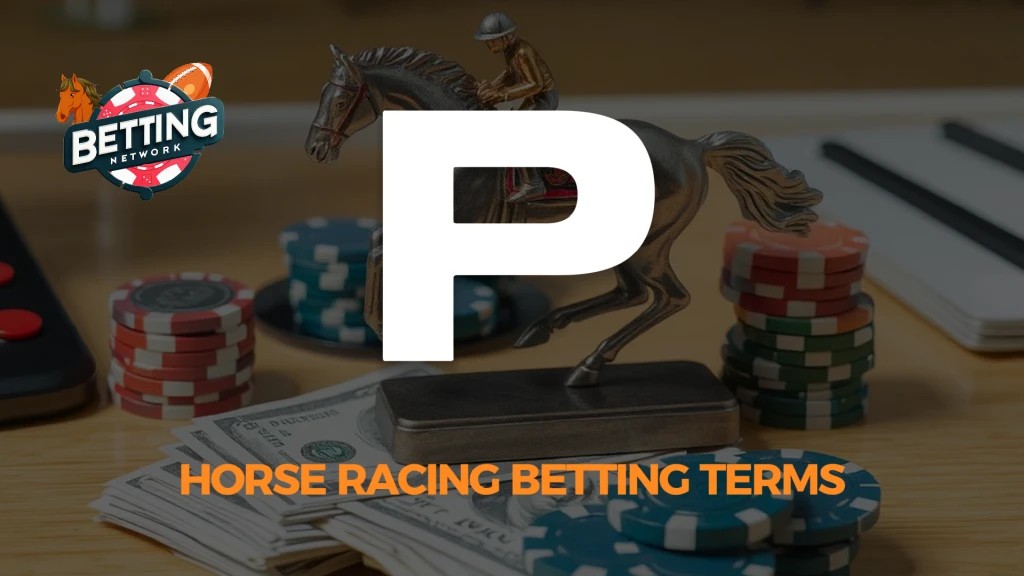
Pace: The speed at which the race is run, often dictated by the front-runners.
Example: “The pace was fast early on, which tired out some of the weaker horses. It really came down to just a handful of racers at the end.”
Pacesetter: The horse that leads the race in the early stages.
Example: “Horse #3 is known as a pacesetter, so expect it to take the lead right from the start. Some of the other horses seem weak, so #3 is a strong pick.”
Paddock: The area where horses are saddled and paraded before the race.
Example: “Let’s head to the paddock to see the horses up close before placing our bets.”
Pari-mutuel/Parimutuel: A betting system where all bets are pooled together, and the odds are determined by the amount of money bet on each horse.
Example: “In pari-mutuel betting, your payout depends on how much money is in the pool and how many people bet on the same horse.”
Parlay: A multi-race bet where winnings from one race are bet on the next.
Example: “I’m doing a parlay with races 3, 5, and 7; if I win the first race, the winnings go straight into the next bet.”
Part wheel: An exotic bet where you select a key horse to finish in a specific position and then choose other horses to finish in the remaining positions.
Example: “I bet a part wheel with Horse #2 to win and boxed the other spots with three other horses. If this goes well, then we’re going to my favorite restaurant!”
Parade Ring: Another term for the paddock where horses are paraded before the race.
Example: “Let’s check out the parade ring to get a good look at the horses before the race starts. I have a good feeling about #2 but I won’t know until I see him.”
Past Performances: A horse’s racing history, including previous race results, earnings, and other statistics.
Example: “I’m looking at the past performances to see which horse has been running well lately. It’s part of my pre-bet analysis.”
Patent: A bet that includes seven bets across three selections: three singles, three doubles, and one treble.
Example: “I placed a patent bet on these three horses, so even if only one wins, I still get a return.”
Penalty: Extra weight that a horse must carry in a race due to previous wins.
Example: “Horse #4 is carrying a penalty because it won its last race.”
Perfecta: A bet where you pick the first two finishers in exact order.
Example: “I placed a perfecta on Horses #1 and #3 to finish first and second in that order.”
Photo Finish: When the result of a race is so close that it requires a photo to determine the winner.
Example: “It was a photo finish, but Horse #5 just edged out Horse #6 for the win. I couldn’t believe it until I saw it, and the judge must’ve felt the same way.”
Pool: The total amount of money bet on a particular race or wager.
Example: “The win pool for this race is huge; there’s a lot of money on the line.”
Post Parade: The procession of horses from the paddock to the starting gate.
Example: “The post parade is starting; it’s get your game face on boys!”
Post Position: The position of a horse in the starting gate.
Example: “Horse #7 has a good post position on the outside, which might help it avoid traffic. He’s also a pacesetter so this could be huge.”
Post Time: The scheduled start time of a race.
Example: “We need to place our bets before post time; the race starts in five minutes.”
Price: Another term for the odds of a horse.
Example: “The price on Horse #4 has shortened; it’s now the favorite, which was fairly unexpected this morning.”
Pulled up: When a jockey stops a horse during a race, usually due to injury or exhaustion.
Example: “Horse #6 was pulled up halfway through the race; it didn’t look right. I sincerely hope the horse recovers soon.”
Punter: A person who places bets on horse races.
Example: “I’ve been a punter for years, and I love the thrill of picking winners.”
Purse: The total prize money for a race.
Example: “The purse for this stakes race is over $500,000. Imagine if some Local sponsors pitch in and make it even bigger!”
Pylon: Markers that outline the course, often used in harness racing.
Example: “The horse drifted out past the pylon, so it might get disqualified.”
Horse Racing Terms: Letter Q

Qualifier: A race where horses must perform to a certain standard to qualify for future races.
Example: “Horse #3 is running in a qualifier to earn a spot in next month’s big race.”
Quinella: A bet where you pick two horses to finish first and second in any order.
Example: “I placed a quinella on Horses #2 and #5; they just need to finish in the top two, the order doesn’t matter.”
Horse Racing Terms: Letter R
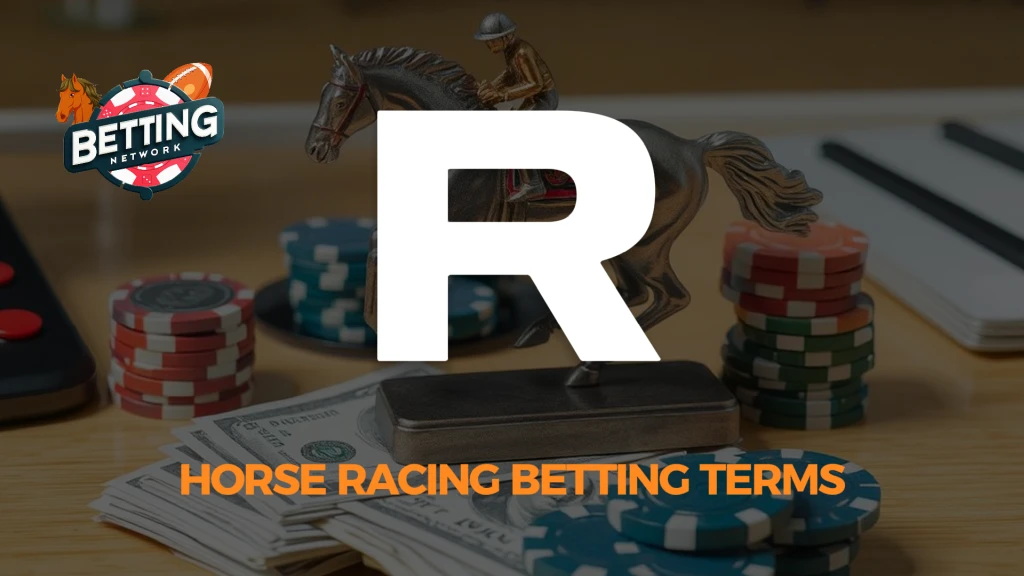
Rabbit: A horse entered in a race to set a fast pace for the benefit of another horse from the same stable.
Example: “Horse #1 is just a rabbit to tire out the field so its stablemate can win. That’s why I bet heavy on #7.”
Race: A competition between horses on a track, where the fastest horse wins.
Example: “The big race today is the Kentucky Derby, and all eyes are on the favorite.”
Race Secretary: The official who organizes races and assigns conditions for each race.
Example: “The race secretary decided to add another stakes race to tomorrow’s card.”
Race Under Saddle (RUS): A type of harness racing where the jockey rides the horse instead of driving it in a sulky.
Example: “I’ve never seen Race Under Saddle before; it’s like a mix of harness and flat racing.”
Racecard: The program that lists all the races, horses, jockeys, and other relevant information for a race day.
Example: “Grab a racecard so we can study the fields and pick our bets. We can’t really make a serious bet until we do.”
Rail: The barrier that runs around the inside of the race track.
Example: “Horse #4 is running along the rail, saving ground on the inside. The jockey really knows his horse, huh?”
Rank: A horse that is difficult to control, often pulling hard against the jockey’s attempts to slow it down.
Example: “Horse #3 is running rank; it’s wasting energy fighting the jockey. I’m glad I didn’t bet on them!”
Ridgling: A male horse with one or both testicles undescended.
Example: “The ridgling was gelded last week and should be easier to handle now.”
Roan: A horse with a coat that is a mix of white and colored hairs, often giving a speckled appearance.
Example: “That roan horse in the fourth race is still on my mind. What a beautiful color!”
Horse Racing Terms: Letter S
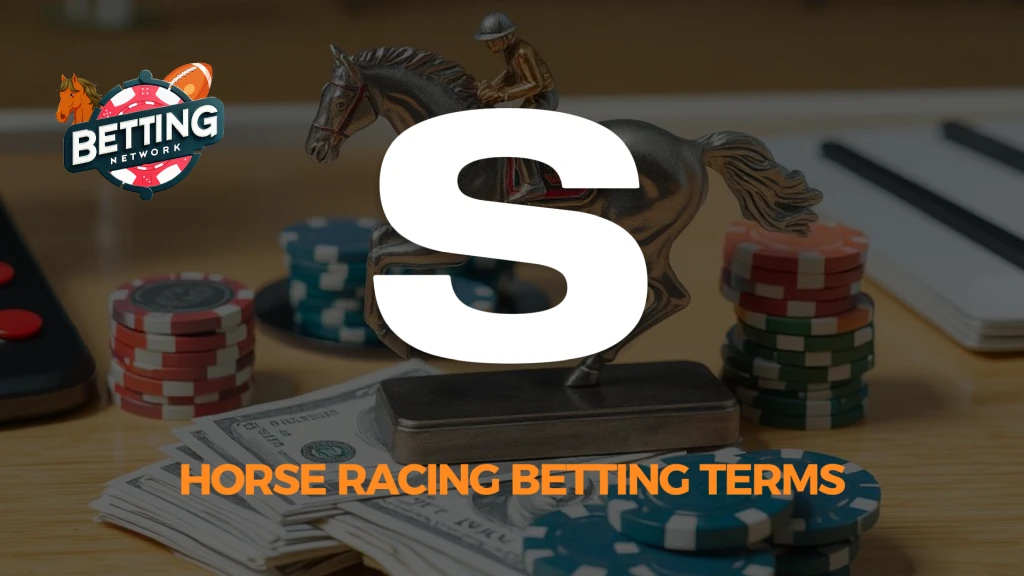
Scratch: The withdrawal of a horse from a race after it has been entered.
Example: “Horse #7 was scratched just before the race due to a minor injury. He’ll be back on the tracks soon, no worries.”
Selection: The horse chosen by a punter or tipster as the best chance of winning.
Example: “My selection for the next race is Horse #5; it’s been running well recently.”
Show: Finishing third in a race, which is the last position that pays out in a standard bet.
Example: “Horse #8 managed to show, so my bet still paid out even though it didn’t win. Talk about a lucky break!”
Show bet: A bet where you wager on a horse to finish first, second, or third.
Example: “I played it safe with a show bet on Horse #6; as long as it places, I’ll win something.”
Sire: The father of a horse.
Example: “This colt’s sire was a champion sprinter, so I expect it to be fast too.”
Silks: The colorful jacket and cap worn by jockeys, representing the horse’s owner.
Example: “The jockey’s silks are bright yellow with a red star, easy to spot during the race.”
Sires Stakes: A series of races restricted to horses sired by a specific group of stallions.
Example: “This horse is eligible for the Sires Stakes because its sire is registered in the program. The race is going to be one for the ages!”
Speed Figure: A numerical rating assigned to a horse’s performance in a race, taking into account the time and level of competition.
Example: “Horse #2 has the highest speed figure in the race, so it’s likely to be the favorite.”
Sprinter: A horse that specializes in short-distance races.
Example: “This sprinter excels at six furlongs but struggles with longer distances. This race won’t be over until the end, so don’t celebrate too soon.”
Stallion/Stallion (STUD): A male horse that has not been castrated and is used for breeding.
Example: “After a successful racing career, this stallion will stand at stud. He’ll father many racers after he’s done here.”
Stakes/Stakes Races: Races with high prize money, often requiring owners to pay an entry fee.
Example: “The stakes races today include some of the best horses in the country competing for big purses. A legend will be born here today.”
Starting Gate: The apparatus that holds horses in place before the start of a race, then opens to let them begin.
Example: “The horses are loaded into the starting gate, and as soon as it opens, the race begins.”
Starting Price (SP): The odds on a horse at the time the race starts. This is the final price you’ll get if you didn’t take the odds earlier.
Example: “I didn’t like the early odds, so I took the Starting Price (SP) instead. I’m happy with my choice.”
Steamer: A horse whose odds have shortened significantly due to a lot of money being bet on it.
Example: “Horse #7 has become a steamer; its odds dropped from 10-1 to 4-1. I could see this coming, he looked well on the paddock.”
Stewards: Officials responsible for enforcing the rules and ensuring fair play during a race.
Example: “The stewards are reviewing the race to make sure no rules were broken.”
Stewards’ Inquiry: An investigation by the stewards into a possible rule infraction during a race.
Example: “There’s a stewards’ inquiry after that close finish to check for interference. We have to wait for the judge before its official.”
Stretch: The final straight portion of the track leading to the finish line.
Example: “Horse #5 took the lead in the stretch and never looked back. It was the most exciting finish I’ve seen in years!”
Stud: A stallion used for breeding.
Example: “After winning several races, this horse is now standing at stud. He’ll father many future racers, and is the stable’s crown jewel.”
Sulky: The two-wheeled cart pulled by a Standardbred horse in harness racing, where the driver sits.
Example: “In harness racing, the driver sits in a sulky behind the horse.”
Superfecta: A bet where you must pick the first four finishers in exact order.
Example: “I tried a superfecta, picking Horses #2, #5, #7, and #8 to finish 1st, 2nd, 3rd, and 4th. It’s risky, but the payout was too good to pass on.”
Superfecta Box: A superfecta bet where you pick four horses to finish in the top four positions in any order.
Example: “I boxed my superfecta, so my four horses can finish in any order. It was a bit more expensive, but it won’t matter if I win.”
Suspend (Suspension): The temporary banning of a jockey or trainer due to breaking the rules.
Example: “The jockey was suspended for careless riding in yesterday’s race. The horse’s owners are furious.”
Syndicated: When a racehorse is owned by a group of people who share the costs and winnings.
Example: “This horse is syndicated, so several people own shares in it.”
Horse Racing Terms: Letter T
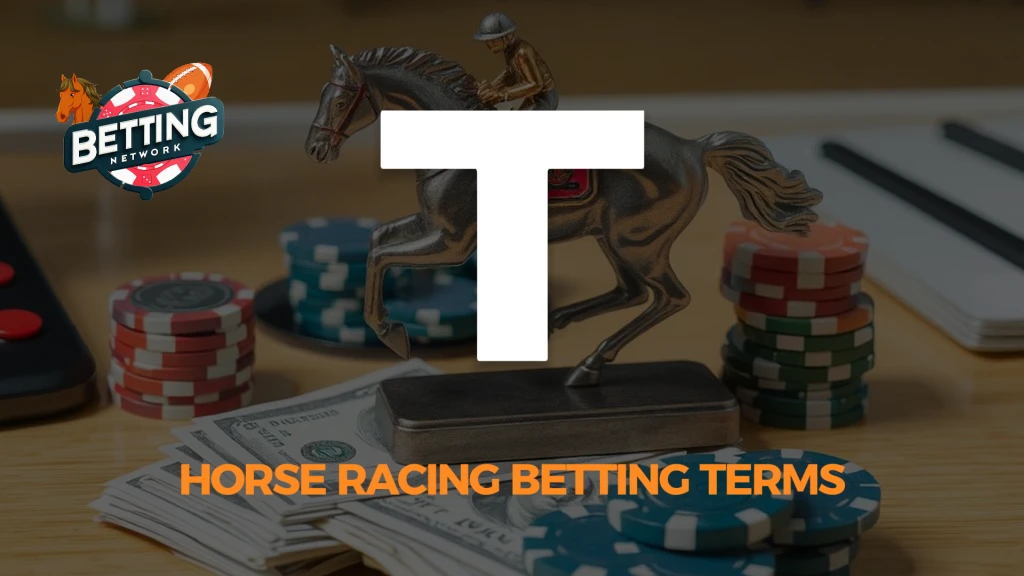
Tack: The equipment used to ride or drive a horse, including the saddle, bridle, etc.
Example: “The jockey made sure all the tack was secure before the race. He’s a real pro, so I’m sure he’ll do fine.”
Take (Takeout): The percentage of the betting pool that is kept by the track before paying out winnings.
Example: “The takeout on that race was 15%, which goes to the track and other fees.”
Tips: Selections or advice from experts on which horse might win a race.
Example: “I got a tip from an insider that Horse #4 is in top form today. This guy is usually right on the money, so I changed my bet at the last minute.”
Tongue-strap: A piece of equipment used to tie down a horse’s tongue, often to prevent it from getting in the way of breathing.
Example: “The trainer decided to use a tongue-strap to help the horse breathe better during the race. I’m glad they realized on time.”
Tote: A system of betting where all bets are pooled together, and payouts are calculated after the race.
Example: “I placed my bet at the tote window, so I’ll get whatever the final odds are.”
Tote Board: The electronic display that shows the odds, betting pools, and other race information.
Example: “Check the tote board to see the current odds before placing your bet.”
Track Record: The fastest time ever recorded for a specific distance at a particular track.
Example: “Horse #3 just broke the track record for 6 furlongs! The race wasn’t even close, I’m glad my horse at least placed.”
Triactor: A bet where you pick the first three finishers in exact order.
Example: “I placed a triactor on Horses #1, #4, and #7 to finish in that order.”
Triactor Box: A triactor bet where the three horses you pick can finish in any order.
Example: “By boxing my triactor, I just need my three horses to finish in the top three, no matter the order.”
Triple Crown: A series of three prestigious races for Thoroughbred horses, usually the Kentucky Derby, Preakness Stakes, and Belmont Stakes.
Example: “Winning the Triple Crown is the ultimate achievement in horse racing.”
Trixie: A bet consisting of four bets on three selections: three doubles and one treble.
Example: “I placed a Trixie on these three horses, so I just need two to win to get a return. Wish me luck!”
Trot: A gait in harness racing where the horse moves its legs in diagonal pairs.
Example: “That horse is a trotter, so it races at a trot instead of a gallop.”
Trot Monte: A type of harness racing where the jockey rides the horse instead of driving it in a sulky.
Example: “Trot Monte is gaining popularity because it combines elements of both harness and flat racing. Jockeys are trying it out more and more.”
Turn of foot: A horse’s ability to accelerate quickly during a race.
Example: “That horse has a great turn of foot; it can really speed up in the final stretch. I’m the kind of guy that bets on strong finishers, so he’s my pick.”
Horse Racing Terms: Letter U
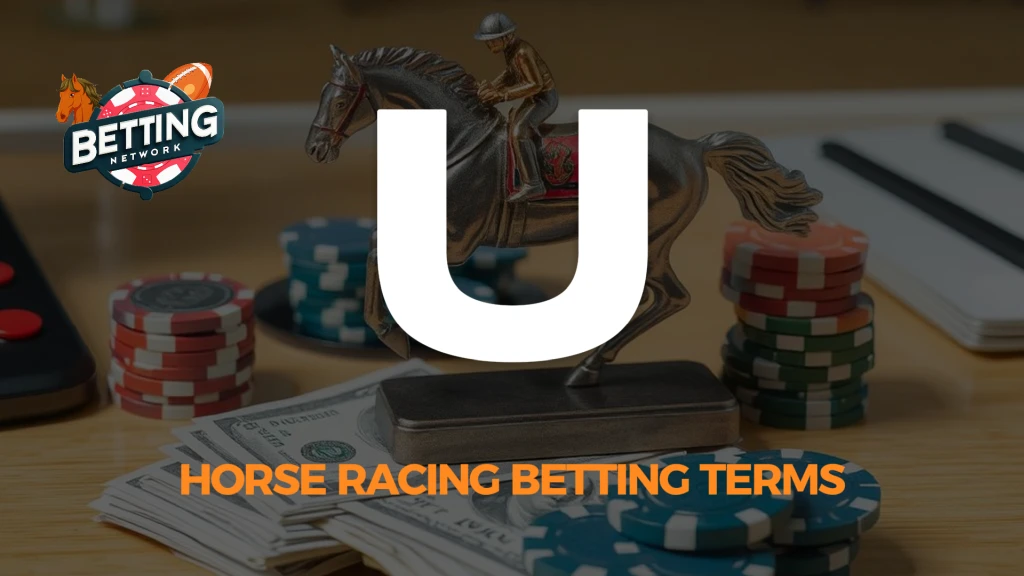
Underlay: A horse that is considered to have lower odds than its chances of winning justify.
Example: “Horse #8 is an underlay; the odds don’t seem to reflect its true chances according to my tipster.”
Horse Racing Terms: Letter V
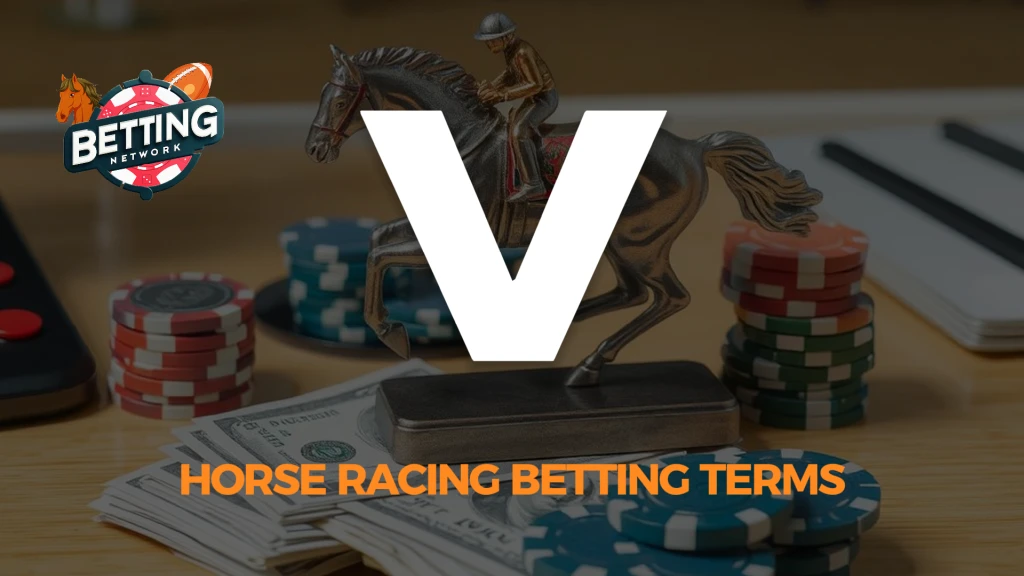
Visor: A piece of headgear that partially covers a horse’s eyes to help it focus.
Example: “The trainer put a visor on Horse #3 to keep it from being distracted. This is the kind of stuff you only realize after hours and hours of training.”
Horse Racing Terms: Letter W
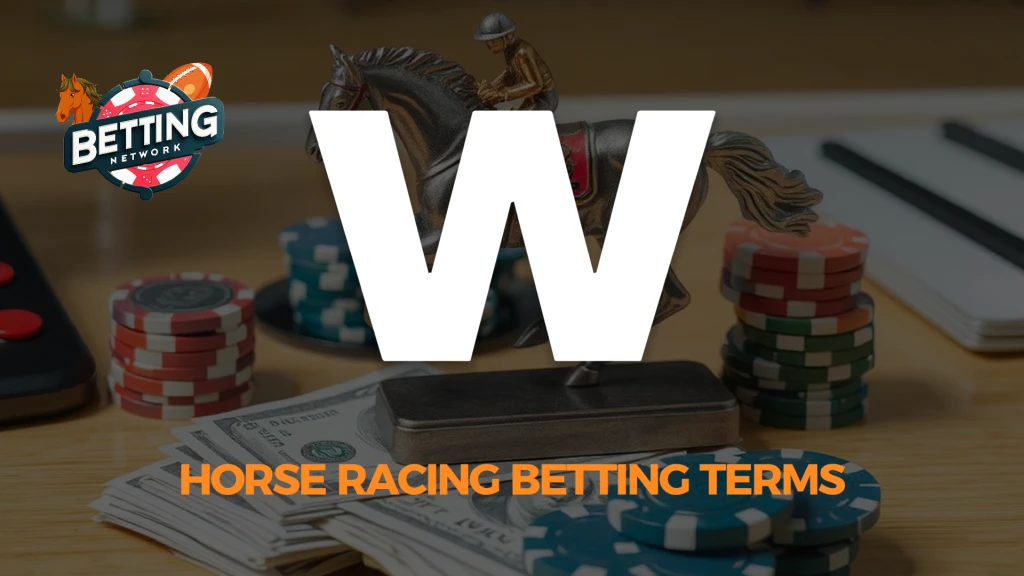
Wager/Wagering: The act of placing a bet on a horse race.
Example: “I’m wagering $20 on Horse #5 to win.”
Warming Up: When a horse exercises before a race to prepare its muscles.
Example: “The horses are warming up on the track before heading to the starting gate.”
Weanling: A young horse that has been weaned off its mother’s milk.
Example: “This weanling will be trained for racing in a year or two. He comes from a Stud that won everything a few years back, so we’re following him closely.”
Weighed-in: The process where jockeys are weighed after a race to ensure they carried the correct weight.
Example: “The results are official now that all the jockeys have weighed-in.”
Wheel: An exotic bet where one horse is used in multiple combinations with other horses.
Example: “I wheeled Horse #1 with the field in the exacta, so it just needs to finish first.”
Weight: The amount of weight a horse carries in a race, including the jockey and equipment.
Example: “Horse #4 is carrying an extra 5 pounds due to its last win.”
Win/Win (Bet): A bet where you pick a horse to finish first.
Example: “I put $50 on Horse #2 to win. It’s a simple bet, but I’m confident in my pick.”
Winnings: The money you collect if your bet is successful.
Example: “My winnings from that race were double my original bet. The drinks are on me today!”
Horse Racing Terms: Letter Y
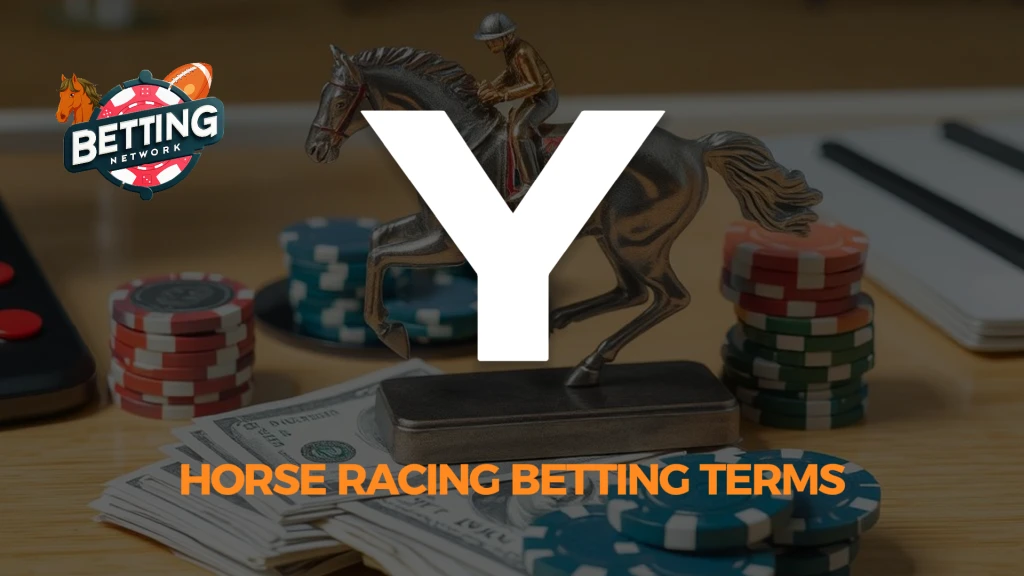
Yearling: A horse that is between one and two years old.
Example: “This yearling looks promising and might start racing next year.”
Yankee: A bet consisting of 11 bets on four selections: six doubles, four trebles, and one fourfold.
Example: “I placed a Yankee, so I just need a few of my horses to win for a decent payout. I’m a lucky guy, though, so I’m not worried.”
There’s a very long list of horse racing betting terms you’ll need to know if you want to be a master of the tracks. Honestly, you’ll get the most value out of covering the fundamental terms and then building an index for the most specific ones.
We’ve organized everything to save you the troubles of going through 10 different sources for a technical, niche term.
Must-Know Horse Racing Betting Terms

There’s a bit of nuance when it comes to Horse Racing Bets. Let’s start with “Win, Place, Show” which you’ll hear all the time in horse racing. The easiest, most simple way to bet on a horse race is to go for “Win, Place, Show”
Win is as simple as betting on a horse to come in first place. If your horse wins, you win the bet. On the other hand, Place has some more leeway: You bet on a horse to come in first or second place (If your horse finishes in either of those positions, you win the bet but the payout is usually less than a Win).
Last but not least, Show lets you bet on a horse to finish in the top three (first, second, or third). This type of bet offers the highest chance of winning but with the smallest payout.
Important Note
You can also bet “Across the Board,” which gives you multiple chances to win based on how well a given horse performs.
Let’s say that you place a Win, Place, and Show bet on the same horse: If the horse wins, you collect on all three bets. If it comes in second, you collect on the Place and Show bets. If it finishes third, you only collect on the Show bet.
Horse Racing Terms : Exacta, Trifecta and Superfecta

These bets are all about predicting the top finishers in a race, which is harder to do but obviously offers better payouts. Let’s go over each.
Exacta
You’re betting on which two horses will finish first and second in exact order. For instance, if you bet on Horse A to win and Horse B to come second, they must finish in that exact order for you to win. Exacta bets are a bit challenging but has a better payout.
Trifecta
This bet it’s even riskier than an Exacta: you’re predicting the first, second, and third place finishers in exact order. If you bet on Horse A to win, Horse B to place second, and Horse C to show third, they must finish in that exact sequence, otherwise you lose the entire Trifecta bet.
Superfecta
The Superfecta horse racing bet is the most challenging of them all: similar to the trifecta, you’re betting on the top four finishers in exact order. This means predicting which horses will come in first, second, third, and fourth (obviously the higher the risk, the bigger the reward).
Pick 3, 4 and Daily Double Horse Racing Bets and Terms

These bets string together different races to offer some massive payouts. If you like Parlays, then Daily Double, Pick 3, and Pick 4 are the ones for you. These are all about predicting the winners of multiple races, and they’re the perfect way to stretch your bet across a few races.
Daily Double
With a Daily Double, you’re betting on the winners of two consecutive races. Let’s say you pick Horse A to win the first race and Horse B to win the second. Both horses must win their respective races for you to cash in (it’s like combining two-win bets into one).
Pick 3
Instead of just picking two winners, you’re betting on the winners of three consecutive races. If you’re confident in your picks, this can be a great way to turn a small bet into a big win. But keep in mind: all three horses must win their races for you to win the bet!
Pick 4
With the Pick 4 horse racing bet you try to predict the winners of four consecutive races. It definitely raises the bar, since its obviously tougher to nail all four picks. If you’ve done your homework and feel good about your picks, your wins could be massive.
Box, Key and Wheel Horse Racing Betting Terms

Box, Key, and Wheel bets are a track veteran’s boon: you can bet big on a horse to take the race, but also cover some additional positions. What makes this bet more appealing than others is that you don’t have to get the exact order or position of the horses right to win big.
It does, however, add a layer of strategy and can increase your chances of winning, making them great choices for races with a lot of strong contenders. Let’s take a look at each:
Box Bet
A Box bet allows you to cover multiple combinations for a set of horses regardless of the exact order they finish in. Let’s say you’re betting on an Exacta Box with Horses A, B, and C. With this bet, you’re covering all possible combinations of these horses finishing first and second. So, as long as two of your three horses come in first and second, you win. It’s like spreading your chances across different outcomes.
Key Bet
A Key bet is more focused. You’re betting that one particular horse (your “key”) will finish in a specific position, with all the other horses you’re betting on filling the remaining spots. For instance, if you think Horse A is going to take the win, you would place a Key Exacta bet where Horse A must finish first, then you can pick Horses B, C or even D to finish second. If Horse A wins and one of your other picks comes second, you’re in the money.
Wheel Bet
A horse racing Wheel bet is about maximizing your chances by betting on one horse to finish in a particular position, with any number of other horses filling the remaining spots. There are two types:
- Full Wheel: You pick one horse to finish in a specific position, and you cover all other horses to finish in the remaining positions. You could bet on Horse A to finish first, with any other horse to finish second (if it’s an Exacta) or third (if it’s a Trifecta).
- Part Wheel: You pick your horse to finish in a specific position, but you also narrow down the other horses you think have a chance to fill the remaining spots. It’s great when you got other solid horses competing in the race, since you can spread your risk across several combinations.
Horse Racing Betting Terms You’ll Need to Know

There are some horse racing terms that will instantly help you make better decisions at the track. These will help you better understand how different factors actually influence the outcome of a race, so if any of these shifts, you’ll know how to find even more value in your bets.
Let’s go through these real quick.
Morning Line
The Morning Line is an estimate of what the odds on each horse will be by the time the race starts. It’s set by the track handicapper before betting opens. Think of it as a starting point for odds, not the final say. If you see a horse with 5-1 odds on the Morning Line, it means the handicapper thinks that horse has a reasonable chance, but the odds can change based on how much money is bet on it.
Overlay
An Overlay happens when a horse’s odds are higher than they should be, based on its chances of winning. For example, if you believe a horse should be a 3-1 shot but the betting public has it at 6-1, that’s an Overlay. Betting on Overlays is a good strategy because you’re getting better value for your money.
Underlay
An Underlay is the opposite of an Overlay. It’s when a horse’s odds are lower than they should be, given its chances of winning. If a horse should be at 5-1 but is instead at 2-1, that’s an Underlay. These bets offer poor value because you’re getting less return on a horse that might not have a great chance of winning.
Speed Figures
Speed Figures are a numerical representation of how fast a horse ran in a race, adjusted for track conditions and other variables. They’re useful for comparing horses across different races and tracks. The higher the number, the faster the horse.
Beyer Speed Figures
Beyer Speed Figures are a specific type of Speed Figure created by Andrew Beyer, a well-known handicapper. These figures are widely used in the U.S. and can be found in most race programs. They’re calculated based on the horse’s performance relative to the track record for that distance. A horse with a Beyer Speed Figure of 90 is considered fast, while anything over 100 is exceptional.
Horse Racing Track Terms: Fast, Good, Yielding, Soft

These terms relate to the condition of the turf (grass) track:
- Fast: A dry, firm track that provides ideal racing conditions.
- Good: A track that’s a bit softer than fast, often after light rain.
- Yielding: A track that’s softer and slower, typically after more substantial rain.
- Soft: The slowest track condition, very soft and wet, making it tough for horses to run their fastest.
Off Track, Sloppy
Both of these describe the condition of a dirt track:
- Off Track: A general term for any track that isn’t fast, meaning it’s been affected by rain.
- Sloppy: A track with a lot of water on the surface but still firm underneath. Horses splash through the mud, and some love it, while others don’t perform as well.
A List of Horse Racing Betting Terms (With Examples!)
Last but not least, we wanted to give you a comprehensive list or index of horse racing betting terms so you don’t have to search all over the place for the technical, most elaborate ones. As always, managing your bankroll its a skill on its own so always be mindful about it when betting on horses.
Horse Racing Terms: Letter A

Abandoned: When a race gets called off due to bad weather.
Example: “The heavy rain caused the races to be abandoned. All bets got refunded and I went home early.”
Account wagering: Betting by internet or phone with a pre-funded account. Example: “I placed my bet through account wagering on my favorite horse from home.”
Across the Board: A bet on a horse to win, place, and show.
Example: “I bet across the board on Horse #5. As long as it finishes in the top three, I’ll get some cash.”
Accumulator: A bet on multiple selections where winnings from one bet roll onto the next.
Example: “I made an accumulator bet on four races; I know it’s a bit of a longshot, but if all my horses win, I’ll be a happy man.”
Added Money: Extra funds added to the purse of a race by sponsors.
Example: “The local sponsors really added money to the purse, so the stakes are high”
Age: The age of a horse, critical in determining race eligibility.
Example: “Only 3-year-old horses are allowed to race in this derby.”
Aged: A horse that is four years old or older.
Example: “That aged mare is a track veteran, so she’s a favorite.”
Allowance: Weight adjustments based on age, sex, or past performance.
Example: “This filly gets an allowance, carrying less weight than her male competitors. It should level the playing field for sure”
Allowance Race: A race with specific conditions where horses carry weights based on past performances.
Example: “The allowance race today will level the playing field for younger horses, so it got real interesting.”
Also-eligible: A horse entered but only allowed to run if others are scratched.
Example: “The horse was also-eligible, but got to run when another horse dropped out.”
Apprentice: A jockey who is still learning, often given weight allowances.
Example: “The apprentice jockey’s 5-pound allowance could give his horse an edge.”
Ante post: Betting before the day of the race. These bets often come with higher risks and rewards.
Example: “I placed an ante post bet on the Derby last month, hoping for better odds.”
At the Post: The moment when horses line up for the race to start.
Example: “The horses are at the post, so action is about to begin!”
Horse Racing Terms: Letter B

Baby Race: A race exclusively for two-year-olds.
Example: “I heard today’s baby race has some future stars lined up for their first competition!”
Back: To bet on a horse.
Example: “I’m backing Horse #7 to win today’s race.”
Backstretch: The straight part of the track opposite the grandstand.
Example: “The horse gained speed on the backstretch, setting up for a strong finish.”
Banker: A horse believed to have a very strong chance of winning.
Example: “Horse #3 is my banker for this race; I’m confident it’ll win.”
Bay: A horse color that’s brown with black mane, tail, and lower legs.
Example: “That bay horse is gorgeous. Just look at its shiny coat!”
Bearing In (or out): When a horse deviates from a straight course.
Example: “Horse #6 bore out in the final stretch, I was losing my mind!”
Betfair: An online betting exchange where bettors wager against each other.
Example: “I prefer Betfair because I can get better odds by betting against other players.”
Betting Exchange: A platform where people bet against each other rather than a bookmaker.
Example: “Using a betting exchange, I laid a bet against Horse #4 winning.”
Betting In Running: Placing bets during the actual race.
Example: “I waited until the final turn to place my bet in running. A bit risky, but I always get better odds.”
Betting Ring: The area at a racetrack where bookmakers take bets.
Example: “The betting ring got real crowded as the big race approached.”
Black: A horse with a completely black coat.
Example: “That stunning black stallion is the favorite in today’s race.”
Black Type: Refers to horses that have been placed in a Group or Listed race, enhancing their breeding value.
Example: “This mare has black type in her pedigree. Her offspring are gonna cost a pretty penny.”
Blacksmith: A person who shoes horses.
Example: “The blacksmith worked around the clock so that all the horses would have the right shoes for the race.”
Blinkers: Headgear that limits a horse’s vision to help it focus.
Example: “The trainer added blinkers to help the horse concentrate during the race.”
Bloodstock: Refers to the breeding industry, including horses bred for racing.
Example: “He’s invested heavily in bloodstock, hoping to breed the next champion.”
Bookie: A bookmaker who takes bets.
Example: “I placed my bet with the bookie at the trackside.”
Box: A betting term for selecting multiple horses in a bet to cover all possible combinations.
Example: “I boxed my exacta, so I’ll win if either Horse #2 or #5 finishes first or second.”
Boxed In: When a horse is trapped and unable to move forward in a race.
Example: “Horse #4 got boxed in and couldn’t make a run in the final stretch, it was so unlucky!”
Break: The start of the race when horses leave the starting gate.
Example: “Horse #3 had a slow break but really closed the distance quickly.”
Bridge jumper: A bettor who places large show bets on heavily favored horses.
Example: “The bridge jumper bet big on the favorite, hoping for a guaranteed small return.”
Bridle: The headgear used to control a horse.
Example: “The bridle slipped, making it harder for the jockey to steer the horse.”
Broodmare: A female horse used for breeding.
Example: “This broodmare has produced several successful racehorses.”
Brown: A horse color with a brown body and black points.
Example: “The brown colt is known for its speed in the final furlong.”
Buckskin: A horse color with a yellow or gold body and black points.
Example: “The buckskin horse stood out with its unique color among the field.”
Bullet: The fastest workout of the day at a track.
Example: “Horse #8 had a bullet workout, so he’s a top contender for sure, at least today.”
Bumper: A flat race for National Hunt horses to prepare them for jumping.
Example: “The bumper race was an excellent warm-up for the young jumpers.”
Horse Racing Terms: Letter C

Canadian: A bet consisting of 26 separate bets on five horses in different races.
Example: “I placed a Canadian bet today, so I’m feeling very lucky. If my selections do well, I’m buying lunch!”
Canadian Pari-Mutuel Agency (CPMA): The regulatory body overseeing pari-mutuel betting in Canada.
Example: “The CPMA ensures that all bets are fair and transparent.”
Card: The schedule of races for a day.
Example: “There are 10 races on today’s card, with the first one starting at noon.”
Cash out: Taking a payout before a bet is settled, usually at reduced odds.
Example: “I decided to cash out early when my horse took the lead.”
Chalk: The betting favorite in a race.
Example: “Horse #3 is the chalk, so it’s the one everyone expects to win.”
Chalk player: A bettor who typically wagers on favorites.
Example: “As a chalk player, he always bets on the favorite, hoping for a safer win.”
Chart: A detailed record of a race showing the positions and performances of horses.
Example: “Check the chart to see how your horse performed throughout the race.”
Chase: A race over steeplechase fences, typically in National Hunt racing.
Example: “He excels in chases, clearing obstacles with ease.”
Cheekpieces: Strips of sheepskin attached to the bridle to help the horse focus.
Example: “They added cheekpieces to help the horse concentrate during the race.”
Chestnut: A horse color ranging from light brown to reddish-brown.
Example: “The chestnut colt in the third race has a gorgeous coat.”
Claiming Race: A race where each horse can be purchased at a set price.
Example: “In this claiming race, any horse can be bought for $20,000.”
Classic: A prestigious race, usually for three-year-olds, like the Kentucky Derby.
Example: “Winning a classic race instantly boosts a horse’s value.”
Claimer: A horse entered in a claiming race.
Example: “That claimer was picked up by a new owner after yesterday’s race.”
Clerk of the Course: The official responsible for the racetrack and racing conditions.
Example: “The Clerk of the Course declared the track safe despite the rain.”
Closer: A horse that performs best in the latter part of the race.
Example: “Watch out for Horse #7, a strong closer that comes from behind.”
Colt: An intact male horse under four years old.
Example: “The two-year-old colt shows great promise for future races.”
Colours: The jacket and cap worn by the jockey, representing the horse’s owner.
Example: “The jockey’s colors are green and white, matching the owner’s stable.”
Connections: The people associated with a horse, including the owner, trainer, and jockey.
Example: “The connections were thrilled with their horse’s performance today.”
Horse Racing Terms: Letter D

Dam: The mother of a horse.
Example: “This filly’s dam was a champion racer herself.”
Daily Double: A bet on the winners of two consecutive races.
Example: “I placed a Daily Double on races 2 and 3, hoping both my horses win.”
Dead Heat: When two or more horses finish exactly together.
Example: “It was a dead heat for first place, so the payout got split.”
Derby: A race for three-year-old horses.
Example: “The Kentucky Derby is the most famous Derby in the U.S.”
Disqualification: A horse is removed from its finishing position for breaking a rule.
Example: “Horse #5 was disqualified for interference, so it lost the win.”
Distaff: A race for female horses.
Example: “She’s running in the Distaff, competing only against other fillies and mares.”
Distanced: When a horse finishes far behind the winner.
Example: “The horse was distanced, coming in more than 20 lengths behind, it was tough to watch.”
Dividend: The return you receive from a bet.
Example: “The dividend on my win bet was way higher than I expected, so lunch is on me boys!”
Double: A bet on two selections in different races, both must win.
Example: “I made a double bet on races 4 and 5, so both horses need to win.”
Drift: When a horse’s odds increase before the race.
Example: “The favorite drifted to 5/1 just before the start, which was crazy.”
Driver: The person who steers the horse in harness racing.
Example: “The driver expertly guided the trotter to victory right at the final stretch.”
Dutch: Placing a bet on more than one horse in a race, ensuring profit if any of them wins.
Example: “I dutched the race by betting on three horses with favorable odds.”
DQ: Abbreviation for disqualification.
Example: “Horse #8 was DQ’d for veering into another horse’s path.”
Horse Racing Terms: Letter E

Each way: A bet where you win if your horse finishes in the top three.
Example: “I placed an each-way bet, so I’ll still collect if my horse finishes second or third.”
Early and Late Closing Events: Races requiring nominations and payments before the event.
Example: “He entered his horse in an early closing event last month.”
Eighth: A measurement of distance in a race, equivalent to one-eighth of a mile.
Example: “The horse gained two lengths in the final eighth of the race.”
Entry: Two or more horses with the same owner, running as a single betting unit.
Example: “The entry includes Horses #1 and #1A, so betting on one covers both.”
Equipment: The gear a horse wears during a race, like blinkers or a saddle.
Example: “The trainer added new equipment, hoping it improves the horse’s focus.”
Evens: Odds of 1/1, meaning you double your money if you win.
Example: “At evens, a $10 bet will return $20 if the horse wins.”
Exotic (bet): A bet on something other than just win, place, or show.
Example: “I tried an exotic bet with a trifecta, picking the top three finishers in order.”
Exactor: A bet where you predict the first two finishers in exact order.
Example: “I hit the exactor with Horses #2 and #5 finishing first and second.”
Exactor Box: A bet covering all possible combinations of two horses finishing first and second.
Example: “I boxed the exactor, so I win if my two horses finish in any order.”
Horse Racing Terms: Letter F

Favourite: The horse with the shortest odds to win.
Example: “Horse #6 is the clear favorite, with everyone betting on it to win.”
Farrier: A person who shoes horses.
Example: “The farrier came to check if the horse’s shoes were fitted correctly.”
Fast Track: A dry, even track considered ideal for racing.
Example: “With the fast track today, we should see some quick times.”
Field: Refers to all the horses running in a race.
Example: “Calling a race with 12 horses in the field is pretty difficult.”
Filly: A female horse under the age of four.
Example: “This two-year-old filly has shown a lot of promise so far.”
First Over: The first horse to move outside and challenge the leader in a race.
Example: “Horse #4 was first over, he’s gonna try to overtake the leader in the final stretch.”
Foal: A horse that is less than one year old.
Example: “That foal will start training once it’s a bit older.”
Fold: Refers to the number of selections in an accumulator bet.
Example: “I placed a fourfold bet, meaning all four of my picks must win.”
Form: The performance record of a horse in previous races.
Example: “Looking at the form, Horse #7 has been consistently placing in the top three.”
Free-legged: A pacer that races without hopples, which help maintain its gait.
Example: “This horse races free-legged, so it has a very natural stride.”
Front-runner: A horse that likes to lead from the start of the race.
Example: “Horse #2 is a front-runner, so expect it to be ahead early on.”
Furlong: A measure of distance in a race, equal to one-eighth of a mile.
Example: “The race is 6 furlongs, so it’s a short sprint to the finish.”
Horse Racing Terms: Letter G

Gallop: The fastest gait of a horse, used in most races.
Example: “The horses were at full gallop as they neared the finish line.”
Gate: The starting mechanism that holds horses before the race begins.
Example: “The horses loaded into the gate, ready for the start.”
Gelding: A castrated male horse, often calmer and more focused.
Example: “This gelding has been running well since the change.”
Goliath: A massive bet covering eight selections with 247 separate bets.
Example: “I tried a Goliath bet, covering every possible combination for these eight races.”
Good Track: A track condition between fast and slow, offering fair footing.
Example: “We got a good track today, so things should get interesting!”
Going: The condition of the race track, ranging from firm to heavy.
Example: “The going is soft, which might slow down the race.”
Graded race: A high-level race classified into Grade 1, 2, or 3 based on quality.
Example: “If the horse can win this Grade 1 race, its breeding value is gonna go way up!”
Grey: A horse with a coat color that mixes black and white hairs.
Example: “Take a look at that grey horse! Everyone’s looking at it!”
Groom: The person responsible for the daily care of a racehorse.
Example: “The groom was up early to prep the horse for race day.”
Horse Racing Terms: Letter H

Handle: The total amount of money wagered on a race or series of races.
Example: “The handle for the Derby was crazy. It exceeded $100 million this year.”
Handicap: A race in which horses carry different weights (based on their past performances) to even the competition.
Example: “Before you place your bet, I wanted to let you know that the favorite is carrying an extra 5 pounds.”
Handicapper: A person who assesses the form of horses and predicts the outcome of races.
Example: “The handicapper thinks Horse #3 has a good shot based on its recent form and track conditions, so that’s promising.”
Hand: A unit of measurement (equal to four inches). It’s used to measure a horse’s height at the shoulder.
Example: “That horse stands 16 hands tall, so just about average for a thoroughbred.”
Head: A small distance between horses, often used to describe a close finish.
Example: “I can’t believe that Horse #6 won by a head! I could’ve made a lot of money.”
Head of the Stretch: The beginning of the final straight part of the track leading to the finish line.
Example: “Thing’s got pretty heated by the head of the stretch, the horses really kicked it up a notch”
Heinz: A bet involving six selections with 57 separate bets.
Example: “I placed a Heinz bet on these six races, so I pretty much covered every possible outcome.”
Home Stretch: The final straight portion of the track before the finish line.
Example: “The horses are in the home stretch now; it’s anyone’s race.”
Hood: A piece of equipment placed over a horse’s head to cover its ears and limit noise.
Example: “The horse is known to get distracted, so they’re racing it with a hood to keep it focused”
Hopples: Straps used on pacers to help maintain their pacing gait.
Example: “The pacer needs hopples to keep its stride fluid throughout the entire race.”
Horse: A mature male horse, typically over four years old.
Example: “The track favors this Horse, at least that’s what the record shows.”
Hurdles: Obstacles that horses jump over in certain types of races, mainly in National Hunt racing.
Example: “That horse is a pretty strong hurdler; it’s clearing all the obstacle like they’re nothing!”
Horse Racing Terms: Letter I

In Running: Betting on a horse during the actual race, while it’s happening.
Example: “Soon as I saw Horse #3 gaining on the leader, I made an in-running bet.”
In the frame: A horse that finishes in the top three positions.
Example: “Horse #5 was in the frame. It didn’t win, but it finished second and I still got paid.”
Inquiry: A review by race officials to see if any rules were broken throughout the race.
Example: “There’s an inquiry into possible interference during the final stretch. Apparently Horse #2’s win wasn’t legitimate.”
Invitational (Open or Free For All): These are high-stakes race for some of the best horses around. They’re often invite-only.
Example: “Horse #6 got invited to the invitational. It’s a really prestigious race with an even larger purse, so I have faith in him.”
Horse Racing Terms: Letter J

Joint favourite: When two horses share the shortest odds in the betting.
Example: “There’s a couple of joint favorites for the upcoming race, they both sit at 3/1.”
Jolly: A slang term for the favorite horse in a race.
Example: “Horse #3 is the jolly for the race, it’s made me a lot of money before so I’m backing it.”
Judge: The official who determines the order of finish in a race.
Example: “The judge went through the photo finish and gave Horse #7 the win”
Jockey: The person who rides the horse in a race.
Example: “The jockey made a brilliant move on the outside to take the lead.”
Horse Racing Terms: Letter K

Key horse: The main horse in a bet that is used in multiple combinations in an exotic wager.
Example: “I keyed Horse #5 in my trifecta, meaning it must finish first, second, or third for my bet to pay off.”
Horse Racing Terms: Letter L

Lasix: A diuretic medication given to a horse to prevent bleeding in the lungs during a race.
Example: “Horse #4 can run for sure, but he needs to be on Lasix if he wants to keep up.”
Late Double: A bet on the winners of the last two races of the day.
Example: “I placed a late double on the last two races, hoping to finish the day strong.”
Lay: Betting on a horse to lose rather than to win.
Example: “I decided to lay Horse #4, apparently they’re not giving him Lasix today so I doubt he’ll win.”
Length: A measurement that describes or estimates the distance between horses in a race. It’s approximately the length of a horse’s body.
Example: “Horse #6 won by three lengths from where I was standing, so it wasn’t even close.”
Listed Race: A race just below Group/Grade status, but still a high-quality event.
Example: “The listed race today features some promising young horses.”
Longshot: A horse with high odds, so not many expect it to win the race. If it does, the payouts could be huge though!
Example: “I need a big win, so I’m taking my chances on a longshot with 20/1 odds.”
Lucky 15: A bet consisting of 15 different bets across four selections: four singles, six doubles, four trebles, and one fourfold accumulator.
Example: “I was feeling cheeky today, so I played a Lucky 5 on these four horses. I hope at least one of them wins man.”
Horse Racing Terms: Letter M

Maiden: A horse that still hasn’t won a race.
Example: “This maiden is on its third race, so I’m banking on a break through today.”
Maiden Race: A race for horses that have never won a race.
Example: “This maiden race is full of young horses with a lot of potential. Whoever wins gets their first win.”
Market mover: A horse whose odds change significantly before the race due to betting activity.
Example: “Horse #8 is a market mover, its odds shortened real quick.”
Mare: A female horse aged five years or older.
Example: “This mare has a lot of experience on its side: it’s been racing for three seasons with solid placements.”
Morning line: The initial odds set by the track’s handicapper before any betting takes place.
Example: “The morning line had Horse #5 as the favorite, but the odds have shifted since then.”
Multiple: A bet consisting of more than one selection, such as a double, treble, or accumulator.
Example: “I placed a multiple bet on three races, I’m hoping I score big today!”
Mutuels: The area where you place your bets and collect winnings at the track.
Example: “My horse won, let me head to the mutuels to cash in my ticket.”
Horse Racing Terms: Letter N

Nap: The best bet of the day according to a tipster or expert.
Example: “The tipster’s nap for today is Horse #7 in the fourth race. I trust this dude, so I’m going all in.”
National Hunt: A type of horse racing that includes jumps, such as hurdles and steeplechases.
Example: “National Hunt racing is thrilling to watch, especially with those big jumps.”
Neck: A small margin of victory in a race, less than a length.
Example: “Horse #3 won by a neck in a close finish. I can’t believe I lost that bet!”
Non-runner: A horse that was scheduled to race but was withdrawn before the start.
Example: “There was a non-runner in the third race, so the field is smaller now. He wasn’t one of my picks either, so I’m good.”
Horse Racing Terms: Letter O

Objection: A claim of foul made by a jockey or steward after a race, potentially altering the result.
Example: “The jockey filed an objection, claiming interference in the final stretch. Let’s see what the ruling is, this could be big.”
Odds: The price at which a horse is offered in the betting market, representing the potential payout.
Example: “Horse #2 is currently at 5/1 odds, meaning a $10 bet would return $50 plus your stake.”
Odds-against: Odds greater than even money, meaning the potential payout is more than the stake.
Example: “At 2/1 odds-against, a $10 bet would win you $20 plus your original $10.”
Odds-on: Odds shorter than even money, meaning the potential payout is less than the stake.
Example: “Horse #1 is odds-on at 4/5, so you’d need to bet $5 to win $4.”
Official: The final result of a race, confirmed by the race stewards.
Example: “The results are now official; The interreference claim was dismissed and Horse #6 is the winner!”
Off the bridle: A horse that is being urged by the jockey, no longer running comfortably.
Example: “As they entered the final furlong, Horse #5 was off the bridle and struggling.”
Off Track: A track condition that is not fast, typically wet or muddy.
Example: “The off track today could make things tricky for the front-runners. I might go with a different horse this time.”
On the board: A horse that finishes in one of the top three positions, earning a payout for place or show bets.
Example: “Horse #4 finished second, so it was on the board, and I won my place bet.”
On the bridle: A horse running comfortably without needing much urging from the jockey.
Example: “Horse #3 is on the bridle and looks like it’s got plenty left in the tank. Let’s hope he takes the race!”
On the Nose: Betting on a horse to win only.
Example: “I bet $20 on the nose for Horse #2; it’s all or nothing.”
Ontario Racing (OR): The organization responsible for overseeing horse racing in Ontario, Canada.
Example: “Ontario Racing sets the rules and regulations for all the races in the province.”
Overlay: A horse whose odds are higher than its perceived chance of winning.
Example: “Horse #7 is an overlay at 10/1, so I’m placing a bet hoping for a nice return.”
Overnight Race: A race for which entries are taken 24 to 48 hours before it runs.
Example: “The overnight race card is out; let’s see who’s running tomorrow.”
Overweight: When a jockey weighs more than the assigned weight for the race, the extra weight is called overweight.
Example: “The jockey was carrying an extra pound of overweight, which might have affected the horse’s speed.”
Horse Racing Terms: Letter P

Pace: The speed at which the race is run, often dictated by the front-runners.
Example: “The pace was fast early on, which tired out some of the weaker horses. It really came down to just a handful of racers at the end.”
Pacesetter: The horse that leads the race in the early stages.
Example: “Horse #3 is known as a pacesetter, so expect it to take the lead right from the start. Some of the other horses seem weak, so #3 is a strong pick.”
Paddock: The area where horses are saddled and paraded before the race.
Example: “Let’s head to the paddock to see the horses up close before placing our bets.”
Pari-mutuel/Parimutuel: A betting system where all bets are pooled together, and the odds are determined by the amount of money bet on each horse.
Example: “In pari-mutuel betting, your payout depends on how much money is in the pool and how many people bet on the same horse.”
Parlay: A multi-race bet where winnings from one race are bet on the next.
Example: “I’m doing a parlay with races 3, 5, and 7; if I win the first race, the winnings go straight into the next bet.”
Part wheel: An exotic bet where you select a key horse to finish in a specific position and then choose other horses to finish in the remaining positions.
Example: “I bet a part wheel with Horse #2 to win and boxed the other spots with three other horses. If this goes well, then we’re going to my favorite restaurant!”
Parade Ring: Another term for the paddock where horses are paraded before the race.
Example: “Let’s check out the parade ring to get a good look at the horses before the race starts. I have a good feeling about #2 but I won’t know until I see him.”
Past Performances: A horse’s racing history, including previous race results, earnings, and other statistics.
Example: “I’m looking at the past performances to see which horse has been running well lately. It’s part of my pre-bet analysis.”
Patent: A bet that includes seven bets across three selections: three singles, three doubles, and one treble.
Example: “I placed a patent bet on these three horses, so even if only one wins, I still get a return.”
Penalty: Extra weight that a horse must carry in a race due to previous wins.
Example: “Horse #4 is carrying a penalty because it won its last race.”
Perfecta: A bet where you pick the first two finishers in exact order.
Example: “I placed a perfecta on Horses #1 and #3 to finish first and second in that order.”
Photo Finish: When the result of a race is so close that it requires a photo to determine the winner.
Example: “It was a photo finish, but Horse #5 just edged out Horse #6 for the win. I couldn’t believe it until I saw it, and the judge must’ve felt the same way.”
Pool: The total amount of money bet on a particular race or wager.
Example: “The win pool for this race is huge; there’s a lot of money on the line.”
Post Parade: The procession of horses from the paddock to the starting gate.
Example: “The post parade is starting; it’s get your game face on boys!”
Post Position: The position of a horse in the starting gate.
Example: “Horse #7 has a good post position on the outside, which might help it avoid traffic. He’s also a pacesetter so this could be huge.”
Post Time: The scheduled start time of a race.
Example: “We need to place our bets before post time; the race starts in five minutes.”
Price: Another term for the odds of a horse.
Example: “The price on Horse #4 has shortened; it’s now the favorite, which was fairly unexpected this morning.”
Pulled up: When a jockey stops a horse during a race, usually due to injury or exhaustion.
Example: “Horse #6 was pulled up halfway through the race; it didn’t look right. I sincerely hope the horse recovers soon.”
Punter: A person who places bets on horse races.
Example: “I’ve been a punter for years, and I love the thrill of picking winners.”
Purse: The total prize money for a race.
Example: “The purse for this stakes race is over $500,000. Imagine if some Local sponsors pitch in and make it even bigger!”
Pylon: Markers that outline the course, often used in harness racing.
Example: “The horse drifted out past the pylon, so it might get disqualified.”
Horse Racing Terms: Letter Q

Qualifier: A race where horses must perform to a certain standard to qualify for future races.
Example: “Horse #3 is running in a qualifier to earn a spot in next month’s big race.”
Quinella: A bet where you pick two horses to finish first and second in any order.
Example: “I placed a quinella on Horses #2 and #5; they just need to finish in the top two, the order doesn’t matter.”
Horse Racing Terms: Letter R

Rabbit: A horse entered in a race to set a fast pace for the benefit of another horse from the same stable.
Example: “Horse #1 is just a rabbit to tire out the field so its stablemate can win. That’s why I bet heavy on #7.”
Race: A competition between horses on a track, where the fastest horse wins.
Example: “The big race today is the Kentucky Derby, and all eyes are on the favorite.”
Race Secretary: The official who organizes races and assigns conditions for each race.
Example: “The race secretary decided to add another stakes race to tomorrow’s card.”
Race Under Saddle (RUS): A type of harness racing where the jockey rides the horse instead of driving it in a sulky.
Example: “I’ve never seen Race Under Saddle before; it’s like a mix of harness and flat racing.”
Racecard: The program that lists all the races, horses, jockeys, and other relevant information for a race day.
Example: “Grab a racecard so we can study the fields and pick our bets. We can’t really make a serious bet until we do.”
Rail: The barrier that runs around the inside of the race track.
Example: “Horse #4 is running along the rail, saving ground on the inside. The jockey really knows his horse, huh?”
Rank: A horse that is difficult to control, often pulling hard against the jockey’s attempts to slow it down.
Example: “Horse #3 is running rank; it’s wasting energy fighting the jockey. I’m glad I didn’t bet on them!”
Ridgling: A male horse with one or both testicles undescended.
Example: “The ridgling was gelded last week and should be easier to handle now.”
Roan: A horse with a coat that is a mix of white and colored hairs, often giving a speckled appearance.
Example: “That roan horse in the fourth race is still on my mind. What a beautiful color!”
Horse Racing Terms: Letter S

Scratch: The withdrawal of a horse from a race after it has been entered.
Example: “Horse #7 was scratched just before the race due to a minor injury. He’ll be back on the tracks soon, no worries.”
Selection: The horse chosen by a punter or tipster as the best chance of winning.
Example: “My selection for the next race is Horse #5; it’s been running well recently.”
Show: Finishing third in a race, which is the last position that pays out in a standard bet.
Example: “Horse #8 managed to show, so my bet still paid out even though it didn’t win. Talk about a lucky break!”
Show bet: A bet where you wager on a horse to finish first, second, or third.
Example: “I played it safe with a show bet on Horse #6; as long as it places, I’ll win something.”
Sire: The father of a horse.
Example: “This colt’s sire was a champion sprinter, so I expect it to be fast too.”
Silks: The colorful jacket and cap worn by jockeys, representing the horse’s owner.
Example: “The jockey’s silks are bright yellow with a red star, easy to spot during the race.”
Sires Stakes: A series of races restricted to horses sired by a specific group of stallions.
Example: “This horse is eligible for the Sires Stakes because its sire is registered in the program. The race is going to be one for the ages!”
Speed Figure: A numerical rating assigned to a horse’s performance in a race, taking into account the time and level of competition.
Example: “Horse #2 has the highest speed figure in the race, so it’s likely to be the favorite.”
Sprinter: A horse that specializes in short-distance races.
Example: “This sprinter excels at six furlongs but struggles with longer distances. This race won’t be over until the end, so don’t celebrate too soon.”
Stallion/Stallion (STUD): A male horse that has not been castrated and is used for breeding.
Example: “After a successful racing career, this stallion will stand at stud. He’ll father many racers after he’s done here.”
Stakes/Stakes Races: Races with high prize money, often requiring owners to pay an entry fee.
Example: “The stakes races today include some of the best horses in the country competing for big purses. A legend will be born here today.”
Starting Gate: The apparatus that holds horses in place before the start of a race, then opens to let them begin.
Example: “The horses are loaded into the starting gate, and as soon as it opens, the race begins.”
Starting Price (SP): The odds on a horse at the time the race starts. This is the final price you’ll get if you didn’t take the odds earlier.
Example: “I didn’t like the early odds, so I took the Starting Price (SP) instead. I’m happy with my choice.”
Steamer: A horse whose odds have shortened significantly due to a lot of money being bet on it.
Example: “Horse #7 has become a steamer; its odds dropped from 10-1 to 4-1. I could see this coming, he looked well on the paddock.”
Stewards: Officials responsible for enforcing the rules and ensuring fair play during a race.
Example: “The stewards are reviewing the race to make sure no rules were broken.”
Stewards’ Inquiry: An investigation by the stewards into a possible rule infraction during a race.
Example: “There’s a stewards’ inquiry after that close finish to check for interference. We have to wait for the judge before its official.”
Stretch: The final straight portion of the track leading to the finish line.
Example: “Horse #5 took the lead in the stretch and never looked back. It was the most exciting finish I’ve seen in years!”
Stud: A stallion used for breeding.
Example: “After winning several races, this horse is now standing at stud. He’ll father many future racers, and is the stable’s crown jewel.”
Sulky: The two-wheeled cart pulled by a Standardbred horse in harness racing, where the driver sits.
Example: “In harness racing, the driver sits in a sulky behind the horse.”
Superfecta: A bet where you must pick the first four finishers in exact order.
Example: “I tried a superfecta, picking Horses #2, #5, #7, and #8 to finish 1st, 2nd, 3rd, and 4th. It’s risky, but the payout was too good to pass on.”
Superfecta Box: A superfecta bet where you pick four horses to finish in the top four positions in any order.
Example: “I boxed my superfecta, so my four horses can finish in any order. It was a bit more expensive, but it won’t matter if I win.”
Suspend (Suspension): The temporary banning of a jockey or trainer due to breaking the rules.
Example: “The jockey was suspended for careless riding in yesterday’s race. The horse’s owners are furious.”
Syndicated: When a racehorse is owned by a group of people who share the costs and winnings.
Example: “This horse is syndicated, so several people own shares in it.”
Horse Racing Terms: Letter T

Tack: The equipment used to ride or drive a horse, including the saddle, bridle, etc.
Example: “The jockey made sure all the tack was secure before the race. He’s a real pro, so I’m sure he’ll do fine.”
Take (Takeout): The percentage of the betting pool that is kept by the track before paying out winnings.
Example: “The takeout on that race was 15%, which goes to the track and other fees.”
Tips: Selections or advice from experts on which horse might win a race.
Example: “I got a tip from an insider that Horse #4 is in top form today. This guy is usually right on the money, so I changed my bet at the last minute.”
Tongue-strap: A piece of equipment used to tie down a horse’s tongue, often to prevent it from getting in the way of breathing.
Example: “The trainer decided to use a tongue-strap to help the horse breathe better during the race. I’m glad they realized on time.”
Tote: A system of betting where all bets are pooled together, and payouts are calculated after the race.
Example: “I placed my bet at the tote window, so I’ll get whatever the final odds are.”
Tote Board: The electronic display that shows the odds, betting pools, and other race information.
Example: “Check the tote board to see the current odds before placing your bet.”
Track Record: The fastest time ever recorded for a specific distance at a particular track.
Example: “Horse #3 just broke the track record for 6 furlongs! The race wasn’t even close, I’m glad my horse at least placed.”
Triactor: A bet where you pick the first three finishers in exact order.
Example: “I placed a triactor on Horses #1, #4, and #7 to finish in that order.”
Triactor Box: A triactor bet where the three horses you pick can finish in any order.
Example: “By boxing my triactor, I just need my three horses to finish in the top three, no matter the order.”
Triple Crown: A series of three prestigious races for Thoroughbred horses, usually the Kentucky Derby, Preakness Stakes, and Belmont Stakes.
Example: “Winning the Triple Crown is the ultimate achievement in horse racing.”
Trixie: A bet consisting of four bets on three selections: three doubles and one treble.
Example: “I placed a Trixie on these three horses, so I just need two to win to get a return. Wish me luck!”
Trot: A gait in harness racing where the horse moves its legs in diagonal pairs.
Example: “That horse is a trotter, so it races at a trot instead of a gallop.”
Trot Monte: A type of harness racing where the jockey rides the horse instead of driving it in a sulky.
Example: “Trot Monte is gaining popularity because it combines elements of both harness and flat racing. Jockeys are trying it out more and more.”
Turn of foot: A horse’s ability to accelerate quickly during a race.
Example: “That horse has a great turn of foot; it can really speed up in the final stretch. I’m the kind of guy that bets on strong finishers, so he’s my pick.”
Horse Racing Terms: Letter U

Underlay: A horse that is considered to have lower odds than its chances of winning justify.
Example: “Horse #8 is an underlay; the odds don’t seem to reflect its true chances according to my tipster.”
Horse Racing Terms: Letter V

Visor: A piece of headgear that partially covers a horse’s eyes to help it focus.
Example: “The trainer put a visor on Horse #3 to keep it from being distracted. This is the kind of stuff you only realize after hours and hours of training.”
Horse Racing Terms: Letter W

Wager/Wagering: The act of placing a bet on a horse race.
Example: “I’m wagering $20 on Horse #5 to win.”
Warming Up: When a horse exercises before a race to prepare its muscles.
Example: “The horses are warming up on the track before heading to the starting gate.”
Weanling: A young horse that has been weaned off its mother’s milk.
Example: “This weanling will be trained for racing in a year or two. He comes from a Stud that won everything a few years back, so we’re following him closely.”
Weighed-in: The process where jockeys are weighed after a race to ensure they carried the correct weight.
Example: “The results are official now that all the jockeys have weighed-in.”
Wheel: An exotic bet where one horse is used in multiple combinations with other horses.
Example: “I wheeled Horse #1 with the field in the exacta, so it just needs to finish first.”
Weight: The amount of weight a horse carries in a race, including the jockey and equipment.
Example: “Horse #4 is carrying an extra 5 pounds due to its last win.”
Win/Win (Bet): A bet where you pick a horse to finish first.
Example: “I put $50 on Horse #2 to win. It’s a simple bet, but I’m confident in my pick.”
Winnings: The money you collect if your bet is successful.
Example: “My winnings from that race were double my original bet. The drinks are on me today!”
Horse Racing Terms: Letter Y

Yearling: A horse that is between one and two years old.
Example: “This yearling looks promising and might start racing next year.”
Yankee: A bet consisting of 11 bets on four selections: six doubles, four trebles, and one fourfold.
Example: “I placed a Yankee, so I just need a few of my horses to win for a decent payout. I’m a lucky guy, though, so I’m not worried.”
There’s a very long list of horse racing betting terms you’ll need to know if you want to be a master of the tracks. Honestly, you’ll get the most value out of covering the fundamental terms and then building an index for the most specific ones.
We’ve organized everything to save you the troubles of going through 10 different sources for a technical, niche term.
Must-Know Horse Racing Betting Terms

There’s a bit of nuance when it comes to Horse Racing Bets. Let’s start with “Win, Place, Show” which you’ll hear all the time in horse racing. The easiest, most simple way to bet on a horse race is to go for “Win, Place, Show”
Win is as simple as betting on a horse to come in first place. If your horse wins, you win the bet. On the other hand, Place has some more leeway: You bet on a horse to come in first or second place (If your horse finishes in either of those positions, you win the bet but the payout is usually less than a Win).
Last but not least, Show lets you bet on a horse to finish in the top three (first, second, or third). This type of bet offers the highest chance of winning but with the smallest payout.
Important Note
You can also bet “Across the Board,” which gives you multiple chances to win based on how well a given horse performs.
Let’s say that you place a Win, Place, and Show bet on the same horse: If the horse wins, you collect on all three bets. If it comes in second, you collect on the Place and Show bets. If it finishes third, you only collect on the Show bet.
Horse Racing Terms : Exacta, Trifecta and Superfecta

These bets are all about predicting the top finishers in a race, which is harder to do but obviously offers better payouts. Let’s go over each.
Exacta
You’re betting on which two horses will finish first and second in exact order. For instance, if you bet on Horse A to win and Horse B to come second, they must finish in that exact order for you to win. Exacta bets are a bit challenging but has a better payout.
Trifecta
This bet it’s even riskier than an Exacta: you’re predicting the first, second, and third place finishers in exact order. If you bet on Horse A to win, Horse B to place second, and Horse C to show third, they must finish in that exact sequence, otherwise you lose the entire Trifecta bet.
Superfecta
The Superfecta horse racing bet is the most challenging of them all: similar to the trifecta, you’re betting on the top four finishers in exact order. This means predicting which horses will come in first, second, third, and fourth (obviously the higher the risk, the bigger the reward).
Pick 3, 4 and Daily Double Horse Racing Bets and Terms

These bets string together different races to offer some massive payouts. If you like Parlays, then Daily Double, Pick 3, and Pick 4 are the ones for you. These are all about predicting the winners of multiple races, and they’re the perfect way to stretch your bet across a few races.
Daily Double
With a Daily Double, you’re betting on the winners of two consecutive races. Let’s say you pick Horse A to win the first race and Horse B to win the second. Both horses must win their respective races for you to cash in (it’s like combining two-win bets into one).
Pick 3
Instead of just picking two winners, you’re betting on the winners of three consecutive races. If you’re confident in your picks, this can be a great way to turn a small bet into a big win. But keep in mind: all three horses must win their races for you to win the bet!
Pick 4
With the Pick 4 horse racing bet you try to predict the winners of four consecutive races. It definitely raises the bar, since its obviously tougher to nail all four picks. If you’ve done your homework and feel good about your picks, your wins could be massive.
Box, Key and Wheel Horse Racing Betting Terms

Box, Key, and Wheel bets are a track veteran’s boon: you can bet big on a horse to take the race, but also cover some additional positions. What makes this bet more appealing than others is that you don’t have to get the exact order or position of the horses right to win big.
It does, however, add a layer of strategy and can increase your chances of winning, making them great choices for races with a lot of strong contenders. Let’s take a look at each:
Box Bet
A Box bet allows you to cover multiple combinations for a set of horses regardless of the exact order they finish in. Let’s say you’re betting on an Exacta Box with Horses A, B, and C. With this bet, you’re covering all possible combinations of these horses finishing first and second. So, as long as two of your three horses come in first and second, you win. It’s like spreading your chances across different outcomes.
Key Bet
A Key bet is more focused. You’re betting that one particular horse (your “key”) will finish in a specific position, with all the other horses you’re betting on filling the remaining spots. For instance, if you think Horse A is going to take the win, you would place a Key Exacta bet where Horse A must finish first, then you can pick Horses B, C or even D to finish second. If Horse A wins and one of your other picks comes second, you’re in the money.
Wheel Bet
A horse racing Wheel bet is about maximizing your chances by betting on one horse to finish in a particular position, with any number of other horses filling the remaining spots. There are two types:
- Full Wheel: You pick one horse to finish in a specific position, and you cover all other horses to finish in the remaining positions. You could bet on Horse A to finish first, with any other horse to finish second (if it’s an Exacta) or third (if it’s a Trifecta).
- Part Wheel: You pick your horse to finish in a specific position, but you also narrow down the other horses you think have a chance to fill the remaining spots. It’s great when you got other solid horses competing in the race, since you can spread your risk across several combinations.
Horse Racing Betting Terms You’ll Need to Know

There are some horse racing terms that will instantly help you make better decisions at the track. These will help you better understand how different factors actually influence the outcome of a race, so if any of these shifts, you’ll know how to find even more value in your bets.
Let’s go through these real quick.
Morning Line
The Morning Line is an estimate of what the odds on each horse will be by the time the race starts. It’s set by the track handicapper before betting opens. Think of it as a starting point for odds, not the final say. If you see a horse with 5-1 odds on the Morning Line, it means the handicapper thinks that horse has a reasonable chance, but the odds can change based on how much money is bet on it.
Overlay
An Overlay happens when a horse’s odds are higher than they should be, based on its chances of winning. For example, if you believe a horse should be a 3-1 shot but the betting public has it at 6-1, that’s an Overlay. Betting on Overlays is a good strategy because you’re getting better value for your money.
Underlay
An Underlay is the opposite of an Overlay. It’s when a horse’s odds are lower than they should be, given its chances of winning. If a horse should be at 5-1 but is instead at 2-1, that’s an Underlay. These bets offer poor value because you’re getting less return on a horse that might not have a great chance of winning.
Speed Figures
Speed Figures are a numerical representation of how fast a horse ran in a race, adjusted for track conditions and other variables. They’re useful for comparing horses across different races and tracks. The higher the number, the faster the horse.
Beyer Speed Figures
Beyer Speed Figures are a specific type of Speed Figure created by Andrew Beyer, a well-known handicapper. These figures are widely used in the U.S. and can be found in most race programs. They’re calculated based on the horse’s performance relative to the track record for that distance. A horse with a Beyer Speed Figure of 90 is considered fast, while anything over 100 is exceptional.
Horse Racing Track Terms: Fast, Good, Yielding, Soft

These terms relate to the condition of the turf (grass) track:
- Fast: A dry, firm track that provides ideal racing conditions.
- Good: A track that’s a bit softer than fast, often after light rain.
- Yielding: A track that’s softer and slower, typically after more substantial rain.
- Soft: The slowest track condition, very soft and wet, making it tough for horses to run their fastest.
Off Track, Sloppy
Both of these describe the condition of a dirt track:
- Off Track: A general term for any track that isn’t fast, meaning it’s been affected by rain.
- Sloppy: A track with a lot of water on the surface but still firm underneath. Horses splash through the mud, and some love it, while others don’t perform as well.
A List of Horse Racing Betting Terms (With Examples!)
Last but not least, we wanted to give you a comprehensive list or index of horse racing betting terms so you don’t have to search all over the place for the technical, most elaborate ones. As always, managing your bankroll its a skill on its own so always be mindful about it when betting on horses.
Horse Racing Terms: Letter A

Abandoned: When a race gets called off due to bad weather.
Example: “The heavy rain caused the races to be abandoned. All bets got refunded and I went home early.”
Account wagering: Betting by internet or phone with a pre-funded account. Example: “I placed my bet through account wagering on my favorite horse from home.”
Across the Board: A bet on a horse to win, place, and show.
Example: “I bet across the board on Horse #5. As long as it finishes in the top three, I’ll get some cash.”
Accumulator: A bet on multiple selections where winnings from one bet roll onto the next.
Example: “I made an accumulator bet on four races; I know it’s a bit of a longshot, but if all my horses win, I’ll be a happy man.”
Added Money: Extra funds added to the purse of a race by sponsors.
Example: “The local sponsors really added money to the purse, so the stakes are high”
Age: The age of a horse, critical in determining race eligibility.
Example: “Only 3-year-old horses are allowed to race in this derby.”
Aged: A horse that is four years old or older.
Example: “That aged mare is a track veteran, so she’s a favorite.”
Allowance: Weight adjustments based on age, sex, or past performance.
Example: “This filly gets an allowance, carrying less weight than her male competitors. It should level the playing field for sure”
Allowance Race: A race with specific conditions where horses carry weights based on past performances.
Example: “The allowance race today will level the playing field for younger horses, so it got real interesting.”
Also-eligible: A horse entered but only allowed to run if others are scratched.
Example: “The horse was also-eligible, but got to run when another horse dropped out.”
Apprentice: A jockey who is still learning, often given weight allowances.
Example: “The apprentice jockey’s 5-pound allowance could give his horse an edge.”
Ante post: Betting before the day of the race. These bets often come with higher risks and rewards.
Example: “I placed an ante post bet on the Derby last month, hoping for better odds.”
At the Post: The moment when horses line up for the race to start.
Example: “The horses are at the post, so action is about to begin!”
Horse Racing Terms: Letter B

Baby Race: A race exclusively for two-year-olds.
Example: “I heard today’s baby race has some future stars lined up for their first competition!”
Back: To bet on a horse.
Example: “I’m backing Horse #7 to win today’s race.”
Backstretch: The straight part of the track opposite the grandstand.
Example: “The horse gained speed on the backstretch, setting up for a strong finish.”
Banker: A horse believed to have a very strong chance of winning.
Example: “Horse #3 is my banker for this race; I’m confident it’ll win.”
Bay: A horse color that’s brown with black mane, tail, and lower legs.
Example: “That bay horse is gorgeous. Just look at its shiny coat!”
Bearing In (or out): When a horse deviates from a straight course.
Example: “Horse #6 bore out in the final stretch, I was losing my mind!”
Betfair: An online betting exchange where bettors wager against each other.
Example: “I prefer Betfair because I can get better odds by betting against other players.”
Betting Exchange: A platform where people bet against each other rather than a bookmaker.
Example: “Using a betting exchange, I laid a bet against Horse #4 winning.”
Betting In Running: Placing bets during the actual race.
Example: “I waited until the final turn to place my bet in running. A bit risky, but I always get better odds.”
Betting Ring: The area at a racetrack where bookmakers take bets.
Example: “The betting ring got real crowded as the big race approached.”
Black: A horse with a completely black coat.
Example: “That stunning black stallion is the favorite in today’s race.”
Black Type: Refers to horses that have been placed in a Group or Listed race, enhancing their breeding value.
Example: “This mare has black type in her pedigree. Her offspring are gonna cost a pretty penny.”
Blacksmith: A person who shoes horses.
Example: “The blacksmith worked around the clock so that all the horses would have the right shoes for the race.”
Blinkers: Headgear that limits a horse’s vision to help it focus.
Example: “The trainer added blinkers to help the horse concentrate during the race.”
Bloodstock: Refers to the breeding industry, including horses bred for racing.
Example: “He’s invested heavily in bloodstock, hoping to breed the next champion.”
Bookie: A bookmaker who takes bets.
Example: “I placed my bet with the bookie at the trackside.”
Box: A betting term for selecting multiple horses in a bet to cover all possible combinations.
Example: “I boxed my exacta, so I’ll win if either Horse #2 or #5 finishes first or second.”
Boxed In: When a horse is trapped and unable to move forward in a race.
Example: “Horse #4 got boxed in and couldn’t make a run in the final stretch, it was so unlucky!”
Break: The start of the race when horses leave the starting gate.
Example: “Horse #3 had a slow break but really closed the distance quickly.”
Bridge jumper: A bettor who places large show bets on heavily favored horses.
Example: “The bridge jumper bet big on the favorite, hoping for a guaranteed small return.”
Bridle: The headgear used to control a horse.
Example: “The bridle slipped, making it harder for the jockey to steer the horse.”
Broodmare: A female horse used for breeding.
Example: “This broodmare has produced several successful racehorses.”
Brown: A horse color with a brown body and black points.
Example: “The brown colt is known for its speed in the final furlong.”
Buckskin: A horse color with a yellow or gold body and black points.
Example: “The buckskin horse stood out with its unique color among the field.”
Bullet: The fastest workout of the day at a track.
Example: “Horse #8 had a bullet workout, so he’s a top contender for sure, at least today.”
Bumper: A flat race for National Hunt horses to prepare them for jumping.
Example: “The bumper race was an excellent warm-up for the young jumpers.”
Horse Racing Terms: Letter C

Canadian: A bet consisting of 26 separate bets on five horses in different races.
Example: “I placed a Canadian bet today, so I’m feeling very lucky. If my selections do well, I’m buying lunch!”
Canadian Pari-Mutuel Agency (CPMA): The regulatory body overseeing pari-mutuel betting in Canada.
Example: “The CPMA ensures that all bets are fair and transparent.”
Card: The schedule of races for a day.
Example: “There are 10 races on today’s card, with the first one starting at noon.”
Cash out: Taking a payout before a bet is settled, usually at reduced odds.
Example: “I decided to cash out early when my horse took the lead.”
Chalk: The betting favorite in a race.
Example: “Horse #3 is the chalk, so it’s the one everyone expects to win.”
Chalk player: A bettor who typically wagers on favorites.
Example: “As a chalk player, he always bets on the favorite, hoping for a safer win.”
Chart: A detailed record of a race showing the positions and performances of horses.
Example: “Check the chart to see how your horse performed throughout the race.”
Chase: A race over steeplechase fences, typically in National Hunt racing.
Example: “He excels in chases, clearing obstacles with ease.”
Cheekpieces: Strips of sheepskin attached to the bridle to help the horse focus.
Example: “They added cheekpieces to help the horse concentrate during the race.”
Chestnut: A horse color ranging from light brown to reddish-brown.
Example: “The chestnut colt in the third race has a gorgeous coat.”
Claiming Race: A race where each horse can be purchased at a set price.
Example: “In this claiming race, any horse can be bought for $20,000.”
Classic: A prestigious race, usually for three-year-olds, like the Kentucky Derby.
Example: “Winning a classic race instantly boosts a horse’s value.”
Claimer: A horse entered in a claiming race.
Example: “That claimer was picked up by a new owner after yesterday’s race.”
Clerk of the Course: The official responsible for the racetrack and racing conditions.
Example: “The Clerk of the Course declared the track safe despite the rain.”
Closer: A horse that performs best in the latter part of the race.
Example: “Watch out for Horse #7, a strong closer that comes from behind.”
Colt: An intact male horse under four years old.
Example: “The two-year-old colt shows great promise for future races.”
Colours: The jacket and cap worn by the jockey, representing the horse’s owner.
Example: “The jockey’s colors are green and white, matching the owner’s stable.”
Connections: The people associated with a horse, including the owner, trainer, and jockey.
Example: “The connections were thrilled with their horse’s performance today.”
Horse Racing Terms: Letter D

Dam: The mother of a horse.
Example: “This filly’s dam was a champion racer herself.”
Daily Double: A bet on the winners of two consecutive races.
Example: “I placed a Daily Double on races 2 and 3, hoping both my horses win.”
Dead Heat: When two or more horses finish exactly together.
Example: “It was a dead heat for first place, so the payout got split.”
Derby: A race for three-year-old horses.
Example: “The Kentucky Derby is the most famous Derby in the U.S.”
Disqualification: A horse is removed from its finishing position for breaking a rule.
Example: “Horse #5 was disqualified for interference, so it lost the win.”
Distaff: A race for female horses.
Example: “She’s running in the Distaff, competing only against other fillies and mares.”
Distanced: When a horse finishes far behind the winner.
Example: “The horse was distanced, coming in more than 20 lengths behind, it was tough to watch.”
Dividend: The return you receive from a bet.
Example: “The dividend on my win bet was way higher than I expected, so lunch is on me boys!”
Double: A bet on two selections in different races, both must win.
Example: “I made a double bet on races 4 and 5, so both horses need to win.”
Drift: When a horse’s odds increase before the race.
Example: “The favorite drifted to 5/1 just before the start, which was crazy.”
Driver: The person who steers the horse in harness racing.
Example: “The driver expertly guided the trotter to victory right at the final stretch.”
Dutch: Placing a bet on more than one horse in a race, ensuring profit if any of them wins.
Example: “I dutched the race by betting on three horses with favorable odds.”
DQ: Abbreviation for disqualification.
Example: “Horse #8 was DQ’d for veering into another horse’s path.”
Horse Racing Terms: Letter E

Each way: A bet where you win if your horse finishes in the top three.
Example: “I placed an each-way bet, so I’ll still collect if my horse finishes second or third.”
Early and Late Closing Events: Races requiring nominations and payments before the event.
Example: “He entered his horse in an early closing event last month.”
Eighth: A measurement of distance in a race, equivalent to one-eighth of a mile.
Example: “The horse gained two lengths in the final eighth of the race.”
Entry: Two or more horses with the same owner, running as a single betting unit.
Example: “The entry includes Horses #1 and #1A, so betting on one covers both.”
Equipment: The gear a horse wears during a race, like blinkers or a saddle.
Example: “The trainer added new equipment, hoping it improves the horse’s focus.”
Evens: Odds of 1/1, meaning you double your money if you win.
Example: “At evens, a $10 bet will return $20 if the horse wins.”
Exotic (bet): A bet on something other than just win, place, or show.
Example: “I tried an exotic bet with a trifecta, picking the top three finishers in order.”
Exactor: A bet where you predict the first two finishers in exact order.
Example: “I hit the exactor with Horses #2 and #5 finishing first and second.”
Exactor Box: A bet covering all possible combinations of two horses finishing first and second.
Example: “I boxed the exactor, so I win if my two horses finish in any order.”
Horse Racing Terms: Letter F

Favourite: The horse with the shortest odds to win.
Example: “Horse #6 is the clear favorite, with everyone betting on it to win.”
Farrier: A person who shoes horses.
Example: “The farrier came to check if the horse’s shoes were fitted correctly.”
Fast Track: A dry, even track considered ideal for racing.
Example: “With the fast track today, we should see some quick times.”
Field: Refers to all the horses running in a race.
Example: “Calling a race with 12 horses in the field is pretty difficult.”
Filly: A female horse under the age of four.
Example: “This two-year-old filly has shown a lot of promise so far.”
First Over: The first horse to move outside and challenge the leader in a race.
Example: “Horse #4 was first over, he’s gonna try to overtake the leader in the final stretch.”
Foal: A horse that is less than one year old.
Example: “That foal will start training once it’s a bit older.”
Fold: Refers to the number of selections in an accumulator bet.
Example: “I placed a fourfold bet, meaning all four of my picks must win.”
Form: The performance record of a horse in previous races.
Example: “Looking at the form, Horse #7 has been consistently placing in the top three.”
Free-legged: A pacer that races without hopples, which help maintain its gait.
Example: “This horse races free-legged, so it has a very natural stride.”
Front-runner: A horse that likes to lead from the start of the race.
Example: “Horse #2 is a front-runner, so expect it to be ahead early on.”
Furlong: A measure of distance in a race, equal to one-eighth of a mile.
Example: “The race is 6 furlongs, so it’s a short sprint to the finish.”
Horse Racing Terms: Letter G

Gallop: The fastest gait of a horse, used in most races.
Example: “The horses were at full gallop as they neared the finish line.”
Gate: The starting mechanism that holds horses before the race begins.
Example: “The horses loaded into the gate, ready for the start.”
Gelding: A castrated male horse, often calmer and more focused.
Example: “This gelding has been running well since the change.”
Goliath: A massive bet covering eight selections with 247 separate bets.
Example: “I tried a Goliath bet, covering every possible combination for these eight races.”
Good Track: A track condition between fast and slow, offering fair footing.
Example: “We got a good track today, so things should get interesting!”
Going: The condition of the race track, ranging from firm to heavy.
Example: “The going is soft, which might slow down the race.”
Graded race: A high-level race classified into Grade 1, 2, or 3 based on quality.
Example: “If the horse can win this Grade 1 race, its breeding value is gonna go way up!”
Grey: A horse with a coat color that mixes black and white hairs.
Example: “Take a look at that grey horse! Everyone’s looking at it!”
Groom: The person responsible for the daily care of a racehorse.
Example: “The groom was up early to prep the horse for race day.”
Horse Racing Terms: Letter H

Handle: The total amount of money wagered on a race or series of races.
Example: “The handle for the Derby was crazy. It exceeded $100 million this year.”
Handicap: A race in which horses carry different weights (based on their past performances) to even the competition.
Example: “Before you place your bet, I wanted to let you know that the favorite is carrying an extra 5 pounds.”
Handicapper: A person who assesses the form of horses and predicts the outcome of races.
Example: “The handicapper thinks Horse #3 has a good shot based on its recent form and track conditions, so that’s promising.”
Hand: A unit of measurement (equal to four inches). It’s used to measure a horse’s height at the shoulder.
Example: “That horse stands 16 hands tall, so just about average for a thoroughbred.”
Head: A small distance between horses, often used to describe a close finish.
Example: “I can’t believe that Horse #6 won by a head! I could’ve made a lot of money.”
Head of the Stretch: The beginning of the final straight part of the track leading to the finish line.
Example: “Thing’s got pretty heated by the head of the stretch, the horses really kicked it up a notch”
Heinz: A bet involving six selections with 57 separate bets.
Example: “I placed a Heinz bet on these six races, so I pretty much covered every possible outcome.”
Home Stretch: The final straight portion of the track before the finish line.
Example: “The horses are in the home stretch now; it’s anyone’s race.”
Hood: A piece of equipment placed over a horse’s head to cover its ears and limit noise.
Example: “The horse is known to get distracted, so they’re racing it with a hood to keep it focused”
Hopples: Straps used on pacers to help maintain their pacing gait.
Example: “The pacer needs hopples to keep its stride fluid throughout the entire race.”
Horse: A mature male horse, typically over four years old.
Example: “The track favors this Horse, at least that’s what the record shows.”
Hurdles: Obstacles that horses jump over in certain types of races, mainly in National Hunt racing.
Example: “That horse is a pretty strong hurdler; it’s clearing all the obstacle like they’re nothing!”
Horse Racing Terms: Letter I

In Running: Betting on a horse during the actual race, while it’s happening.
Example: “Soon as I saw Horse #3 gaining on the leader, I made an in-running bet.”
In the frame: A horse that finishes in the top three positions.
Example: “Horse #5 was in the frame. It didn’t win, but it finished second and I still got paid.”
Inquiry: A review by race officials to see if any rules were broken throughout the race.
Example: “There’s an inquiry into possible interference during the final stretch. Apparently Horse #2’s win wasn’t legitimate.”
Invitational (Open or Free For All): These are high-stakes race for some of the best horses around. They’re often invite-only.
Example: “Horse #6 got invited to the invitational. It’s a really prestigious race with an even larger purse, so I have faith in him.”
Horse Racing Terms: Letter J

Joint favourite: When two horses share the shortest odds in the betting.
Example: “There’s a couple of joint favorites for the upcoming race, they both sit at 3/1.”
Jolly: A slang term for the favorite horse in a race.
Example: “Horse #3 is the jolly for the race, it’s made me a lot of money before so I’m backing it.”
Judge: The official who determines the order of finish in a race.
Example: “The judge went through the photo finish and gave Horse #7 the win”
Jockey: The person who rides the horse in a race.
Example: “The jockey made a brilliant move on the outside to take the lead.”
Horse Racing Terms: Letter K

Key horse: The main horse in a bet that is used in multiple combinations in an exotic wager.
Example: “I keyed Horse #5 in my trifecta, meaning it must finish first, second, or third for my bet to pay off.”
Horse Racing Terms: Letter L

Lasix: A diuretic medication given to a horse to prevent bleeding in the lungs during a race.
Example: “Horse #4 can run for sure, but he needs to be on Lasix if he wants to keep up.”
Late Double: A bet on the winners of the last two races of the day.
Example: “I placed a late double on the last two races, hoping to finish the day strong.”
Lay: Betting on a horse to lose rather than to win.
Example: “I decided to lay Horse #4, apparently they’re not giving him Lasix today so I doubt he’ll win.”
Length: A measurement that describes or estimates the distance between horses in a race. It’s approximately the length of a horse’s body.
Example: “Horse #6 won by three lengths from where I was standing, so it wasn’t even close.”
Listed Race: A race just below Group/Grade status, but still a high-quality event.
Example: “The listed race today features some promising young horses.”
Longshot: A horse with high odds, so not many expect it to win the race. If it does, the payouts could be huge though!
Example: “I need a big win, so I’m taking my chances on a longshot with 20/1 odds.”
Lucky 15: A bet consisting of 15 different bets across four selections: four singles, six doubles, four trebles, and one fourfold accumulator.
Example: “I was feeling cheeky today, so I played a Lucky 5 on these four horses. I hope at least one of them wins man.”
Horse Racing Terms: Letter M

Maiden: A horse that still hasn’t won a race.
Example: “This maiden is on its third race, so I’m banking on a break through today.”
Maiden Race: A race for horses that have never won a race.
Example: “This maiden race is full of young horses with a lot of potential. Whoever wins gets their first win.”
Market mover: A horse whose odds change significantly before the race due to betting activity.
Example: “Horse #8 is a market mover, its odds shortened real quick.”
Mare: A female horse aged five years or older.
Example: “This mare has a lot of experience on its side: it’s been racing for three seasons with solid placements.”
Morning line: The initial odds set by the track’s handicapper before any betting takes place.
Example: “The morning line had Horse #5 as the favorite, but the odds have shifted since then.”
Multiple: A bet consisting of more than one selection, such as a double, treble, or accumulator.
Example: “I placed a multiple bet on three races, I’m hoping I score big today!”
Mutuels: The area where you place your bets and collect winnings at the track.
Example: “My horse won, let me head to the mutuels to cash in my ticket.”
Horse Racing Terms: Letter N

Nap: The best bet of the day according to a tipster or expert.
Example: “The tipster’s nap for today is Horse #7 in the fourth race. I trust this dude, so I’m going all in.”
National Hunt: A type of horse racing that includes jumps, such as hurdles and steeplechases.
Example: “National Hunt racing is thrilling to watch, especially with those big jumps.”
Neck: A small margin of victory in a race, less than a length.
Example: “Horse #3 won by a neck in a close finish. I can’t believe I lost that bet!”
Non-runner: A horse that was scheduled to race but was withdrawn before the start.
Example: “There was a non-runner in the third race, so the field is smaller now. He wasn’t one of my picks either, so I’m good.”
Horse Racing Terms: Letter O

Objection: A claim of foul made by a jockey or steward after a race, potentially altering the result.
Example: “The jockey filed an objection, claiming interference in the final stretch. Let’s see what the ruling is, this could be big.”
Odds: The price at which a horse is offered in the betting market, representing the potential payout.
Example: “Horse #2 is currently at 5/1 odds, meaning a $10 bet would return $50 plus your stake.”
Odds-against: Odds greater than even money, meaning the potential payout is more than the stake.
Example: “At 2/1 odds-against, a $10 bet would win you $20 plus your original $10.”
Odds-on: Odds shorter than even money, meaning the potential payout is less than the stake.
Example: “Horse #1 is odds-on at 4/5, so you’d need to bet $5 to win $4.”
Official: The final result of a race, confirmed by the race stewards.
Example: “The results are now official; The interreference claim was dismissed and Horse #6 is the winner!”
Off the bridle: A horse that is being urged by the jockey, no longer running comfortably.
Example: “As they entered the final furlong, Horse #5 was off the bridle and struggling.”
Off Track: A track condition that is not fast, typically wet or muddy.
Example: “The off track today could make things tricky for the front-runners. I might go with a different horse this time.”
On the board: A horse that finishes in one of the top three positions, earning a payout for place or show bets.
Example: “Horse #4 finished second, so it was on the board, and I won my place bet.”
On the bridle: A horse running comfortably without needing much urging from the jockey.
Example: “Horse #3 is on the bridle and looks like it’s got plenty left in the tank. Let’s hope he takes the race!”
On the Nose: Betting on a horse to win only.
Example: “I bet $20 on the nose for Horse #2; it’s all or nothing.”
Ontario Racing (OR): The organization responsible for overseeing horse racing in Ontario, Canada.
Example: “Ontario Racing sets the rules and regulations for all the races in the province.”
Overlay: A horse whose odds are higher than its perceived chance of winning.
Example: “Horse #7 is an overlay at 10/1, so I’m placing a bet hoping for a nice return.”
Overnight Race: A race for which entries are taken 24 to 48 hours before it runs.
Example: “The overnight race card is out; let’s see who’s running tomorrow.”
Overweight: When a jockey weighs more than the assigned weight for the race, the extra weight is called overweight.
Example: “The jockey was carrying an extra pound of overweight, which might have affected the horse’s speed.”
Horse Racing Terms: Letter P

Pace: The speed at which the race is run, often dictated by the front-runners.
Example: “The pace was fast early on, which tired out some of the weaker horses. It really came down to just a handful of racers at the end.”
Pacesetter: The horse that leads the race in the early stages.
Example: “Horse #3 is known as a pacesetter, so expect it to take the lead right from the start. Some of the other horses seem weak, so #3 is a strong pick.”
Paddock: The area where horses are saddled and paraded before the race.
Example: “Let’s head to the paddock to see the horses up close before placing our bets.”
Pari-mutuel/Parimutuel: A betting system where all bets are pooled together, and the odds are determined by the amount of money bet on each horse.
Example: “In pari-mutuel betting, your payout depends on how much money is in the pool and how many people bet on the same horse.”
Parlay: A multi-race bet where winnings from one race are bet on the next.
Example: “I’m doing a parlay with races 3, 5, and 7; if I win the first race, the winnings go straight into the next bet.”
Part wheel: An exotic bet where you select a key horse to finish in a specific position and then choose other horses to finish in the remaining positions.
Example: “I bet a part wheel with Horse #2 to win and boxed the other spots with three other horses. If this goes well, then we’re going to my favorite restaurant!”
Parade Ring: Another term for the paddock where horses are paraded before the race.
Example: “Let’s check out the parade ring to get a good look at the horses before the race starts. I have a good feeling about #2 but I won’t know until I see him.”
Past Performances: A horse’s racing history, including previous race results, earnings, and other statistics.
Example: “I’m looking at the past performances to see which horse has been running well lately. It’s part of my pre-bet analysis.”
Patent: A bet that includes seven bets across three selections: three singles, three doubles, and one treble.
Example: “I placed a patent bet on these three horses, so even if only one wins, I still get a return.”
Penalty: Extra weight that a horse must carry in a race due to previous wins.
Example: “Horse #4 is carrying a penalty because it won its last race.”
Perfecta: A bet where you pick the first two finishers in exact order.
Example: “I placed a perfecta on Horses #1 and #3 to finish first and second in that order.”
Photo Finish: When the result of a race is so close that it requires a photo to determine the winner.
Example: “It was a photo finish, but Horse #5 just edged out Horse #6 for the win. I couldn’t believe it until I saw it, and the judge must’ve felt the same way.”
Pool: The total amount of money bet on a particular race or wager.
Example: “The win pool for this race is huge; there’s a lot of money on the line.”
Post Parade: The procession of horses from the paddock to the starting gate.
Example: “The post parade is starting; it’s get your game face on boys!”
Post Position: The position of a horse in the starting gate.
Example: “Horse #7 has a good post position on the outside, which might help it avoid traffic. He’s also a pacesetter so this could be huge.”
Post Time: The scheduled start time of a race.
Example: “We need to place our bets before post time; the race starts in five minutes.”
Price: Another term for the odds of a horse.
Example: “The price on Horse #4 has shortened; it’s now the favorite, which was fairly unexpected this morning.”
Pulled up: When a jockey stops a horse during a race, usually due to injury or exhaustion.
Example: “Horse #6 was pulled up halfway through the race; it didn’t look right. I sincerely hope the horse recovers soon.”
Punter: A person who places bets on horse races.
Example: “I’ve been a punter for years, and I love the thrill of picking winners.”
Purse: The total prize money for a race.
Example: “The purse for this stakes race is over $500,000. Imagine if some Local sponsors pitch in and make it even bigger!”
Pylon: Markers that outline the course, often used in harness racing.
Example: “The horse drifted out past the pylon, so it might get disqualified.”
Horse Racing Terms: Letter Q

Qualifier: A race where horses must perform to a certain standard to qualify for future races.
Example: “Horse #3 is running in a qualifier to earn a spot in next month’s big race.”
Quinella: A bet where you pick two horses to finish first and second in any order.
Example: “I placed a quinella on Horses #2 and #5; they just need to finish in the top two, the order doesn’t matter.”
Horse Racing Terms: Letter R

Rabbit: A horse entered in a race to set a fast pace for the benefit of another horse from the same stable.
Example: “Horse #1 is just a rabbit to tire out the field so its stablemate can win. That’s why I bet heavy on #7.”
Race: A competition between horses on a track, where the fastest horse wins.
Example: “The big race today is the Kentucky Derby, and all eyes are on the favorite.”
Race Secretary: The official who organizes races and assigns conditions for each race.
Example: “The race secretary decided to add another stakes race to tomorrow’s card.”
Race Under Saddle (RUS): A type of harness racing where the jockey rides the horse instead of driving it in a sulky.
Example: “I’ve never seen Race Under Saddle before; it’s like a mix of harness and flat racing.”
Racecard: The program that lists all the races, horses, jockeys, and other relevant information for a race day.
Example: “Grab a racecard so we can study the fields and pick our bets. We can’t really make a serious bet until we do.”
Rail: The barrier that runs around the inside of the race track.
Example: “Horse #4 is running along the rail, saving ground on the inside. The jockey really knows his horse, huh?”
Rank: A horse that is difficult to control, often pulling hard against the jockey’s attempts to slow it down.
Example: “Horse #3 is running rank; it’s wasting energy fighting the jockey. I’m glad I didn’t bet on them!”
Ridgling: A male horse with one or both testicles undescended.
Example: “The ridgling was gelded last week and should be easier to handle now.”
Roan: A horse with a coat that is a mix of white and colored hairs, often giving a speckled appearance.
Example: “That roan horse in the fourth race is still on my mind. What a beautiful color!”
Horse Racing Terms: Letter S

Scratch: The withdrawal of a horse from a race after it has been entered.
Example: “Horse #7 was scratched just before the race due to a minor injury. He’ll be back on the tracks soon, no worries.”
Selection: The horse chosen by a punter or tipster as the best chance of winning.
Example: “My selection for the next race is Horse #5; it’s been running well recently.”
Show: Finishing third in a race, which is the last position that pays out in a standard bet.
Example: “Horse #8 managed to show, so my bet still paid out even though it didn’t win. Talk about a lucky break!”
Show bet: A bet where you wager on a horse to finish first, second, or third.
Example: “I played it safe with a show bet on Horse #6; as long as it places, I’ll win something.”
Sire: The father of a horse.
Example: “This colt’s sire was a champion sprinter, so I expect it to be fast too.”
Silks: The colorful jacket and cap worn by jockeys, representing the horse’s owner.
Example: “The jockey’s silks are bright yellow with a red star, easy to spot during the race.”
Sires Stakes: A series of races restricted to horses sired by a specific group of stallions.
Example: “This horse is eligible for the Sires Stakes because its sire is registered in the program. The race is going to be one for the ages!”
Speed Figure: A numerical rating assigned to a horse’s performance in a race, taking into account the time and level of competition.
Example: “Horse #2 has the highest speed figure in the race, so it’s likely to be the favorite.”
Sprinter: A horse that specializes in short-distance races.
Example: “This sprinter excels at six furlongs but struggles with longer distances. This race won’t be over until the end, so don’t celebrate too soon.”
Stallion/Stallion (STUD): A male horse that has not been castrated and is used for breeding.
Example: “After a successful racing career, this stallion will stand at stud. He’ll father many racers after he’s done here.”
Stakes/Stakes Races: Races with high prize money, often requiring owners to pay an entry fee.
Example: “The stakes races today include some of the best horses in the country competing for big purses. A legend will be born here today.”
Starting Gate: The apparatus that holds horses in place before the start of a race, then opens to let them begin.
Example: “The horses are loaded into the starting gate, and as soon as it opens, the race begins.”
Starting Price (SP): The odds on a horse at the time the race starts. This is the final price you’ll get if you didn’t take the odds earlier.
Example: “I didn’t like the early odds, so I took the Starting Price (SP) instead. I’m happy with my choice.”
Steamer: A horse whose odds have shortened significantly due to a lot of money being bet on it.
Example: “Horse #7 has become a steamer; its odds dropped from 10-1 to 4-1. I could see this coming, he looked well on the paddock.”
Stewards: Officials responsible for enforcing the rules and ensuring fair play during a race.
Example: “The stewards are reviewing the race to make sure no rules were broken.”
Stewards’ Inquiry: An investigation by the stewards into a possible rule infraction during a race.
Example: “There’s a stewards’ inquiry after that close finish to check for interference. We have to wait for the judge before its official.”
Stretch: The final straight portion of the track leading to the finish line.
Example: “Horse #5 took the lead in the stretch and never looked back. It was the most exciting finish I’ve seen in years!”
Stud: A stallion used for breeding.
Example: “After winning several races, this horse is now standing at stud. He’ll father many future racers, and is the stable’s crown jewel.”
Sulky: The two-wheeled cart pulled by a Standardbred horse in harness racing, where the driver sits.
Example: “In harness racing, the driver sits in a sulky behind the horse.”
Superfecta: A bet where you must pick the first four finishers in exact order.
Example: “I tried a superfecta, picking Horses #2, #5, #7, and #8 to finish 1st, 2nd, 3rd, and 4th. It’s risky, but the payout was too good to pass on.”
Superfecta Box: A superfecta bet where you pick four horses to finish in the top four positions in any order.
Example: “I boxed my superfecta, so my four horses can finish in any order. It was a bit more expensive, but it won’t matter if I win.”
Suspend (Suspension): The temporary banning of a jockey or trainer due to breaking the rules.
Example: “The jockey was suspended for careless riding in yesterday’s race. The horse’s owners are furious.”
Syndicated: When a racehorse is owned by a group of people who share the costs and winnings.
Example: “This horse is syndicated, so several people own shares in it.”
Horse Racing Terms: Letter T

Tack: The equipment used to ride or drive a horse, including the saddle, bridle, etc.
Example: “The jockey made sure all the tack was secure before the race. He’s a real pro, so I’m sure he’ll do fine.”
Take (Takeout): The percentage of the betting pool that is kept by the track before paying out winnings.
Example: “The takeout on that race was 15%, which goes to the track and other fees.”
Tips: Selections or advice from experts on which horse might win a race.
Example: “I got a tip from an insider that Horse #4 is in top form today. This guy is usually right on the money, so I changed my bet at the last minute.”
Tongue-strap: A piece of equipment used to tie down a horse’s tongue, often to prevent it from getting in the way of breathing.
Example: “The trainer decided to use a tongue-strap to help the horse breathe better during the race. I’m glad they realized on time.”
Tote: A system of betting where all bets are pooled together, and payouts are calculated after the race.
Example: “I placed my bet at the tote window, so I’ll get whatever the final odds are.”
Tote Board: The electronic display that shows the odds, betting pools, and other race information.
Example: “Check the tote board to see the current odds before placing your bet.”
Track Record: The fastest time ever recorded for a specific distance at a particular track.
Example: “Horse #3 just broke the track record for 6 furlongs! The race wasn’t even close, I’m glad my horse at least placed.”
Triactor: A bet where you pick the first three finishers in exact order.
Example: “I placed a triactor on Horses #1, #4, and #7 to finish in that order.”
Triactor Box: A triactor bet where the three horses you pick can finish in any order.
Example: “By boxing my triactor, I just need my three horses to finish in the top three, no matter the order.”
Triple Crown: A series of three prestigious races for Thoroughbred horses, usually the Kentucky Derby, Preakness Stakes, and Belmont Stakes.
Example: “Winning the Triple Crown is the ultimate achievement in horse racing.”
Trixie: A bet consisting of four bets on three selections: three doubles and one treble.
Example: “I placed a Trixie on these three horses, so I just need two to win to get a return. Wish me luck!”
Trot: A gait in harness racing where the horse moves its legs in diagonal pairs.
Example: “That horse is a trotter, so it races at a trot instead of a gallop.”
Trot Monte: A type of harness racing where the jockey rides the horse instead of driving it in a sulky.
Example: “Trot Monte is gaining popularity because it combines elements of both harness and flat racing. Jockeys are trying it out more and more.”
Turn of foot: A horse’s ability to accelerate quickly during a race.
Example: “That horse has a great turn of foot; it can really speed up in the final stretch. I’m the kind of guy that bets on strong finishers, so he’s my pick.”
Horse Racing Terms: Letter U

Underlay: A horse that is considered to have lower odds than its chances of winning justify.
Example: “Horse #8 is an underlay; the odds don’t seem to reflect its true chances according to my tipster.”
Horse Racing Terms: Letter V

Visor: A piece of headgear that partially covers a horse’s eyes to help it focus.
Example: “The trainer put a visor on Horse #3 to keep it from being distracted. This is the kind of stuff you only realize after hours and hours of training.”
Horse Racing Terms: Letter W

Wager/Wagering: The act of placing a bet on a horse race.
Example: “I’m wagering $20 on Horse #5 to win.”
Warming Up: When a horse exercises before a race to prepare its muscles.
Example: “The horses are warming up on the track before heading to the starting gate.”
Weanling: A young horse that has been weaned off its mother’s milk.
Example: “This weanling will be trained for racing in a year or two. He comes from a Stud that won everything a few years back, so we’re following him closely.”
Weighed-in: The process where jockeys are weighed after a race to ensure they carried the correct weight.
Example: “The results are official now that all the jockeys have weighed-in.”
Wheel: An exotic bet where one horse is used in multiple combinations with other horses.
Example: “I wheeled Horse #1 with the field in the exacta, so it just needs to finish first.”
Weight: The amount of weight a horse carries in a race, including the jockey and equipment.
Example: “Horse #4 is carrying an extra 5 pounds due to its last win.”
Win/Win (Bet): A bet where you pick a horse to finish first.
Example: “I put $50 on Horse #2 to win. It’s a simple bet, but I’m confident in my pick.”
Winnings: The money you collect if your bet is successful.
Example: “My winnings from that race were double my original bet. The drinks are on me today!”
Horse Racing Terms: Letter Y

Yearling: A horse that is between one and two years old.
Example: “This yearling looks promising and might start racing next year.”
Yankee: A bet consisting of 11 bets on four selections: six doubles, four trebles, and one fourfold.
Example: “I placed a Yankee, so I just need a few of my horses to win for a decent payout. I’m a lucky guy, though, so I’m not worried.”
There’s a very long list of horse racing betting terms you’ll need to know if you want to be a master of the tracks. Honestly, you’ll get the most value out of covering the fundamental terms and then building an index for the most specific ones.
We’ve organized everything to save you the troubles of going through 10 different sources for a technical, niche term.
Must-Know Horse Racing Betting Terms

There’s a bit of nuance when it comes to Horse Racing Bets. Let’s start with “Win, Place, Show” which you’ll hear all the time in horse racing. The easiest, most simple way to bet on a horse race is to go for “Win, Place, Show”
Win is as simple as betting on a horse to come in first place. If your horse wins, you win the bet. On the other hand, Place has some more leeway: You bet on a horse to come in first or second place (If your horse finishes in either of those positions, you win the bet but the payout is usually less than a Win).
Last but not least, Show lets you bet on a horse to finish in the top three (first, second, or third). This type of bet offers the highest chance of winning but with the smallest payout.
Important Note
You can also bet “Across the Board,” which gives you multiple chances to win based on how well a given horse performs.
Let’s say that you place a Win, Place, and Show bet on the same horse: If the horse wins, you collect on all three bets. If it comes in second, you collect on the Place and Show bets. If it finishes third, you only collect on the Show bet.
Horse Racing Terms : Exacta, Trifecta and Superfecta

These bets are all about predicting the top finishers in a race, which is harder to do but obviously offers better payouts. Let’s go over each.
Exacta
You’re betting on which two horses will finish first and second in exact order. For instance, if you bet on Horse A to win and Horse B to come second, they must finish in that exact order for you to win. Exacta bets are a bit challenging but has a better payout.
Trifecta
This bet it’s even riskier than an Exacta: you’re predicting the first, second, and third place finishers in exact order. If you bet on Horse A to win, Horse B to place second, and Horse C to show third, they must finish in that exact sequence, otherwise you lose the entire Trifecta bet.
Superfecta
The Superfecta horse racing bet is the most challenging of them all: similar to the trifecta, you’re betting on the top four finishers in exact order. This means predicting which horses will come in first, second, third, and fourth (obviously the higher the risk, the bigger the reward).
Pick 3, 4 and Daily Double Horse Racing Bets and Terms

These bets string together different races to offer some massive payouts. If you like Parlays, then Daily Double, Pick 3, and Pick 4 are the ones for you. These are all about predicting the winners of multiple races, and they’re the perfect way to stretch your bet across a few races.
Daily Double
With a Daily Double, you’re betting on the winners of two consecutive races. Let’s say you pick Horse A to win the first race and Horse B to win the second. Both horses must win their respective races for you to cash in (it’s like combining two-win bets into one).
Pick 3
Instead of just picking two winners, you’re betting on the winners of three consecutive races. If you’re confident in your picks, this can be a great way to turn a small bet into a big win. But keep in mind: all three horses must win their races for you to win the bet!
Pick 4
With the Pick 4 horse racing bet you try to predict the winners of four consecutive races. It definitely raises the bar, since its obviously tougher to nail all four picks. If you’ve done your homework and feel good about your picks, your wins could be massive.
Box, Key and Wheel Horse Racing Betting Terms

Box, Key, and Wheel bets are a track veteran’s boon: you can bet big on a horse to take the race, but also cover some additional positions. What makes this bet more appealing than others is that you don’t have to get the exact order or position of the horses right to win big.
It does, however, add a layer of strategy and can increase your chances of winning, making them great choices for races with a lot of strong contenders. Let’s take a look at each:
Box Bet
A Box bet allows you to cover multiple combinations for a set of horses regardless of the exact order they finish in. Let’s say you’re betting on an Exacta Box with Horses A, B, and C. With this bet, you’re covering all possible combinations of these horses finishing first and second. So, as long as two of your three horses come in first and second, you win. It’s like spreading your chances across different outcomes.
Key Bet
A Key bet is more focused. You’re betting that one particular horse (your “key”) will finish in a specific position, with all the other horses you’re betting on filling the remaining spots. For instance, if you think Horse A is going to take the win, you would place a Key Exacta bet where Horse A must finish first, then you can pick Horses B, C or even D to finish second. If Horse A wins and one of your other picks comes second, you’re in the money.
Wheel Bet
A horse racing Wheel bet is about maximizing your chances by betting on one horse to finish in a particular position, with any number of other horses filling the remaining spots. There are two types:
- Full Wheel: You pick one horse to finish in a specific position, and you cover all other horses to finish in the remaining positions. You could bet on Horse A to finish first, with any other horse to finish second (if it’s an Exacta) or third (if it’s a Trifecta).
- Part Wheel: You pick your horse to finish in a specific position, but you also narrow down the other horses you think have a chance to fill the remaining spots. It’s great when you got other solid horses competing in the race, since you can spread your risk across several combinations.
Horse Racing Betting Terms You’ll Need to Know

There are some horse racing terms that will instantly help you make better decisions at the track. These will help you better understand how different factors actually influence the outcome of a race, so if any of these shifts, you’ll know how to find even more value in your bets.
Let’s go through these real quick.
Morning Line
The Morning Line is an estimate of what the odds on each horse will be by the time the race starts. It’s set by the track handicapper before betting opens. Think of it as a starting point for odds, not the final say. If you see a horse with 5-1 odds on the Morning Line, it means the handicapper thinks that horse has a reasonable chance, but the odds can change based on how much money is bet on it.
Overlay
An Overlay happens when a horse’s odds are higher than they should be, based on its chances of winning. For example, if you believe a horse should be a 3-1 shot but the betting public has it at 6-1, that’s an Overlay. Betting on Overlays is a good strategy because you’re getting better value for your money.
Underlay
An Underlay is the opposite of an Overlay. It’s when a horse’s odds are lower than they should be, given its chances of winning. If a horse should be at 5-1 but is instead at 2-1, that’s an Underlay. These bets offer poor value because you’re getting less return on a horse that might not have a great chance of winning.
Speed Figures
Speed Figures are a numerical representation of how fast a horse ran in a race, adjusted for track conditions and other variables. They’re useful for comparing horses across different races and tracks. The higher the number, the faster the horse.
Beyer Speed Figures
Beyer Speed Figures are a specific type of Speed Figure created by Andrew Beyer, a well-known handicapper. These figures are widely used in the U.S. and can be found in most race programs. They’re calculated based on the horse’s performance relative to the track record for that distance. A horse with a Beyer Speed Figure of 90 is considered fast, while anything over 100 is exceptional.
Horse Racing Track Terms: Fast, Good, Yielding, Soft

These terms relate to the condition of the turf (grass) track:
- Fast: A dry, firm track that provides ideal racing conditions.
- Good: A track that’s a bit softer than fast, often after light rain.
- Yielding: A track that’s softer and slower, typically after more substantial rain.
- Soft: The slowest track condition, very soft and wet, making it tough for horses to run their fastest.
Off Track, Sloppy
Both of these describe the condition of a dirt track:
- Off Track: A general term for any track that isn’t fast, meaning it’s been affected by rain.
- Sloppy: A track with a lot of water on the surface but still firm underneath. Horses splash through the mud, and some love it, while others don’t perform as well.
A List of Horse Racing Betting Terms (With Examples!)
Last but not least, we wanted to give you a comprehensive list or index of horse racing betting terms so you don’t have to search all over the place for the technical, most elaborate ones. As always, managing your bankroll its a skill on its own so always be mindful about it when betting on horses.
Horse Racing Terms: Letter A

Abandoned: When a race gets called off due to bad weather.
Example: “The heavy rain caused the races to be abandoned. All bets got refunded and I went home early.”
Account wagering: Betting by internet or phone with a pre-funded account. Example: “I placed my bet through account wagering on my favorite horse from home.”
Across the Board: A bet on a horse to win, place, and show.
Example: “I bet across the board on Horse #5. As long as it finishes in the top three, I’ll get some cash.”
Accumulator: A bet on multiple selections where winnings from one bet roll onto the next.
Example: “I made an accumulator bet on four races; I know it’s a bit of a longshot, but if all my horses win, I’ll be a happy man.”
Added Money: Extra funds added to the purse of a race by sponsors.
Example: “The local sponsors really added money to the purse, so the stakes are high”
Age: The age of a horse, critical in determining race eligibility.
Example: “Only 3-year-old horses are allowed to race in this derby.”
Aged: A horse that is four years old or older.
Example: “That aged mare is a track veteran, so she’s a favorite.”
Allowance: Weight adjustments based on age, sex, or past performance.
Example: “This filly gets an allowance, carrying less weight than her male competitors. It should level the playing field for sure”
Allowance Race: A race with specific conditions where horses carry weights based on past performances.
Example: “The allowance race today will level the playing field for younger horses, so it got real interesting.”
Also-eligible: A horse entered but only allowed to run if others are scratched.
Example: “The horse was also-eligible, but got to run when another horse dropped out.”
Apprentice: A jockey who is still learning, often given weight allowances.
Example: “The apprentice jockey’s 5-pound allowance could give his horse an edge.”
Ante post: Betting before the day of the race. These bets often come with higher risks and rewards.
Example: “I placed an ante post bet on the Derby last month, hoping for better odds.”
At the Post: The moment when horses line up for the race to start.
Example: “The horses are at the post, so action is about to begin!”
Horse Racing Terms: Letter B

Baby Race: A race exclusively for two-year-olds.
Example: “I heard today’s baby race has some future stars lined up for their first competition!”
Back: To bet on a horse.
Example: “I’m backing Horse #7 to win today’s race.”
Backstretch: The straight part of the track opposite the grandstand.
Example: “The horse gained speed on the backstretch, setting up for a strong finish.”
Banker: A horse believed to have a very strong chance of winning.
Example: “Horse #3 is my banker for this race; I’m confident it’ll win.”
Bay: A horse color that’s brown with black mane, tail, and lower legs.
Example: “That bay horse is gorgeous. Just look at its shiny coat!”
Bearing In (or out): When a horse deviates from a straight course.
Example: “Horse #6 bore out in the final stretch, I was losing my mind!”
Betfair: An online betting exchange where bettors wager against each other.
Example: “I prefer Betfair because I can get better odds by betting against other players.”
Betting Exchange: A platform where people bet against each other rather than a bookmaker.
Example: “Using a betting exchange, I laid a bet against Horse #4 winning.”
Betting In Running: Placing bets during the actual race.
Example: “I waited until the final turn to place my bet in running. A bit risky, but I always get better odds.”
Betting Ring: The area at a racetrack where bookmakers take bets.
Example: “The betting ring got real crowded as the big race approached.”
Black: A horse with a completely black coat.
Example: “That stunning black stallion is the favorite in today’s race.”
Black Type: Refers to horses that have been placed in a Group or Listed race, enhancing their breeding value.
Example: “This mare has black type in her pedigree. Her offspring are gonna cost a pretty penny.”
Blacksmith: A person who shoes horses.
Example: “The blacksmith worked around the clock so that all the horses would have the right shoes for the race.”
Blinkers: Headgear that limits a horse’s vision to help it focus.
Example: “The trainer added blinkers to help the horse concentrate during the race.”
Bloodstock: Refers to the breeding industry, including horses bred for racing.
Example: “He’s invested heavily in bloodstock, hoping to breed the next champion.”
Bookie: A bookmaker who takes bets.
Example: “I placed my bet with the bookie at the trackside.”
Box: A betting term for selecting multiple horses in a bet to cover all possible combinations.
Example: “I boxed my exacta, so I’ll win if either Horse #2 or #5 finishes first or second.”
Boxed In: When a horse is trapped and unable to move forward in a race.
Example: “Horse #4 got boxed in and couldn’t make a run in the final stretch, it was so unlucky!”
Break: The start of the race when horses leave the starting gate.
Example: “Horse #3 had a slow break but really closed the distance quickly.”
Bridge jumper: A bettor who places large show bets on heavily favored horses.
Example: “The bridge jumper bet big on the favorite, hoping for a guaranteed small return.”
Bridle: The headgear used to control a horse.
Example: “The bridle slipped, making it harder for the jockey to steer the horse.”
Broodmare: A female horse used for breeding.
Example: “This broodmare has produced several successful racehorses.”
Brown: A horse color with a brown body and black points.
Example: “The brown colt is known for its speed in the final furlong.”
Buckskin: A horse color with a yellow or gold body and black points.
Example: “The buckskin horse stood out with its unique color among the field.”
Bullet: The fastest workout of the day at a track.
Example: “Horse #8 had a bullet workout, so he’s a top contender for sure, at least today.”
Bumper: A flat race for National Hunt horses to prepare them for jumping.
Example: “The bumper race was an excellent warm-up for the young jumpers.”
Horse Racing Terms: Letter C

Canadian: A bet consisting of 26 separate bets on five horses in different races.
Example: “I placed a Canadian bet today, so I’m feeling very lucky. If my selections do well, I’m buying lunch!”
Canadian Pari-Mutuel Agency (CPMA): The regulatory body overseeing pari-mutuel betting in Canada.
Example: “The CPMA ensures that all bets are fair and transparent.”
Card: The schedule of races for a day.
Example: “There are 10 races on today’s card, with the first one starting at noon.”
Cash out: Taking a payout before a bet is settled, usually at reduced odds.
Example: “I decided to cash out early when my horse took the lead.”
Chalk: The betting favorite in a race.
Example: “Horse #3 is the chalk, so it’s the one everyone expects to win.”
Chalk player: A bettor who typically wagers on favorites.
Example: “As a chalk player, he always bets on the favorite, hoping for a safer win.”
Chart: A detailed record of a race showing the positions and performances of horses.
Example: “Check the chart to see how your horse performed throughout the race.”
Chase: A race over steeplechase fences, typically in National Hunt racing.
Example: “He excels in chases, clearing obstacles with ease.”
Cheekpieces: Strips of sheepskin attached to the bridle to help the horse focus.
Example: “They added cheekpieces to help the horse concentrate during the race.”
Chestnut: A horse color ranging from light brown to reddish-brown.
Example: “The chestnut colt in the third race has a gorgeous coat.”
Claiming Race: A race where each horse can be purchased at a set price.
Example: “In this claiming race, any horse can be bought for $20,000.”
Classic: A prestigious race, usually for three-year-olds, like the Kentucky Derby.
Example: “Winning a classic race instantly boosts a horse’s value.”
Claimer: A horse entered in a claiming race.
Example: “That claimer was picked up by a new owner after yesterday’s race.”
Clerk of the Course: The official responsible for the racetrack and racing conditions.
Example: “The Clerk of the Course declared the track safe despite the rain.”
Closer: A horse that performs best in the latter part of the race.
Example: “Watch out for Horse #7, a strong closer that comes from behind.”
Colt: An intact male horse under four years old.
Example: “The two-year-old colt shows great promise for future races.”
Colours: The jacket and cap worn by the jockey, representing the horse’s owner.
Example: “The jockey’s colors are green and white, matching the owner’s stable.”
Connections: The people associated with a horse, including the owner, trainer, and jockey.
Example: “The connections were thrilled with their horse’s performance today.”
Horse Racing Terms: Letter D

Dam: The mother of a horse.
Example: “This filly’s dam was a champion racer herself.”
Daily Double: A bet on the winners of two consecutive races.
Example: “I placed a Daily Double on races 2 and 3, hoping both my horses win.”
Dead Heat: When two or more horses finish exactly together.
Example: “It was a dead heat for first place, so the payout got split.”
Derby: A race for three-year-old horses.
Example: “The Kentucky Derby is the most famous Derby in the U.S.”
Disqualification: A horse is removed from its finishing position for breaking a rule.
Example: “Horse #5 was disqualified for interference, so it lost the win.”
Distaff: A race for female horses.
Example: “She’s running in the Distaff, competing only against other fillies and mares.”
Distanced: When a horse finishes far behind the winner.
Example: “The horse was distanced, coming in more than 20 lengths behind, it was tough to watch.”
Dividend: The return you receive from a bet.
Example: “The dividend on my win bet was way higher than I expected, so lunch is on me boys!”
Double: A bet on two selections in different races, both must win.
Example: “I made a double bet on races 4 and 5, so both horses need to win.”
Drift: When a horse’s odds increase before the race.
Example: “The favorite drifted to 5/1 just before the start, which was crazy.”
Driver: The person who steers the horse in harness racing.
Example: “The driver expertly guided the trotter to victory right at the final stretch.”
Dutch: Placing a bet on more than one horse in a race, ensuring profit if any of them wins.
Example: “I dutched the race by betting on three horses with favorable odds.”
DQ: Abbreviation for disqualification.
Example: “Horse #8 was DQ’d for veering into another horse’s path.”
Horse Racing Terms: Letter E

Each way: A bet where you win if your horse finishes in the top three.
Example: “I placed an each-way bet, so I’ll still collect if my horse finishes second or third.”
Early and Late Closing Events: Races requiring nominations and payments before the event.
Example: “He entered his horse in an early closing event last month.”
Eighth: A measurement of distance in a race, equivalent to one-eighth of a mile.
Example: “The horse gained two lengths in the final eighth of the race.”
Entry: Two or more horses with the same owner, running as a single betting unit.
Example: “The entry includes Horses #1 and #1A, so betting on one covers both.”
Equipment: The gear a horse wears during a race, like blinkers or a saddle.
Example: “The trainer added new equipment, hoping it improves the horse’s focus.”
Evens: Odds of 1/1, meaning you double your money if you win.
Example: “At evens, a $10 bet will return $20 if the horse wins.”
Exotic (bet): A bet on something other than just win, place, or show.
Example: “I tried an exotic bet with a trifecta, picking the top three finishers in order.”
Exactor: A bet where you predict the first two finishers in exact order.
Example: “I hit the exactor with Horses #2 and #5 finishing first and second.”
Exactor Box: A bet covering all possible combinations of two horses finishing first and second.
Example: “I boxed the exactor, so I win if my two horses finish in any order.”
Horse Racing Terms: Letter F

Favourite: The horse with the shortest odds to win.
Example: “Horse #6 is the clear favorite, with everyone betting on it to win.”
Farrier: A person who shoes horses.
Example: “The farrier came to check if the horse’s shoes were fitted correctly.”
Fast Track: A dry, even track considered ideal for racing.
Example: “With the fast track today, we should see some quick times.”
Field: Refers to all the horses running in a race.
Example: “Calling a race with 12 horses in the field is pretty difficult.”
Filly: A female horse under the age of four.
Example: “This two-year-old filly has shown a lot of promise so far.”
First Over: The first horse to move outside and challenge the leader in a race.
Example: “Horse #4 was first over, he’s gonna try to overtake the leader in the final stretch.”
Foal: A horse that is less than one year old.
Example: “That foal will start training once it’s a bit older.”
Fold: Refers to the number of selections in an accumulator bet.
Example: “I placed a fourfold bet, meaning all four of my picks must win.”
Form: The performance record of a horse in previous races.
Example: “Looking at the form, Horse #7 has been consistently placing in the top three.”
Free-legged: A pacer that races without hopples, which help maintain its gait.
Example: “This horse races free-legged, so it has a very natural stride.”
Front-runner: A horse that likes to lead from the start of the race.
Example: “Horse #2 is a front-runner, so expect it to be ahead early on.”
Furlong: A measure of distance in a race, equal to one-eighth of a mile.
Example: “The race is 6 furlongs, so it’s a short sprint to the finish.”
Horse Racing Terms: Letter G

Gallop: The fastest gait of a horse, used in most races.
Example: “The horses were at full gallop as they neared the finish line.”
Gate: The starting mechanism that holds horses before the race begins.
Example: “The horses loaded into the gate, ready for the start.”
Gelding: A castrated male horse, often calmer and more focused.
Example: “This gelding has been running well since the change.”
Goliath: A massive bet covering eight selections with 247 separate bets.
Example: “I tried a Goliath bet, covering every possible combination for these eight races.”
Good Track: A track condition between fast and slow, offering fair footing.
Example: “We got a good track today, so things should get interesting!”
Going: The condition of the race track, ranging from firm to heavy.
Example: “The going is soft, which might slow down the race.”
Graded race: A high-level race classified into Grade 1, 2, or 3 based on quality.
Example: “If the horse can win this Grade 1 race, its breeding value is gonna go way up!”
Grey: A horse with a coat color that mixes black and white hairs.
Example: “Take a look at that grey horse! Everyone’s looking at it!”
Groom: The person responsible for the daily care of a racehorse.
Example: “The groom was up early to prep the horse for race day.”
Horse Racing Terms: Letter H

Handle: The total amount of money wagered on a race or series of races.
Example: “The handle for the Derby was crazy. It exceeded $100 million this year.”
Handicap: A race in which horses carry different weights (based on their past performances) to even the competition.
Example: “Before you place your bet, I wanted to let you know that the favorite is carrying an extra 5 pounds.”
Handicapper: A person who assesses the form of horses and predicts the outcome of races.
Example: “The handicapper thinks Horse #3 has a good shot based on its recent form and track conditions, so that’s promising.”
Hand: A unit of measurement (equal to four inches). It’s used to measure a horse’s height at the shoulder.
Example: “That horse stands 16 hands tall, so just about average for a thoroughbred.”
Head: A small distance between horses, often used to describe a close finish.
Example: “I can’t believe that Horse #6 won by a head! I could’ve made a lot of money.”
Head of the Stretch: The beginning of the final straight part of the track leading to the finish line.
Example: “Thing’s got pretty heated by the head of the stretch, the horses really kicked it up a notch”
Heinz: A bet involving six selections with 57 separate bets.
Example: “I placed a Heinz bet on these six races, so I pretty much covered every possible outcome.”
Home Stretch: The final straight portion of the track before the finish line.
Example: “The horses are in the home stretch now; it’s anyone’s race.”
Hood: A piece of equipment placed over a horse’s head to cover its ears and limit noise.
Example: “The horse is known to get distracted, so they’re racing it with a hood to keep it focused”
Hopples: Straps used on pacers to help maintain their pacing gait.
Example: “The pacer needs hopples to keep its stride fluid throughout the entire race.”
Horse: A mature male horse, typically over four years old.
Example: “The track favors this Horse, at least that’s what the record shows.”
Hurdles: Obstacles that horses jump over in certain types of races, mainly in National Hunt racing.
Example: “That horse is a pretty strong hurdler; it’s clearing all the obstacle like they’re nothing!”
Horse Racing Terms: Letter I

In Running: Betting on a horse during the actual race, while it’s happening.
Example: “Soon as I saw Horse #3 gaining on the leader, I made an in-running bet.”
In the frame: A horse that finishes in the top three positions.
Example: “Horse #5 was in the frame. It didn’t win, but it finished second and I still got paid.”
Inquiry: A review by race officials to see if any rules were broken throughout the race.
Example: “There’s an inquiry into possible interference during the final stretch. Apparently Horse #2’s win wasn’t legitimate.”
Invitational (Open or Free For All): These are high-stakes race for some of the best horses around. They’re often invite-only.
Example: “Horse #6 got invited to the invitational. It’s a really prestigious race with an even larger purse, so I have faith in him.”
Horse Racing Terms: Letter J

Joint favourite: When two horses share the shortest odds in the betting.
Example: “There’s a couple of joint favorites for the upcoming race, they both sit at 3/1.”
Jolly: A slang term for the favorite horse in a race.
Example: “Horse #3 is the jolly for the race, it’s made me a lot of money before so I’m backing it.”
Judge: The official who determines the order of finish in a race.
Example: “The judge went through the photo finish and gave Horse #7 the win”
Jockey: The person who rides the horse in a race.
Example: “The jockey made a brilliant move on the outside to take the lead.”
Horse Racing Terms: Letter K

Key horse: The main horse in a bet that is used in multiple combinations in an exotic wager.
Example: “I keyed Horse #5 in my trifecta, meaning it must finish first, second, or third for my bet to pay off.”
Horse Racing Terms: Letter L

Lasix: A diuretic medication given to a horse to prevent bleeding in the lungs during a race.
Example: “Horse #4 can run for sure, but he needs to be on Lasix if he wants to keep up.”
Late Double: A bet on the winners of the last two races of the day.
Example: “I placed a late double on the last two races, hoping to finish the day strong.”
Lay: Betting on a horse to lose rather than to win.
Example: “I decided to lay Horse #4, apparently they’re not giving him Lasix today so I doubt he’ll win.”
Length: A measurement that describes or estimates the distance between horses in a race. It’s approximately the length of a horse’s body.
Example: “Horse #6 won by three lengths from where I was standing, so it wasn’t even close.”
Listed Race: A race just below Group/Grade status, but still a high-quality event.
Example: “The listed race today features some promising young horses.”
Longshot: A horse with high odds, so not many expect it to win the race. If it does, the payouts could be huge though!
Example: “I need a big win, so I’m taking my chances on a longshot with 20/1 odds.”
Lucky 15: A bet consisting of 15 different bets across four selections: four singles, six doubles, four trebles, and one fourfold accumulator.
Example: “I was feeling cheeky today, so I played a Lucky 5 on these four horses. I hope at least one of them wins man.”
Horse Racing Terms: Letter M

Maiden: A horse that still hasn’t won a race.
Example: “This maiden is on its third race, so I’m banking on a break through today.”
Maiden Race: A race for horses that have never won a race.
Example: “This maiden race is full of young horses with a lot of potential. Whoever wins gets their first win.”
Market mover: A horse whose odds change significantly before the race due to betting activity.
Example: “Horse #8 is a market mover, its odds shortened real quick.”
Mare: A female horse aged five years or older.
Example: “This mare has a lot of experience on its side: it’s been racing for three seasons with solid placements.”
Morning line: The initial odds set by the track’s handicapper before any betting takes place.
Example: “The morning line had Horse #5 as the favorite, but the odds have shifted since then.”
Multiple: A bet consisting of more than one selection, such as a double, treble, or accumulator.
Example: “I placed a multiple bet on three races, I’m hoping I score big today!”
Mutuels: The area where you place your bets and collect winnings at the track.
Example: “My horse won, let me head to the mutuels to cash in my ticket.”
Horse Racing Terms: Letter N

Nap: The best bet of the day according to a tipster or expert.
Example: “The tipster’s nap for today is Horse #7 in the fourth race. I trust this dude, so I’m going all in.”
National Hunt: A type of horse racing that includes jumps, such as hurdles and steeplechases.
Example: “National Hunt racing is thrilling to watch, especially with those big jumps.”
Neck: A small margin of victory in a race, less than a length.
Example: “Horse #3 won by a neck in a close finish. I can’t believe I lost that bet!”
Non-runner: A horse that was scheduled to race but was withdrawn before the start.
Example: “There was a non-runner in the third race, so the field is smaller now. He wasn’t one of my picks either, so I’m good.”
Horse Racing Terms: Letter O

Objection: A claim of foul made by a jockey or steward after a race, potentially altering the result.
Example: “The jockey filed an objection, claiming interference in the final stretch. Let’s see what the ruling is, this could be big.”
Odds: The price at which a horse is offered in the betting market, representing the potential payout.
Example: “Horse #2 is currently at 5/1 odds, meaning a $10 bet would return $50 plus your stake.”
Odds-against: Odds greater than even money, meaning the potential payout is more than the stake.
Example: “At 2/1 odds-against, a $10 bet would win you $20 plus your original $10.”
Odds-on: Odds shorter than even money, meaning the potential payout is less than the stake.
Example: “Horse #1 is odds-on at 4/5, so you’d need to bet $5 to win $4.”
Official: The final result of a race, confirmed by the race stewards.
Example: “The results are now official; The interreference claim was dismissed and Horse #6 is the winner!”
Off the bridle: A horse that is being urged by the jockey, no longer running comfortably.
Example: “As they entered the final furlong, Horse #5 was off the bridle and struggling.”
Off Track: A track condition that is not fast, typically wet or muddy.
Example: “The off track today could make things tricky for the front-runners. I might go with a different horse this time.”
On the board: A horse that finishes in one of the top three positions, earning a payout for place or show bets.
Example: “Horse #4 finished second, so it was on the board, and I won my place bet.”
On the bridle: A horse running comfortably without needing much urging from the jockey.
Example: “Horse #3 is on the bridle and looks like it’s got plenty left in the tank. Let’s hope he takes the race!”
On the Nose: Betting on a horse to win only.
Example: “I bet $20 on the nose for Horse #2; it’s all or nothing.”
Ontario Racing (OR): The organization responsible for overseeing horse racing in Ontario, Canada.
Example: “Ontario Racing sets the rules and regulations for all the races in the province.”
Overlay: A horse whose odds are higher than its perceived chance of winning.
Example: “Horse #7 is an overlay at 10/1, so I’m placing a bet hoping for a nice return.”
Overnight Race: A race for which entries are taken 24 to 48 hours before it runs.
Example: “The overnight race card is out; let’s see who’s running tomorrow.”
Overweight: When a jockey weighs more than the assigned weight for the race, the extra weight is called overweight.
Example: “The jockey was carrying an extra pound of overweight, which might have affected the horse’s speed.”
Horse Racing Terms: Letter P

Pace: The speed at which the race is run, often dictated by the front-runners.
Example: “The pace was fast early on, which tired out some of the weaker horses. It really came down to just a handful of racers at the end.”
Pacesetter: The horse that leads the race in the early stages.
Example: “Horse #3 is known as a pacesetter, so expect it to take the lead right from the start. Some of the other horses seem weak, so #3 is a strong pick.”
Paddock: The area where horses are saddled and paraded before the race.
Example: “Let’s head to the paddock to see the horses up close before placing our bets.”
Pari-mutuel/Parimutuel: A betting system where all bets are pooled together, and the odds are determined by the amount of money bet on each horse.
Example: “In pari-mutuel betting, your payout depends on how much money is in the pool and how many people bet on the same horse.”
Parlay: A multi-race bet where winnings from one race are bet on the next.
Example: “I’m doing a parlay with races 3, 5, and 7; if I win the first race, the winnings go straight into the next bet.”
Part wheel: An exotic bet where you select a key horse to finish in a specific position and then choose other horses to finish in the remaining positions.
Example: “I bet a part wheel with Horse #2 to win and boxed the other spots with three other horses. If this goes well, then we’re going to my favorite restaurant!”
Parade Ring: Another term for the paddock where horses are paraded before the race.
Example: “Let’s check out the parade ring to get a good look at the horses before the race starts. I have a good feeling about #2 but I won’t know until I see him.”
Past Performances: A horse’s racing history, including previous race results, earnings, and other statistics.
Example: “I’m looking at the past performances to see which horse has been running well lately. It’s part of my pre-bet analysis.”
Patent: A bet that includes seven bets across three selections: three singles, three doubles, and one treble.
Example: “I placed a patent bet on these three horses, so even if only one wins, I still get a return.”
Penalty: Extra weight that a horse must carry in a race due to previous wins.
Example: “Horse #4 is carrying a penalty because it won its last race.”
Perfecta: A bet where you pick the first two finishers in exact order.
Example: “I placed a perfecta on Horses #1 and #3 to finish first and second in that order.”
Photo Finish: When the result of a race is so close that it requires a photo to determine the winner.
Example: “It was a photo finish, but Horse #5 just edged out Horse #6 for the win. I couldn’t believe it until I saw it, and the judge must’ve felt the same way.”
Pool: The total amount of money bet on a particular race or wager.
Example: “The win pool for this race is huge; there’s a lot of money on the line.”
Post Parade: The procession of horses from the paddock to the starting gate.
Example: “The post parade is starting; it’s get your game face on boys!”
Post Position: The position of a horse in the starting gate.
Example: “Horse #7 has a good post position on the outside, which might help it avoid traffic. He’s also a pacesetter so this could be huge.”
Post Time: The scheduled start time of a race.
Example: “We need to place our bets before post time; the race starts in five minutes.”
Price: Another term for the odds of a horse.
Example: “The price on Horse #4 has shortened; it’s now the favorite, which was fairly unexpected this morning.”
Pulled up: When a jockey stops a horse during a race, usually due to injury or exhaustion.
Example: “Horse #6 was pulled up halfway through the race; it didn’t look right. I sincerely hope the horse recovers soon.”
Punter: A person who places bets on horse races.
Example: “I’ve been a punter for years, and I love the thrill of picking winners.”
Purse: The total prize money for a race.
Example: “The purse for this stakes race is over $500,000. Imagine if some Local sponsors pitch in and make it even bigger!”
Pylon: Markers that outline the course, often used in harness racing.
Example: “The horse drifted out past the pylon, so it might get disqualified.”
Horse Racing Terms: Letter Q

Qualifier: A race where horses must perform to a certain standard to qualify for future races.
Example: “Horse #3 is running in a qualifier to earn a spot in next month’s big race.”
Quinella: A bet where you pick two horses to finish first and second in any order.
Example: “I placed a quinella on Horses #2 and #5; they just need to finish in the top two, the order doesn’t matter.”
Horse Racing Terms: Letter R

Rabbit: A horse entered in a race to set a fast pace for the benefit of another horse from the same stable.
Example: “Horse #1 is just a rabbit to tire out the field so its stablemate can win. That’s why I bet heavy on #7.”
Race: A competition between horses on a track, where the fastest horse wins.
Example: “The big race today is the Kentucky Derby, and all eyes are on the favorite.”
Race Secretary: The official who organizes races and assigns conditions for each race.
Example: “The race secretary decided to add another stakes race to tomorrow’s card.”
Race Under Saddle (RUS): A type of harness racing where the jockey rides the horse instead of driving it in a sulky.
Example: “I’ve never seen Race Under Saddle before; it’s like a mix of harness and flat racing.”
Racecard: The program that lists all the races, horses, jockeys, and other relevant information for a race day.
Example: “Grab a racecard so we can study the fields and pick our bets. We can’t really make a serious bet until we do.”
Rail: The barrier that runs around the inside of the race track.
Example: “Horse #4 is running along the rail, saving ground on the inside. The jockey really knows his horse, huh?”
Rank: A horse that is difficult to control, often pulling hard against the jockey’s attempts to slow it down.
Example: “Horse #3 is running rank; it’s wasting energy fighting the jockey. I’m glad I didn’t bet on them!”
Ridgling: A male horse with one or both testicles undescended.
Example: “The ridgling was gelded last week and should be easier to handle now.”
Roan: A horse with a coat that is a mix of white and colored hairs, often giving a speckled appearance.
Example: “That roan horse in the fourth race is still on my mind. What a beautiful color!”
Horse Racing Terms: Letter S

Scratch: The withdrawal of a horse from a race after it has been entered.
Example: “Horse #7 was scratched just before the race due to a minor injury. He’ll be back on the tracks soon, no worries.”
Selection: The horse chosen by a punter or tipster as the best chance of winning.
Example: “My selection for the next race is Horse #5; it’s been running well recently.”
Show: Finishing third in a race, which is the last position that pays out in a standard bet.
Example: “Horse #8 managed to show, so my bet still paid out even though it didn’t win. Talk about a lucky break!”
Show bet: A bet where you wager on a horse to finish first, second, or third.
Example: “I played it safe with a show bet on Horse #6; as long as it places, I’ll win something.”
Sire: The father of a horse.
Example: “This colt’s sire was a champion sprinter, so I expect it to be fast too.”
Silks: The colorful jacket and cap worn by jockeys, representing the horse’s owner.
Example: “The jockey’s silks are bright yellow with a red star, easy to spot during the race.”
Sires Stakes: A series of races restricted to horses sired by a specific group of stallions.
Example: “This horse is eligible for the Sires Stakes because its sire is registered in the program. The race is going to be one for the ages!”
Speed Figure: A numerical rating assigned to a horse’s performance in a race, taking into account the time and level of competition.
Example: “Horse #2 has the highest speed figure in the race, so it’s likely to be the favorite.”
Sprinter: A horse that specializes in short-distance races.
Example: “This sprinter excels at six furlongs but struggles with longer distances. This race won’t be over until the end, so don’t celebrate too soon.”
Stallion/Stallion (STUD): A male horse that has not been castrated and is used for breeding.
Example: “After a successful racing career, this stallion will stand at stud. He’ll father many racers after he’s done here.”
Stakes/Stakes Races: Races with high prize money, often requiring owners to pay an entry fee.
Example: “The stakes races today include some of the best horses in the country competing for big purses. A legend will be born here today.”
Starting Gate: The apparatus that holds horses in place before the start of a race, then opens to let them begin.
Example: “The horses are loaded into the starting gate, and as soon as it opens, the race begins.”
Starting Price (SP): The odds on a horse at the time the race starts. This is the final price you’ll get if you didn’t take the odds earlier.
Example: “I didn’t like the early odds, so I took the Starting Price (SP) instead. I’m happy with my choice.”
Steamer: A horse whose odds have shortened significantly due to a lot of money being bet on it.
Example: “Horse #7 has become a steamer; its odds dropped from 10-1 to 4-1. I could see this coming, he looked well on the paddock.”
Stewards: Officials responsible for enforcing the rules and ensuring fair play during a race.
Example: “The stewards are reviewing the race to make sure no rules were broken.”
Stewards’ Inquiry: An investigation by the stewards into a possible rule infraction during a race.
Example: “There’s a stewards’ inquiry after that close finish to check for interference. We have to wait for the judge before its official.”
Stretch: The final straight portion of the track leading to the finish line.
Example: “Horse #5 took the lead in the stretch and never looked back. It was the most exciting finish I’ve seen in years!”
Stud: A stallion used for breeding.
Example: “After winning several races, this horse is now standing at stud. He’ll father many future racers, and is the stable’s crown jewel.”
Sulky: The two-wheeled cart pulled by a Standardbred horse in harness racing, where the driver sits.
Example: “In harness racing, the driver sits in a sulky behind the horse.”
Superfecta: A bet where you must pick the first four finishers in exact order.
Example: “I tried a superfecta, picking Horses #2, #5, #7, and #8 to finish 1st, 2nd, 3rd, and 4th. It’s risky, but the payout was too good to pass on.”
Superfecta Box: A superfecta bet where you pick four horses to finish in the top four positions in any order.
Example: “I boxed my superfecta, so my four horses can finish in any order. It was a bit more expensive, but it won’t matter if I win.”
Suspend (Suspension): The temporary banning of a jockey or trainer due to breaking the rules.
Example: “The jockey was suspended for careless riding in yesterday’s race. The horse’s owners are furious.”
Syndicated: When a racehorse is owned by a group of people who share the costs and winnings.
Example: “This horse is syndicated, so several people own shares in it.”
Horse Racing Terms: Letter T

Tack: The equipment used to ride or drive a horse, including the saddle, bridle, etc.
Example: “The jockey made sure all the tack was secure before the race. He’s a real pro, so I’m sure he’ll do fine.”
Take (Takeout): The percentage of the betting pool that is kept by the track before paying out winnings.
Example: “The takeout on that race was 15%, which goes to the track and other fees.”
Tips: Selections or advice from experts on which horse might win a race.
Example: “I got a tip from an insider that Horse #4 is in top form today. This guy is usually right on the money, so I changed my bet at the last minute.”
Tongue-strap: A piece of equipment used to tie down a horse’s tongue, often to prevent it from getting in the way of breathing.
Example: “The trainer decided to use a tongue-strap to help the horse breathe better during the race. I’m glad they realized on time.”
Tote: A system of betting where all bets are pooled together, and payouts are calculated after the race.
Example: “I placed my bet at the tote window, so I’ll get whatever the final odds are.”
Tote Board: The electronic display that shows the odds, betting pools, and other race information.
Example: “Check the tote board to see the current odds before placing your bet.”
Track Record: The fastest time ever recorded for a specific distance at a particular track.
Example: “Horse #3 just broke the track record for 6 furlongs! The race wasn’t even close, I’m glad my horse at least placed.”
Triactor: A bet where you pick the first three finishers in exact order.
Example: “I placed a triactor on Horses #1, #4, and #7 to finish in that order.”
Triactor Box: A triactor bet where the three horses you pick can finish in any order.
Example: “By boxing my triactor, I just need my three horses to finish in the top three, no matter the order.”
Triple Crown: A series of three prestigious races for Thoroughbred horses, usually the Kentucky Derby, Preakness Stakes, and Belmont Stakes.
Example: “Winning the Triple Crown is the ultimate achievement in horse racing.”
Trixie: A bet consisting of four bets on three selections: three doubles and one treble.
Example: “I placed a Trixie on these three horses, so I just need two to win to get a return. Wish me luck!”
Trot: A gait in harness racing where the horse moves its legs in diagonal pairs.
Example: “That horse is a trotter, so it races at a trot instead of a gallop.”
Trot Monte: A type of harness racing where the jockey rides the horse instead of driving it in a sulky.
Example: “Trot Monte is gaining popularity because it combines elements of both harness and flat racing. Jockeys are trying it out more and more.”
Turn of foot: A horse’s ability to accelerate quickly during a race.
Example: “That horse has a great turn of foot; it can really speed up in the final stretch. I’m the kind of guy that bets on strong finishers, so he’s my pick.”
Horse Racing Terms: Letter U

Underlay: A horse that is considered to have lower odds than its chances of winning justify.
Example: “Horse #8 is an underlay; the odds don’t seem to reflect its true chances according to my tipster.”
Horse Racing Terms: Letter V

Visor: A piece of headgear that partially covers a horse’s eyes to help it focus.
Example: “The trainer put a visor on Horse #3 to keep it from being distracted. This is the kind of stuff you only realize after hours and hours of training.”
Horse Racing Terms: Letter W

Wager/Wagering: The act of placing a bet on a horse race.
Example: “I’m wagering $20 on Horse #5 to win.”
Warming Up: When a horse exercises before a race to prepare its muscles.
Example: “The horses are warming up on the track before heading to the starting gate.”
Weanling: A young horse that has been weaned off its mother’s milk.
Example: “This weanling will be trained for racing in a year or two. He comes from a Stud that won everything a few years back, so we’re following him closely.”
Weighed-in: The process where jockeys are weighed after a race to ensure they carried the correct weight.
Example: “The results are official now that all the jockeys have weighed-in.”
Wheel: An exotic bet where one horse is used in multiple combinations with other horses.
Example: “I wheeled Horse #1 with the field in the exacta, so it just needs to finish first.”
Weight: The amount of weight a horse carries in a race, including the jockey and equipment.
Example: “Horse #4 is carrying an extra 5 pounds due to its last win.”
Win/Win (Bet): A bet where you pick a horse to finish first.
Example: “I put $50 on Horse #2 to win. It’s a simple bet, but I’m confident in my pick.”
Winnings: The money you collect if your bet is successful.
Example: “My winnings from that race were double my original bet. The drinks are on me today!”
Horse Racing Terms: Letter Y

Yearling: A horse that is between one and two years old.
Example: “This yearling looks promising and might start racing next year.”
Yankee: A bet consisting of 11 bets on four selections: six doubles, four trebles, and one fourfold.
Example: “I placed a Yankee, so I just need a few of my horses to win for a decent payout. I’m a lucky guy, though, so I’m not worried.”
